Super Mario (series): Difference between revisions
(→Supporting characters: Surprisingly easy-to-forget-yet-important item here) |
(images on this page represent characters' roles in the Super Mario series, not the franchise as a whole) Tag: Undo |
||
| (85 intermediate revisions by 22 users not shown) | |||
| Line 5: | Line 5: | ||
|first=''[[Super Mario Bros.]]'' ([[List of games by date#1985|1985]]) | |first=''[[Super Mario Bros.]]'' ([[List of games by date#1985|1985]]) | ||
|latest=''[[Super Mario Bros. Wonder]]'' ([[List of games by date#2023|2023]]) | |latest=''[[Super Mario Bros. Wonder]]'' ([[List of games by date#2023|2023]]) | ||
|number= | |number=48 (22 main, 14 ports, 9 remakes, 2 compilations, 1 promotional) | ||
|subseries=''[[Super Mario Advance (series)|Super Mario Advance]]'' | |subseries=''[[Super Mario Advance (series)|Super Mario Advance]]'' | ||
|franchise=''[[Super Mario (franchise)|Super Mario]]'' | |franchise=''[[Super Mario (franchise)|Super Mario]]'' | ||
|staff=[[Shigeru Miyamoto]], [[Takashi Tezuka]], [[Koji Kondo]], [[Yoichi Kotabe]], [[Yoshiaki Koizumi]], [[Koichi Hayashida]], [[Shigehisa Nakaue]] | |staff=[[Shigeru Miyamoto]], [[Takashi Tezuka]], [[Koji Kondo]], [[Yoichi Kotabe]], [[Yoshiaki Koizumi]], [[Koichi Hayashida]], [[Shigehisa Nakaue]] | ||
}} | }} | ||
The '''''Super Mario''''' series is the biggest and most prominent series | The '''''Super Mario''''' series is a line of [[Genre#Platform games|platform games]] and the biggest and most prominent series in the [[Super Mario (franchise)|''Super Mario'']] franchise. It started in 1985 with ''[[Super Mario Bros.]]'' on the [[Family Computer]] and subsequently the [[Nintendo Entertainment System]], which has been followed by many sequels released on almost every [[Nintendo]] video game console to date, with the exception of the [[Game Boy Color]] and the [[Game Boy Advance]], on which only remakes, ports, or other spin-offs were released. The series started with side-scrolling platformers, but has also featured 3D platform games since ''[[Super Mario 64]]''. The '''''Super Mario Bros.''''' series, a subset of the greater ''Super Mario'' series, comprises 2D side-scrolling games such as the aforementioned ''Super Mario Bros.'', ''[[New Super Mario Bros. U]]'', and ''[[Super Mario Bros. Wonder]]''.<ref>{{cite|date=December 20, 2023|title="[[Wonder Flower]]s are Appearing!" {{file link|SMR Notifications 2023-12-20 excerpt.jpg|Screenshot}}|publisher=''[[Super Mario Run]]'' in-game notification|quote=''The Super Mario Bros. Wonder Game''<br>"''This entry in the Super Mario Bros. series of side-scrolling action games debuts just about 11 years after the last side-scrolling entry.''}}</ref> | ||
{{multiple image | {{multiple image | ||
|align=left | |align=left | ||
| Line 19: | Line 19: | ||
|image2=Super Mario Series Logo (alt).png | |image2=Super Mario Series Logo (alt).png | ||
}} | }} | ||
Most of these games | Most of these games follow the story of [[Mario]], usually accompanied by his brother [[Luigi]] and sometimes his friends [[Toad]] and [[Yoshi]], in his quest to rescue [[Princess Peach]] from [[Bowser]], who has kidnapped her and wants to conquer the [[Mushroom Kingdom]] or another location. The Mario brothers must adventure through several areas and defeat [[Bowser's Minions]] on their journey. Some of the games deviate from this in some way, such as Bowser having a different evil plan that does not involve kidnapping Peach (as in ''[[Super Mario 3D World]]'' and ''Super Mario Bros. Wonder''), or being entirely absent in favor of a different villain (as in ''[[Super Mario Bros. 2]]'' and ''[[Super Mario Land]]''). | ||
The series is developed by several Nintendo divisions. The main games have been developed by [[Nintendo Entertainment Analysis and Development]], with the exception of the ''Super Mario Land'' titles, which were handled by [[Nintendo Research & Development 1|Nintendo R&D 1]]. Following its merge with [[Nintendo Software Planning & Development]] in September 2015, the series is now handled by [[Nintendo Entertainment Planning | The series is developed by several Nintendo divisions. The main games have been developed by [[Nintendo Entertainment Analysis and Development]], with the exception of the ''Super Mario Land'' titles, which were handled by [[Nintendo Research & Development 1|Nintendo R&D 1]]. Following its merge with [[Nintendo Software Planning & Development]] in September 2015, the series is now handled by [[Nintendo Entertainment Planning and Development]]. | ||
In 2010, the series celebrated the [[Super Mario Bros. 25th Anniversary|''Super Mario Bros.'' 25th Anniversary]]. The celebration involved a series of videos showing various tricks throughout the series' games on the Wii's Nintendo Channel, as well as releasing a Wii port of ''Super Mario All-Stars'', which included a history booklet of the ''Super Mario'' series and a CD containing several songs from games in the series. In 2015, the series celebrated the [[Super Mario Bros. 30th Anniversary|''Super Mario Bros.'' 30th Anniversary]] with the commemorative game being ''[[Super Mario Maker]]''. Special [[amiibo]] based on Mario's sprite from ''Super Mario Bros.'' with both classic and modern color schemes were released as well. 2020 marked the [[Super Mario Bros. 35th Anniversary|''Super Mario Bros.'' 35th Anniversary]] with several games released, including ''[[Super Mario 3D All-Stars]]''. | In 2010, the series celebrated the [[Super Mario Bros. 25th Anniversary|''Super Mario Bros.'' 25th Anniversary]]. The celebration involved a series of videos showing various tricks throughout the series' games on the [[Wii]]'s Nintendo Channel, as well as releasing a [[Super Mario All-Stars Limited Edition|Wii port]] of ''[[Super Mario All-Stars]]'', which included a [[Super Mario History 1985-2010|history booklet of the ''Super Mario'' series and a CD containing several songs from games in the series]]. In 2015, the series celebrated the [[Super Mario Bros. 30th Anniversary|''Super Mario Bros.'' 30th Anniversary]] with the commemorative game being ''[[Super Mario Maker]]''. Special [[amiibo]] based on Mario's sprite from ''Super Mario Bros.'' with both classic and modern color schemes were released as well. 2020 marked the [[Super Mario Bros. 35th Anniversary|''Super Mario Bros.'' 35th Anniversary]] with several games released, including ''[[Super Mario 3D All-Stars]]''. | ||
==List of games== | ==List of games== | ||
===Main games=== | ===Main games=== | ||
{|align=center width=100% class="wikitable" | {| align=center width=100% class="wikitable" | ||
|- | |- | ||
! | !style="background-color: #d9d9d9;font-size:125%;text-align:left" colspan="2"|Title | ||
|- | |- | ||
!width= | !width=150 style="background-color: #e0e0e0;"|Cover, original release and system | ||
! | !style="background-color: #e0e0e0;"|Synopsis | ||
|- | |- | ||
!colspan="2"style="font-size:125%;text-align:left"|''[[Super Mario Bros.]]'' | !colspan="2"style="font-size:125%;text-align:left"|''[[Super Mario Bros.]]'' | ||
|- | |- | ||
|align="center"|[[File:SMB USA box art.jpg|145x145px]]<span style="font-size:8pt"><br>{{ | |align="center"|[[File:SMB USA box art.jpg|145x145px]]<span style="font-size:8pt"><br>{{flag list|Japan|September 13, 1985}} [[Nintendo Entertainment System|NES]]</span> | ||
|''Super Mario Bros.'' is the first entry of this series. Mario and his brother | |''Super Mario Bros.'' is the first entry of this series. In the story, Mario and his brother Luigi set out on an adventure across the [[Mushroom Kingdom]] to rescue [[Princess Peach|Princess Toadstool]] and the [[Toad (species)|mushroom retainer]]s from the villainous [[Bowser|King Bowser]]. ''Super Mario Bros.'' was the best-selling video game for the NES in 1999<ref>{{cite|archive=web.archive.org/web/20060317005503/http://www.guinnessworldrecords.com/content_pages/record.asp?recordid=52404|title=Best-selling Video Games|publisher=Guinness World Records}}</ref> and, until being surpassed by ''[[miiwiki:Wii Sports|Wii Sports]]'' in 2009, the best-selling video game of all time. ''Super Mario Bros.'' also had a major part in both the takeoff of the NES and the revival of the American video game industry after the {{wp|video game crash of 1983}}, and earned Mario a permanent position as Nintendo's mascot. | ||
|- | |- | ||
!colspan="2"style="font-size:125%;text-align:left"|''[[Super Mario Bros.: The Lost Levels]]'' | !colspan="2"style="font-size:125%;text-align:left"|''[[Super Mario Bros.: The Lost Levels]]'' | ||
|- | |- | ||
|align="center"|[[File:English SMB TLL Boxart.png|145x145px]]<span style="font-size:8pt"><br>{{ | |align="center"|[[File:English SMB TLL Boxart.png|145x145px]]<span style="font-size:8pt"><br>{{flag list|Japan|June 3, 1986}} [[Family Computer Disk System|Disk System]]</span> | ||
|After the success of ''Super Mario Bros.'', a sequel was released one year later in [[Japan]] for the [[Family Computer Disk System]]. It uses a slightly altered version of ''Super Mario Bros.''{{'}} engine, with different levels and new features including altered graphics | |After the success of ''Super Mario Bros.'', a sequel was released one year later in [[Japan]] for the [[Family Computer Disk System]]. It uses a slightly altered version of ''Super Mario Bros.''{{'}} engine, with different levels and new features including altered graphics, original obstacles such as the [[Poison Mushroom]] and wind, and five bonus worlds. | ||
While the game was | While the game was titled ''Super Mario Bros. 2'' in Japan, Nintendo of America originally deemed it too challenging and too much like the original to sell well internationally.<ref>{{cite|archive=web.archive.org/web/20090125010751/http://wii.ign.com/articles/824/824330p1.html|author=Thomas, Lucas M.|date=October 3, 2007|title=Super Mario Bros.: The Lost Levels Review|publisher=IGN|accessdate=May 6, 2024}}</ref> Instead, another game was released as ''Super Mario Bros. 2'' outside of Japan, and the Japanese ''Super Mario Bros. 2'' became known as ''Super Mario Bros.: The Lost Levels'' when included in the ''[[Super Mario All-Stars]]'' remake years later. The first release of the original game outside Japan was its [[Virtual Console]] release in 2007. | ||
|- | |- | ||
!colspan="2"style="font-size:125%;text-align:left"|''[[Super Mario Bros. 2]]'' | !colspan="2"style="font-size:125%;text-align:left"|''[[Super Mario Bros. 2]]'' | ||
|- | |- | ||
|align="center"|[[File:SMB2 Boxart.png|145x145px]]<span style="font-size:8pt"><br>{{ | |align="center"|[[File:SMB2 Boxart.png|145x145px]]<span style="font-size:8pt"><br>{{flag list|USA|October 9, 1988}} [[Nintendo Entertainment System|NES]]</span> | ||
|Owing to | |Owing to Nintendo of America's decision to not release the Japanese ''Super Mario Bros. 2'' outside Japan, the company instead altered the game ''[[Yume Kōjō: Doki Doki Panic]]'', which was otherwise never released outside Japan, to replace the main characters with Mario, Luigi, Princess Toadstool, and [[Toad]], releasing this version of the game as ''Super Mario Bros. 2'' outside Japan. This game was released in Japan a few years later as ''Super Mario USA''. | ||
Several enemies first featured in this game, such as [[Shy Guy]]s, [[Bob-omb]]s, and [[Birdo]], would go on to become recurring in the franchise. ''Super Mario Bros. 2'' is also the first game in the series to feature four distinct playable characters, as Mario, Luigi, Princess Toadstool, and Toad must save the dream world of [[Subcon]] from the villainous [[Wart]]. After fighting their way through seven worlds, they eventually save Subcon, and Mario wakes up from his dream. | |||
|- | |- | ||
!colspan="2"style="font-size:125%;text-align:left"|''[[Super Mario Bros. 3]]'' | !colspan="2"style="font-size:125%;text-align:left"|''[[Super Mario Bros. 3]]'' | ||
|- | |- | ||
|align="center"|[[File:Mario3rightbros.png|145x145px]]<span style="font-size:8pt"><br>{{ | |align="center"|[[File:Mario3rightbros.png|145x145px]]<span style="font-size:8pt"><br>{{flag list|Japan|October 23, 1988}} [[Nintendo Entertainment System|NES]]</span> | ||
| | |''Super Mario Bros. 3'' was the final ''Super Mario'' platformer released for the NES. It was the most expansive ''Super Mario'' game on the system, featuring 88 levels, four new [[List of power-ups|power-up]]s (its flagship one being the [[Super Leaf]], granting Mario his flying [[Raccoon Mario|Raccoon form]]), and introducing elaborate world maps, becoming a huge critical and commercial success. Many of the new species would become staples of the series, including [[Boo]]s, [[Fire Piranha Plant]]s and [[Dry Bones]]. The plot follows Mario and Luigi traversing through eight distinctly-themed worlds to rescue Princess Toadstool and defeat Bowser and the debuting [[Koopalings]], who have turned all the [[kings]] of the [[Mushroom World]] into various animals. | ||
|- | |- | ||
!colspan="2"style="font-size:125%;text-align:left"|''[[Super Mario Land]]'' | !colspan="2"style="font-size:125%;text-align:left"|''[[Super Mario Land]]'' | ||
|- | |- | ||
|align="center"|[[File:SarasalandBoxArt.png|145x145px]]<span style="font-size:8pt"><br>{{ | |align="center"|[[File:SarasalandBoxArt.png|145x145px]]<span style="font-size:8pt"><br>{{flag list|Japan|April 21, 1989}} [[Game Boy]]</span> | ||
|''Super Mario Land'' is the first ''Super Mario'' game not developed by Nintendo EAD but rather its partner division | |''Super Mario Land'' is the first portable ''Super Mario'' game, and the first one not developed by Nintendo EAD but rather its partner division, Nintendo R&D1. The game features a similar aesthetic and gameplay to ''Super Mario Bros.'', adapting it to the limited technology of the Game Boy at the time. This installment has Mario venture through the four kingdoms of [[Sarasaland]] to rescue its ruler, [[Princess Daisy]], from the evil alien [[Tatanga]]. This game is unique in that it features auto-scrolling shooting sections where Mario rides [[Marine Pop|a submarine]] or [[Sky Pop|a plane]]. | ||
Although ''Super Mario Land'' and its sequel, ''Super Mario Land 2: 6 Golden Coins'', were originally excluded from the main ''Super Mario'' series, they were included alongside the more traditional games for the 30th | Although ''Super Mario Land'' and its sequel, ''Super Mario Land 2: 6 Golden Coins'', were originally excluded from the main ''Super Mario'' series, they were included alongside the more traditional games in material for the 30th and 35th anniversaries of ''Super Mario Bros.'',<ref>{{file link|Super Mario Bros 30th Anniversary - JP Artwork.jpg|Official Japanese artwork for the 30th Anniversary of Super Mario Bros. illustrating the games part of the Super Mario series.}}</ref> and the history page from the Mario Portal and "The official home for Mario" websites.<ref>{{cite|archive=web.archive.org/web/20190209092340/https://www.nintendo.co.jp/character/mario/collection/search.html#?g=series&v=mariobros|title=ソフトコレクション {{!}} マリオポータル {{!}} Nintendo|publisher=Mario Portal|language=Japanese}}</ref><ref name=History>{{cite|url=mario.nintendo.com/history|title=The official home for Mario - Super Mario games|publisher=Nintendo.com|language=American English}}</ref> | ||
|- | |- | ||
!colspan="2"style="font-size:125%;text-align:left"|''[[Super Mario World]]'' | !colspan="2"style="font-size:125%;text-align:left"|''[[Super Mario World]]'' | ||
|- | |- | ||
|align="center"|[[File:Super Mario World Box.png|145x145px]]<span style="font-size:8pt"><br>{{ | |align="center"|[[File:Super Mario World Box.png|145x145px]]<span style="font-size:8pt"><br>{{flag list|Japan|November 21, 1990}} [[Super Nintendo Entertainment System|SNES]]</span> | ||
| | |''Super Mario World'', the sixth game in the series, was a launch title for the [[Super Nintendo Entertainment System]], representing the series' leap from 8-bit to 16-bit graphics. Its plot is largely similar to past games, but places the characters on the new setting of [[Dinosaur Land]]. ''Super Mario World'' is notable for featuring a highly detailed and interconnected world map, and introducing the [[Cape Feather]] power-up. Its main contribution to the franchise, however, is the debut of the [[Yoshi (species)|Yoshi]] species, who became popular enough to receive [[Yoshi (franchise)|their own line of games]]. | ||
|- | |- | ||
!colspan="2"style="font-size:125%;text-align:left"|''[[Super Mario Land 2: 6 Golden Coins]]'' | !colspan="2"style="font-size:125%;text-align:left"|''[[Super Mario Land 2: 6 Golden Coins]]'' | ||
|- | |- | ||
|align="center"|[[File:Supermarioland2logo.jpg|145x145px]]<span style="font-size:8pt"><br>{{ | |align="center"|[[File:Supermarioland2logo.jpg|145x145px]]<span style="font-size:8pt"><br>{{flag list|Japan|October 21, 1992}} [[Game Boy]]</span> | ||
| | |A sequel to the original ''Super Mario Land'', ''Super Mario Land 2: 6 Golden Coins'' features aesthetics and gameplay reminiscent of ''Super Mario World''. Directly following the ending of the predecessor, Mario discovers that [[Wario]] has seized his realm of [[Mario Land (Super Mario Land 2: 6 Golden Coins)|Mario Land]] and taken control of [[Mario's castle|his castle]] by scattering his six [[Golden Coin]]s, which Mario must retrieve to have access to the castle. Aside from introducing Wario to the greater ''Super Mario'' universe, the ideas of ''Super Mario Land 2'' have remained largely contained to this game. | ||
|- | |- | ||
!colspan="2"style="font-size:125%;text-align:left"|''[[Super Mario 64]]'' | !colspan="2"style="font-size:125%;text-align:left"|''[[Super Mario 64]]'' | ||
|- | |- | ||
|align="center"|[[File:Super Mario 64 Boxart.png|145x145px]]<span style="font-size:8pt"><br>{{ | |align="center"|[[File:Super Mario 64 Boxart.png|145x145px]]<span style="font-size:8pt"><br>{{flag list|Japan|June 23, 1996}} [[Nintendo 64]]</span> | ||
|''Super Mario 64'' was | |''Super Mario 64'' was a launch title for the [[Nintendo 64]], and the eighth ''Super Mario'' game. As the first fully three-dimensional title in the series, it is regarded as one of the most important games of all time, and has sold over eleven million copies worldwide as of 2015.<ref>{{cite|author=O'Malley, James|date=September 11, 2015|archive=web.archive.org/web/20150914172624/http://www.gizmodo.co.uk/2015/09/30-best-selling-super-mario-games-of-all-time-on-the-plumbers-30th-birthday|title=30 Best-selling Super Mario Games of All Time on the Plumber's 30th Birthday|publisher=Gizmodo|url=www.gizmodo.co.uk/2015/09/30-best-selling-super-mario-games-of-all-time-on-the-plumbers-30th-birthday|accessdate=August 2, 2022}}</ref> This was also the second game to call Princess Peach by her current name (with ''[[Yoshi's Safari]]'' being the first). In the game, Mario is invited to the [[Peach's Castle|Mushroom Castle]] to have cake with Peach, but soon discovers that Bowser has taken the castle over and stolen its [[Power Star]]s. By jumping into paintings and surfaces around the castle, Mario gains access to self-contained courses that he can explore for Power Stars. ''Super Mario 64'' heavily expands Mario's moveset: he is given a [[punch]] attack and several stunts that became series staples, such as the [[Ground Pound]] and the [[Wall Jump]]. | ||
|- | |- | ||
!colspan="2"style="font-size:125%;text-align:left"|''[[Super Mario Sunshine]]'' | !colspan="2"style="font-size:125%;text-align:left"|''[[Super Mario Sunshine]]'' | ||
|- | |- | ||
|align="center"|[[File:Box NA Super Mario Sunshine.png|145x145px]]<span style="font-size:8pt"><br>{{ | |align="center"|[[File:Box NA Super Mario Sunshine.png|145x145px]]<span style="font-size:8pt"><br>{{flag list|Japan|July 19, 2002}} [[Nintendo GameCube|GameCube]]</span> | ||
| | |''Super Mario Sunshine'' was the second 3D ''Super Mario'' platformer, and the ninth title overall. The game follows Mario and his new companion [[F.L.U.D.D.]] in the tropical vacation destination of [[Isle Delfino]], where Peach is threatened by a [[Shadow Mario|Mario doppelganger]], who has also framed him for polluting the land with [[goop]] and bringing darkness upon it. This impostor is later revealed to be [[Bowser Jr.]], Bowser's son and a constant presence in the series from this point on. The gameplay revolves around the use of F.L.U.D.D., a versatile water pack, to optimize Mario's movement and interact with enemies and stage elements. ''Super Mario Sunshine'' is currently the only ''Super Mario'' game to feature full voice acting for cutscenes. | ||
|- | |- | ||
!colspan="2"style="font-size:125%;text-align:left"|''[[New Super Mario Bros.]]'' | !colspan="2"style="font-size:125%;text-align:left"|''[[New Super Mario Bros.]]'' | ||
|- | |- | ||
|align="center"|[[File:New Super Mario Bros box.png|145x145px]]<span style="font-size:8pt"><br>{{ | |align="center"|[[File:New Super Mario Bros box.png|145x145px]]<span style="font-size:8pt"><br>{{flag list|USA|May 15, 2006}} [[Nintendo DS]]</span> | ||
|''New Super Mario Bros.'' is the tenth installment in the ''Super Mario'' series | |''New Super Mario Bros.'' is the tenth installment in the ''Super Mario'' series, and the first since ''Super Mario World'' to feature the classic 2D playstyle of the ''Super Mario Bros.'' games, substantially building upon it. The title features a solo story mode with Mario or Luigi, a two-player wireless game called Mario vs. Luigi, and a minigame mode for up to four players. It introduced various enemies and obstacles to the franchise alongside new power-ups: the [[Mega Mushroom]], [[Mini Mushroom]], and [[Blue Shell]]. ''New Super Mario Bros.'' received three sequels, forming their own subset of ''Super Mario'' games. | ||
|- | |- | ||
!colspan="2"style="font-size:125%;text-align:left"|''[[Super Mario Galaxy]]'' | !colspan="2"style="font-size:125%;text-align:left"|''[[Super Mario Galaxy]]'' | ||
|- | |- | ||
|align="center"|[[File:Super Mario Galaxy NA Box Art.jpg|145x145px]]<span style="font-size:8pt"><br>{{ | |align="center"|[[File:Super Mario Galaxy NA Box Art.jpg|145x145px]]<span style="font-size:8pt"><br>{{flag list|Japan|November 1, 2007}} [[Wii]]</span> | ||
|''Super Mario Galaxy'' is the eleventh installment in the ''Super Mario'' series and | |''Super Mario Galaxy'' is the eleventh installment in the ''Super Mario'' series and its third 3D game. It is themed around space travel, and diverges from past 3D games by being much more linear in level design. In the story, Mario attends the Star Festival at the request of Princess Peach, when the town comes under attack by Bowser's air forces. He abducts Peach's entire castle and warps it to the center of the universe, prompting Mario to save her. Most of the game's levels consist of many small planets and planetoids; Mario's interaction with gravity, a new [[spin]] ability and the independently controlled [[Star Pointer]] are new and important aspects of the gameplay. New power-ups this time include the [[Bee Mushroom|Bee]], [[Boo Mushroom|Boo]] and [[Spring Mushroom|Spring]] Mushrooms. ''Super Mario Galaxy'' has a hub area in the [[Comet Observatory]], home of the [[Luma]]s and [[Rosalina]], who have since gained prominence in the franchise. | ||
|- | |- | ||
!colspan="2"style="font-size:125%;text-align:left"|''[[New Super Mario Bros. Wii]]'' | !colspan="2"style="font-size:125%;text-align:left"|''[[New Super Mario Bros. Wii]]'' | ||
|- | |- | ||
|align="center"|[[File:NSMBW NA Box Art.jpg|145x145px]]<span style="font-size:8pt"><br>{{ | |align="center"|[[File:NSMBW NA Box Art.jpg|145x145px]]<span style="font-size:8pt"><br>{{flag list|Australia|November 12, 2009}} [[Wii]]</span> | ||
|Being the indirect follow-up to ''New Super Mario Bros.'' for the DS, ''[[New Super Mario Bros. Wii]]'' | |Being the indirect follow-up to ''New Super Mario Bros.'' for the DS, ''[[New Super Mario Bros. Wii]]'' adapts that game's format to a home console experience. This installment was the first to allow for four players to simultaneously control their characters, a feature Shigeru Miyamoto had wanted for years. In the story, Bowser and his minions kidnap Peach by using cake as a disguise, so Mario, Luigi, [[Yellow Toad and Blue Toad]] set off to rescue her. This game sees the return of the Koopalings in their first 3D models, absent since ''[[Mario & Luigi: Superstar Saga]]'', as well as rideable Yoshis, which this time are limited to designated stages. The [[Penguin Suit]] and the [[Propeller Mushroom]] are new power-ups in this game. | ||
|- | |- | ||
!colspan="2"style="font-size:125%;text-align:left"|''[[Super Mario Galaxy 2]]'' | !colspan="2"style="font-size:125%;text-align:left"|''[[Super Mario Galaxy 2]]'' | ||
|- | |- | ||
|align="center"|[[File:Smg2boxart.png|145x145px]]<span style="font-size:8pt"><br>{{ | |align="center"|[[File:Smg2boxart.png|145x145px]]<span style="font-size:8pt"><br>{{flag list|USA|May 23, 2010}} [[Wii]]</span> | ||
|''Super Mario Galaxy 2'' is the thirteenth installment in the ''Super Mario'' series | |''Super Mario Galaxy 2'' is the thirteenth installment in the ''Super Mario'' series, its fourth 3D game and a direct sequel to ''Super Mario Galaxy''. It borrows most of its gameplay from its predecessor, streamlining it to fit a simpler narrative. Instead of an elaborate hub area, this game utilizes a world map similar to the side-scroller games. Yoshi returns as a rideable item, and now can use power-ups designed for him: the [[Blimp Fruit]], the [[Dash Pepper]] and the [[Bulb Berry]]. Mario also receives new power-ups in the [[Cloud Flower]] and the [[Rock Mushroom]]. | ||
|- | |- | ||
!colspan="2"style="font-size:125%;text-align:left"|''[[Super Mario 3D Land]]'' | !colspan="2"style="font-size:125%;text-align:left"|''[[Super Mario 3D Land]]'' | ||
|- | |- | ||
|align="center"|[[File:SM3DL UScover.png|145x145px]]<span style="font-size:8pt"><br>{{ | |align="center"|[[File:SM3DL UScover.png|145x145px]]<span style="font-size:8pt"><br>{{flag list|Japan|November 3, 2011}} [[Nintendo 3DS]]</span> | ||
|''Super Mario 3D Land'' is the fifth 3D game in the series and the fourteenth game overall. ''Super Mario 3D Land'' is a hybrid game described as a "3D game that plays like a 2D game," and therefore its levels are much more linear and compact than in the other 3D titles, more along the lines of the side-scrolling games. | |''Super Mario 3D Land'' is the fifth 3D game in the series and the fourteenth game overall. ''Super Mario 3D Land'' is a hybrid game described as a "3D game that plays like a 2D game," and therefore its levels are much more linear and compact than in the other 3D titles, more along the lines of the side-scrolling games. This title served as a showcase of the stereoscopic 3D feature of the Nintendo 3DS, and as such several bonus areas are specifically designed to be played with that feature on. Another theme is the returning Super Leaf item (which now grants Mario his [[Tanooki Mario|Tanooki form]]), and the [[Boomerang Flower]] is a new item. | ||
|- | |- | ||
!colspan="2"style="font-size:125%;text-align:left"|''[[New Super Mario Bros. 2]]'' | !colspan="2"style="font-size:125%;text-align:left"|''[[New Super Mario Bros. 2]]'' | ||
|- | |- | ||
|align="center"|[[File:NSMB2 NA box cover.png|145x145px]]<span style="font-size:8pt"><br>{{ | |align="center"|[[File:NSMB2 NA box cover.png|145x145px]]<span style="font-size:8pt"><br>{{flag list|Japan|July 28, 2012}} [[Nintendo 3DS]]</span> | ||
|''New Super Mario Bros. 2'' | |''New Super Mario Bros. 2'' is the third game in the ''New Super Mario Bros.'' line and a direct sequel to ''New Super Mario Bros.'' The game's main focus is coins, with the primary goal being to collect one million of them. For this purpose, levels feature a high amount of coins and several forms of generating them, including the new power-up, the [[Gold Flower]]. ''New Super Mario Bros. 2'' notably borrows most of its graphics, music and assets from ''New Super Mario Bros. Wii'', while also featuring some elements from classic games, such as Raccoon Mario from ''Super Mario Bros. 3'' and [[Reznor]] from ''Super Mario World''. A side mode, [[Coin Rush]], included the first instance of downloadable content in a ''Super Mario'' game. | ||
|- | |- | ||
!colspan="2"style="font-size:125%;text-align:left"|''[[New Super Mario Bros. U]]'' | !colspan="2"style="font-size:125%;text-align:left"|''[[New Super Mario Bros. U]]'' | ||
|- | |- | ||
|align="center"|[[File:NSMBU boxcover.png|145x145px]]<span style="font-size:8pt"><br>{{ | |align="center"|[[File:NSMBU boxcover.png|145x145px]]<span style="font-size:8pt"><br>{{flag list|USA|November 18, 2012}} [[Wii U]]</span> | ||
|''New Super Mario Bros. U'' | |''New Super Mario Bros. U'' was released as a launch title for the Wii U, the sixteenth ''Super Mario'' series game, and the first one to be released in high-definition. In this game, Bowser takes over Peach's castle and launches Mario, Luigi and the Toads across the Mushroom Kingdom, forcing them to make their way back while battling Bowser Jr. and the Koopalings once again. It plays very similarly to ''New Super Mario Bros. Wii'', including its four-player mode—however, a player with a Wii U GamePad can create platforms in what Nintendo refers to as "Boost Mode." A single-player Challenge Mode is also featured. Several elements of this game pay homage to ''Super Mario World'': its continuous world map, [[Baby Yoshi]]s, and returning enemies such as [[Sumo Bro]]s and [[Bony Beetle]]s, among others. The [[Super Acorn]] is the new power-up of the game, with which Mario can become [[Flying Squirrel Mario]]. | ||
|- | |- | ||
!colspan="2"style="font-size:125%;text-align:left"|''[[Super Mario 3D World]]'' | !colspan="2"style="font-size:125%;text-align:left"|''[[Super Mario 3D World]]'' | ||
|- | |- | ||
|align="center"|[[File:Box NA - Super Mario 3D World.png|145x145px]]<span style="font-size:8pt"><br>{{ | |align="center"|[[File:Box NA - Super Mario 3D World.png|145x145px]]<span style="font-size:8pt"><br>{{flag list|Japan|November 21, 2013}} [[Wii U]]</span> | ||
|''Super Mario 3D World'' is the home console follow-up to ''Super Mario 3D Land''. The game's main feature is the new [[Cat Mario|Cat form]], caused by picking up a [[Super Bell]], alongside four-player simultaneous multiplayer. It features the entire playable cast of ''Super Mario Bros. 2'' as playable characters, | |''Super Mario 3D World'' is the home console follow-up to ''Super Mario 3D Land''. The game's main feature is the new [[Cat Mario|Cat form]], caused by picking up a [[Super Bell]], alongside four-player simultaneous multiplayer. Other new power-ups include the [[Double Cherry]] and the [[Lucky Bell]]. It features the entire playable cast of ''Super Mario Bros. 2'' as playable characters, including the same abilities they have in said game, as well as Rosalina as an unlockable playable character. The story follows Mario, Luigi, Princess Peach, and Toad as they attempt to rescue the [[Sprixie Princesses]] that Bowser has captured and free the [[Sprixie Kingdom]]. | ||
|- | |- | ||
!colspan="2"style="font-size:125%;text-align:left"|''[[Super Mario Maker]]'' | !colspan="2"style="font-size:125%;text-align:left"|''[[Super Mario Maker]]'' | ||
|- | |- | ||
|align="center"|[[File:Super Mario Maker Wii U NA Boxart.jpg|145x145px]]<span style="font-size:8pt"><br>{{ | |align="center"|[[File:Super Mario Maker Wii U NA Boxart.jpg|145x145px]]<span style="font-size:8pt"><br>{{flag list|Japan|September 10, 2015}} [[Wii U]]</span> | ||
|''Super Mario Maker'' features a game creation system that allows players to create their own 2D ''Super Mario'' levels. Players can choose between four different styles based on ''[[Super Mario Bros.]]'', ''[[Super Mario Bros. 3]]'', ''[[Super Mario World]]'', and ''[[New Super Mario Bros. U]]'' for their levels, each adapting certain mechanics and power-ups exclusive to the original games. Level creations could be submitted to the internet so players could share their levels worldwide. ''Super Mario Maker'' was released on time for the series' 30th anniversary. | |''Super Mario Maker'' features a game creation system that allows players to create their own 2D ''Super Mario'' levels. Players can choose between four different styles based on ''[[Super Mario Bros.]]'', ''[[Super Mario Bros. 3]]'', ''[[Super Mario World]]'', and ''[[New Super Mario Bros. U]]'' for their levels, each adapting certain mechanics and power-ups exclusive to the original games. Level creations could be submitted to the internet so players could share their levels worldwide. ''Super Mario Maker'' was released on time for the series' 30th anniversary. | ||
|- | |- | ||
| Line 132: | Line 132: | ||
|- | |- | ||
|align="center"|[[File:SMR Logo Final.png|145x145px]]<span style="font-size:8pt"><br>December 15, 2016<br>{{wp|iOS}}</span> | |align="center"|[[File:SMR Logo Final.png|145x145px]]<span style="font-size:8pt"><br>December 15, 2016<br>{{wp|iOS}}</span> | ||
|''Super Mario Run'' is an auto-runner platform game and the first dedicated ''Super Mario'' title for mobile devices. It was released first on iOS in December 2016, and it was released for Android in March 2017. The game is free-to-start, with optional in-app content to purchase at a one-time fee. Its gameplay is similar to that of the ''New Super Mario Bros.'' | |''Super Mario Run'' is an auto-runner platform game and the first dedicated ''Super Mario'' title for mobile devices. It was released first on iOS in December 2016, and it was released for Android in March 2017. The game is free-to-start, with optional in-app content to purchase at a one-time fee. Its gameplay is similar to that of the ''New Super Mario Bros.'' subseries but with a different control style. Like ''[[Super Mario 3D World]]'', it features the cast of ''Super Mario Bros. 2'' as playable characters, alongside [[Yoshi]], [[Toadette]], and [[Princess Daisy]], who all make their first fully playable appearances in a 2D ''Super Mario'' game. | ||
|- | |- | ||
!colspan="2"style="font-size:125%;text-align:left"|''[[Super Mario Odyssey]]'' | !colspan="2"style="font-size:125%;text-align:left"|''[[Super Mario Odyssey]]'' | ||
|- | |- | ||
|align="center"|[[File:SuperMarioOdyssey - NA boxart.jpg|145x145px]]<span style="font-size:8pt"><br>October 27, 2017<br>[[Nintendo Switch]]</span> | |align="center"|[[File:SuperMarioOdyssey - NA boxart.jpg|145x145px]]<span style="font-size:8pt"><br>October 27, 2017<br>[[Nintendo Switch]]</span> | ||
|''Super Mario Odyssey'' released for the [[Nintendo Switch]] in late 2017. As a new entry in the 3D games and a new sandbox-style 3D ''Super Mario'' game after ''Super Mario 64'' and ''Super Mario Sunshine'', it focuses on Mario and a new character named [[Cappy]] (who takes the form of the [[Mario Cap]]) visiting kingdoms far from the Mushroom Kingdom and collecting [[Power Moon]]s, ultimately in an attempt to prevent Bowser force-marrying Princess Peach and to rescue Cappy's sister [[Tiara]]. Cappy has multiple uses, such as being thrown like a boomerang (which can be used to [[Capture|control life forms and inanimate objects]]) and jumping off him in midair like a platform. In addition, this is the first main ''Super Mario'' game to be compatible with [[amiibo]], and it was launched alongside a trio of amiibo based on the game. | |''Super Mario Odyssey'' released for the [[Nintendo Switch]] in late 2017, and is the twenty-first game in the series. As a new entry in the 3D games and a new sandbox-style 3D ''Super Mario'' game after ''Super Mario 64'' and ''Super Mario Sunshine'', it focuses on Mario and a new character named [[Cappy]] (who takes the form of the [[Mario Cap]]) visiting kingdoms far from the Mushroom Kingdom and collecting [[Power Moon]]s, ultimately in an attempt to prevent Bowser force-marrying Princess Peach and to rescue Cappy's sister [[Tiara]]. Cappy has multiple uses, such as being thrown like a boomerang (which can be used to [[Capture|control life forms and inanimate objects]]) and jumping off him in midair like a platform. In addition, this is the first main ''Super Mario'' game to be compatible with [[amiibo]], and it was launched alongside a trio of amiibo based on the game. | ||
|- | |- | ||
!colspan="2"style="font-size:125%;text-align:left"|''[[Super Mario Maker 2]]'' | !colspan="2"style="font-size:125%;text-align:left"|''[[Super Mario Maker 2]]'' | ||
| Line 147: | Line 147: | ||
|- | |- | ||
|align="center"|[[File:SMBW box NA.png|145x145px]]<span style="font-size:8pt"><br>October 20, 2023<br>Nintendo Switch</span> | |align="center"|[[File:SMBW box NA.png|145x145px]]<span style="font-size:8pt"><br>October 20, 2023<br>Nintendo Switch</span> | ||
|''Super Mario Bros. Wonder'' is a side-scroller | |''Super Mario Bros. Wonder'' is the twenty-third ''Super Mario'' game, a side-scroller and the successor to the ''New Super Mario Bros.'' line. Its plot involves Mario and his allies setting out to save the [[Flower Kingdom]] from Bowser. The game plays similarly to the ''New Super Mario Bros.'' subseries with its four-player mode. The game's central mechanic is [[Wonder Effect]]s, temporary world-changing events that are triggered by collecting [[Wonder Flower]]s. Another notable debuting feature is a [[Badge (Super Mario Bros. Wonder)|badge]] system that allows players to customize gameplay with additional abilities. It also introduces three new power-ups: the [[Elephant Fruit]], [[Bubble Flower]], and [[Drill Mushroom]]. | ||
This is the first game to feature [[Kevin Afghani]] succeeding [[Charles Martinet]] in voicing Mario and Luigi. | |||
|} | |} | ||
===Related games=== | ===Related games=== | ||
These original games are related to the ''Super Mario'' series while not being considered part of it by official Nintendo websites. | These original games are related to the ''Super Mario'' series while not being considered part of it by official Nintendo websites. Several of them feature the adventures of characters other than Mario, sometimes leading into their own series. Notably, [[Shigeru Miyamoto]] stated that he considered ''[[Super Mario World 2: Yoshi's Island]]'' to be part of the core ''Super Mario'' franchise in an interview published in 2012.<ref>{{cite|url=www.gameinformer.com/b/features/archive/2012/09/24/miyamoto-tezuka-interview.aspx|title="Interview with Shigeru Miyamoto" - Game Informer issue 234|accessdate=September 5, 2016}}</ref> | ||
{|align=center width=100% class="wikitable" | {| align=center width=100% class="wikitable" | ||
|- | |||
!style="background-color: #d9d9d9;font-size:125%;text-align:left" colspan="2"|Title | |||
|- | |||
!width=150 style="background-color: #e0e0e0;"|Cover, original release and system | |||
!style="background-color: #e0e0e0;"|Synopsis | |||
|- | |- | ||
! | !colspan="2"style="font-size:125%;text-align:left"|''[[Mario Bros. (game)|Mario Bros.]]'' | ||
|- | |- | ||
|align="center"|[[File:MarioBrosFlyer.png|145x145px|Arcade flyer]]<span style="font-size:8pt"><br>{{flag list|Japan|June 21, 1983}} [[:Category:Arcade games|Arcade machine]]</span> | |||
|''Mario Bros.'' is an arcade game where Mario and Luigi must defeat various enemies while plumbing. The game introduces various mechanics that would later appear in ''Super Mario'' games such as coins, Warp Pipes, and POW Blocks. [[Shellcreeper]]s would serve as inspiration for Koopa Troopas in later games, and [[Fighter Fly|Fighter Flies]] would reappear in ''Super Mario Land''. The game is also recreated in various ''Super Mario'' games and other related reissues. ''Super Mario Bros. 3'' has a [[Mario Bros. (Super Mario Bros. 3)|2 Player Game]] mode that is a recreation of it. This version of the game replaces the Shellcreepers with Spinies, presumably to avoid confusion of players jumping on them, similar to Koopas. ''Super Mario All-Stars''<nowiki>'</nowiki>s remake of the aforementioned game contains a [[Battle Game (Super Mario All-Stars)|version of the 2 Player Game]] that can be played from the start. [[Mario Bros. (Game Boy Advance)|Another remake]] of it appears in all the ''Super Mario Advance'' games. An edited version of the NES version, ''[[Luigi Bros.]]'', appears in ''Super Mario 3D World''. A [[Floor (Mario Bros.)|platform]] inspired by the one that the Mario Bros. used to flip enemies upside down would appear in ''New Super Mario Bros.'' and ''New Super Mario Bros. U''. It is also [[Mario Bros. (game)#References in later games|referenced]] in other ''Super Mario'' games. In ''New Super Mario Bros.''<nowiki>'</nowiki>s [[New Super Mario Bros.#Mario Vs. Luigi|Mario Vs. Luigi]] mode, the jingle that plays when one of the brothers spawns out of the pipe is the same one that plays when they respawn in the original game. In ''[[New Super Mario Bros. Wii]]'' the [[Coin Battle]] course, {{world-link|coin|1|World Coin-1 (New Super Mario Bros. Wii)}}, has its first area homage the game. Another recreation of the arena appears in ''New Super Mario Bros. 2''<nowiki>'</nowiki>s [[Gold Classics Pack]] in its [[Second Course (Gold Classics Pack)|second course]]. ''Super Mario Maker'' has [[Costume Mario|costumes]] based on the game, with the inclusion of [[Costume Mario#20|Mario]], [[Costume Mario#19|Shellcreeper]], [[Costume Mario#18|Sidestepper]], and [[Costume Mario#101|Fighter Fly]]. ''Super Mario Bros. Wonder'' uses the [[Game Start A|opening theme]] for the KO Arena courses. | |||
|- | |- | ||
!colspan="2"style="font-size:125%;text-align:left"|''Super Mario Bros. Special'' | !colspan="2"style="font-size:125%;text-align:left"|''[[Super Mario Bros. Special]]'' | ||
|- | |- | ||
|align="center"|[[File:SMBSpecial.jpg|145x145px|PC88 cover]]<span style="font-size:8pt"><br>{{ | |align="center"|[[File:SMBSpecial.jpg|145x145px|PC88 cover]]<span style="font-size:8pt"><br>{{flag list|Japan|August 1986}} {{wp|NEC PC-8801}}, {{wp|Sharp X1}}</span> | ||
|''[[Super Mario Bros. Special]]'' is a game made by [[Hudson Soft]] and licensed by [[Nintendo]] for the NEC PC-8801 and Sharp X1 series of Japanese PCs, and later released in South Korea for the Samsung SPC-1500 in 1987. ''Super Mario Bros. Special'' is the second sequel to ''[[Super Mario Bros.]]'', released a few months after ''[[Super Mario Bros.: The Lost Levels]]'' in 1986. While superficially very similar to the original ''Super Mario Bros.'', the game features original levels but scrolls screen-by-screen rather than smoothly. Jumping and running physics also differ from the original, providing a more challenging experience than ''Super Mario Bros.'' Due to the computers' technology being slightly inferior to that of the NES/Famicom, the graphics and audio differ from the original NES game as well, with the X1 utilising more colors and smoother scrolling than the PC-88, and does not include [[Luigi]] or a multiplayer mode. | |''[[Super Mario Bros. Special]]'' is a game made by [[Hudson Soft]] and licensed by [[Nintendo]] for the NEC PC-8801 and Sharp X1 series of Japanese PCs, and later released in South Korea for the Samsung SPC-1500 in 1987. ''Super Mario Bros. Special'' is the second sequel to ''[[Super Mario Bros.]]'', released a few months after ''[[Super Mario Bros.: The Lost Levels]]'' in 1986. While superficially very similar to the original ''Super Mario Bros.'', the game features original levels but scrolls screen-by-screen rather than smoothly. Jumping and running physics also differ from the original, providing a more challenging experience than ''Super Mario Bros.'' Due to the computers' technology being slightly inferior to that of the NES/Famicom, the graphics and audio differ from the original NES game as well, with the X1 utilising more colors and smoother scrolling than the PC-88, and does not include [[Luigi]] or a multiplayer mode. | ||
|- | |- | ||
!colspan="2"style="font-size:125%;text-align:left"|''Yume Kōjō: Doki Doki Panic'' | !colspan="2"style="font-size:125%;text-align:left"|''[[Yume Kōjō: Doki Doki Panic]]'' | ||
|- | |- | ||
|align="center"|[[File:DDP Famicom Box Art.jpg|145x145px]]<span style="font-size:8pt"><br>{{ | |align="center"|[[File:DDP Famicom Box Art.jpg|145x145px]]<span style="font-size:8pt"><br>{{flag list|Japan|July 10, 1987}} [[Family Computer Disk System]]</span> | ||
|'' | |''Yume Kōjō: Doki Doki Panic'' started development as a vertically scrolling ''Super Mario Bros.''-style game, eventually gaining horizontal scrolling as well to be more similar. Due to a licensing agreement with {{wp|Fuji TV|Fuji Television}}, it starred a family of Arabian characters owned by the network. This game would go on to become the western ''[[Super Mario Bros. 2]]'', with the Arabian characters replaced with Mario and friends, though other characters (namely enemies and bosses) remaining; many would become recurring to the series. | ||
|- | |- | ||
!colspan="2"style="font-size:125%;text-align:left"|''Wario Land: Super Mario Land 3'' | !colspan="2"style="font-size:125%;text-align:left"|''[[Wario Land: Super Mario Land 3]]'' | ||
|- | |- | ||
|align="center"|[[File:WarioLandBoxArt.jpg|145x145px]]<span style="font-size:8pt"><br>{{ | |align="center"|[[File:WarioLandBoxArt.jpg|145x145px]]<span style="font-size:8pt"><br>{{flag list|Japan|January 21, 1994}} [[Game Boy]]</span> | ||
|'' | |''Wario Land: Super Mario Land 3'' is the third and final original ''Super Mario Land'' title and the first installment in the ''[[Wario Land (series)|Wario Land]]'' series, released in 1994, five years after its first predecessor and two years after its second predecessor. Taking place after his defeat in ''[[Super Mario Land 2: 6 Golden Coins]]'', Wario decides to go on a quest to earn himself enough money and riches to get himself a castle of his own. During his quest, he finds many treasures as he battles [[Captain Syrup]] and her army, the [[Black Sugar Gang]]. The gameplay in ''Wario Land'' differs slightly from the previous ''Super Mario Land'' installments. For example, if the player holds down the B button, then Wario does not run. His speed does increase, however, if Wario is using the [[Jet Wario]] power-up, which allows him to temporarily fly through the air at super speed. His other power-ups include [[Bull Wario]], which gives him super strength and the ability to stick to ceilings and conveyor belts, and the [[Dragon Wario (Wario Land: Super Mario Land 3)|Dragon Wario]] power-up, which allows him to breathe fire. Wario is also able to hold and throw enemies (as well as [[coin]]s, which are usually required to exit a stage). | ||
|- | |- | ||
!colspan="2"style="font-size:125%;text-align:left"|''Super Mario World 2: Yoshi's Island'' | !colspan="2"style="font-size:125%;text-align:left"|''[[Super Mario World 2: Yoshi's Island]]'' | ||
|- | |- | ||
|align="center"|[[File:SMW2.jpg|145x145px]]<span style="font-size:8pt"><br>{{ | |align="center"|[[File:SMW2.jpg|145x145px]]<span style="font-size:8pt"><br>{{flag list|Japan|August 5, 1995}} [[Super Nintendo Entertainment System|SNES]]</span> | ||
|While the title suggests it being a sequel to ''[[Super Mario World]]'', '' | |While the title suggests it being a sequel to ''[[Super Mario World]]'', ''Super Mario World 2: Yoshi's Island'' is in fact the prequel not only to the ''Super Mario'' series but the chronological first game of the whole [[Super Mario (franchise)|''Super Mario'' franchise]]. The game starts off on the day the Mario Bros. were born and are to be delivered to their parents by a dedicated [[stork]]. Foretelling the threat they will represent to the [[Koopa (species)|Koopa clan]] in the future, Kamek tries to kidnap the babies from the stork but only manages to snatch one baby ([[Baby Luigi]]) and imprisons the stork as well. The other baby ([[Baby Mario]]) falls on Yoshi's Island where he is picked by the [[Yoshi (species)|Yoshi]]s that reside in there. The Yoshis come to the decision to aid the baby to rescue his brother and the stork from the Koopa clan led by the young [[Baby Bowser]]. | ||
|- | |- | ||
!colspan="2"style="font-size:125%;text-align:left"|'' | !colspan="2"style="font-size:125%;text-align:left"|''[[1-Up Hunt!]]'' | ||
|- | |- | ||
|align="center"|[[File: | |align="center"|[[File:NSMBonlineicon.jpg|145x145px]]<span style="font-size:8pt"><br>2006<br>{{wp|Adobe Flash}}</span> | ||
|'' | |''New Super Mario Bros. 1-Up Hunt!'' was an online advergame developed in {{wp|Adobe Flash}} and published by Nintendo to promote ''New Super Mario Bros.'', first released in 2006 for the Nintendo DS. It was playable on the [[Nintendo Arcade]] section of nintendo.com, which featured many other web advergames published by Nintendo.<ref>[https://web.archive.org/web/20070911004647/http://www.nintendo.com/arcade Nintendo Arcade]. ''nintendo.com''. Archived September 11, 2007 via Wayback Machine. Retrieved December 23, 2017.</ref> The game is currently lost, as no archives have been found. | ||
|- | |- | ||
!colspan="2"style="font-size:125%;text-align:left"|'' | !colspan="2"style="font-size:125%;text-align:left"|''[[New Super Luigi U]]'' | ||
|- | |- | ||
|align="center"|[[File: | |align="center"|[[File:NSLU NA Box Art.png|145x145px]]<span style="font-size:8pt"><br>{{flag list|Japan|June 19, 2013}} [[Wii U]]</span> | ||
|'' | |''New Super Luigi U'' is an additional content pack for ''[[New Super Mario Bros. U]]'' that was also released as a stand-alone game to celebrate the [[Year of Luigi]], available at retail until the end of the 2013. It has all-new levels and Luigi supplants Mario as the lead character, with [[Nabbit]] becoming the fourth playable character, taking Mario's place. | ||
|- | |- | ||
!colspan="2"style="font-size:125%;text-align:left"|''Super Mario Bros. 35'' | !colspan="2"style="font-size:125%;text-align:left"|''[[Captain Toad: Treasure Tracker]]'' | ||
|- | |||
|align="center"|[[File:Captain Toad Treasure Tracker US box final.jpg|145x145px]]<span style="font-size:8pt"><br>{{flag list|Japan|November 13, 2014}} [[Wii U]]</span> | |||
|''Captain Toad: Treasure Tracker'' is a puzzle-platform game, a spin-off and prequel of ''[[Super Mario 3D World]]'' based on [[Captain Toad's Adventures]] stages from the latter but featuring extensive depth and variety. The game also features [[Toadette]] as a new playable character, but also takes the role of damsel-in-distress. A [[Captain Toad: Treasure Tracker (Nintendo Switch / Nintendo 3DS)|port]] was released on July 13, 2018 for the Nintendo Switch and Nintendo 3DS, which replaces the bonus stages based on ''Super Mario 3D World'' with stages based on kingdoms from ''[[Super Mario Odyssey]]''. | |||
|- | |||
!colspan="2"style="font-size:125%;text-align:left"|''[[Super Mario Bros. 35]]'' | |||
|- | |- | ||
|align="center"|[[File:Logo-Super Mario Bros 35.png|145x145px]]<span style="font-size:8pt"><br>October 1, 2020<br>[[Nintendo Switch]]</span> | |align="center"|[[File:Logo-Super Mario Bros 35.png|145x145px]]<span style="font-size:8pt"><br>October 1, 2020<br>[[Nintendo Switch]]</span> | ||
|'' | |''Super Mario Bros. 35'' was a side-scrolling, battle royale platform game where 35 players competed against each other until one player remained standing. | ||
|} | |} | ||
=== | ===Reissues and compilations=== | ||
{|align=center width=100% class="wikitable" | {| align=center width=100% class="wikitable" | ||
|- | |- | ||
! | !style="background-color: #d9d9d9;font-size:125%;text-align:left" colspan="2"|Title | ||
|- | |- | ||
!width= | !width=150 style="background-color: #e0e0e0;"|Cover, original release and system | ||
! | !style="background-color: #e0e0e0;"|Synopsis | ||
|- | |- | ||
!colspan="2"style="font-size:125%;text-align:left"|''VS. Super Mario Bros. | !colspan="2"style="font-size:125%;text-align:left"|''[[VS. Super Mario Bros.]]'' | ||
|- | |- | ||
|align="center"|[[File:VSSMB Title Screen.png|145x145px]]<span style="font-size:8pt"><br>{{ | |align="center"|[[File:VSSMB Title Screen.png|145x145px]]<span style="font-size:8pt"><br>{{flag list|USA|March 7, 1986}} [[VS. System]]</span> | ||
|'' | |''VS. Super Mario Bros.'' is a two-player arcade game released in North America in 1986. The game is mostly the same as the original ''[[Super Mario Bros.]]''; Mario or Luigi went on a quest to save the princess from Bowser and restore order to the Mushroom Kingdom. The game is made harder than ''Super Mario Bros.'' in that it had fewer warp zones and more enemies, along with options for the arcade owner to make it more difficult still and thus restrict the time an average player got for their money. The game replaced "duplicate" levels from the original with levels which would later be used in the Japanese ''[[Super Mario Bros.: The Lost Levels]]''. | ||
|- | |- | ||
!colspan="2"style="font-size:125%;text-align:left"|''Super Mario Bros.'' (Game & Watch) | !colspan="2"style="font-size:125%;text-align:left"|[[Super Mario Bros. (Game & Watch)|''Super Mario Bros.'' (Game & Watch)]] | ||
|- | |- | ||
|align="center"|[[File:Mario Game & Watch.jpg|145x145px]]<span style="font-size:8pt"><br>{{ | |align="center"|[[File:Mario Game & Watch.jpg|145x145px]]<span style="font-size:8pt"><br>{{flag list|USA|June 25, 1986}} [[Game & Watch]]</span> | ||
|In 1986, one year after the release of Nintendo's first biggest commercial success, the company released | |In 1986, one year after the release of Nintendo's first biggest commercial success, the company released a simplified version of the game on their Game & Watch system. It essentially has the same plot, reduced down to only eight levels; however, after beating every level, they will have to be repeated. Mario will have to go through nine loops, avoiding [[Lakitu]]s and [[Bullet Bill]]s, each time with the levels increasing in difficulty. There are also two types of levels: scroll screen levels, in which Mario will have to reach a certain point to advance, and timer screen levels, in which Mario must get through the world in a given amount of time. Additionally, another difference between the original and this remake is that Mario will find Princess Toadstool at the end of every level, without having to fight a boss. | ||
|- | |- | ||
!colspan="2"style="font-size:125%;text-align:left"|''All Night Nippon: Super Mario Bros. | !colspan="2"style="font-size:125%;text-align:left"|''[[All Night Nippon: Super Mario Bros.]]'' | ||
|- | |- | ||
|align="center"|[[File:All Night Nippon Super Mario Bros cover.jpg|145x145px]]<span style="font-size:8pt"><br>{{ | |align="center"|[[File:All Night Nippon Super Mario Bros cover.jpg|145x145px]]<span style="font-size:8pt"><br>{{flag list|Japan|December 1986}} [[Family Computer Disk System|Disk System]]</span> | ||
|'' | |''All Night Nippon: Super Mario Bros.'' is an officially licensed hack of ''[[Super Mario Bros.: The Lost Levels]]''. Gameplay is the same, but many characters such as the [[Toad (species)|mushroom retainer]]s are replaced with Japanese celebrities from the radio show ''{{wp|All Night Nippon}}''. Other changes are also made for this game, such as World 1 being set during nighttime and [[Princess Peach]]'s outfit was changed. The game was only released in Japan. | ||
|- | |- | ||
!colspan="2"style="font-size:125%;text-align:left"|''Super Mario Bros.'' (Nelsonic Game Watch) | !colspan="2"style="font-size:125%;text-align:left"|[[Super Mario Bros. (Nelsonic Game Watch)|''Super Mario Bros.'' (Nelsonic Game Watch)]] | ||
|- | |- | ||
|align="center"|[[File:Nelsonic SMB.png|145x145px]]<span style="font-size:8pt"><br>{{ | |align="center"|[[File:Nelsonic SMB.png|145x145px]]<span style="font-size:8pt"><br>{{flag list|USA|1989}} [[Nelsonic Game Watch]]</span> | ||
|'' | |''Super Mario Bros.'' is a simplified version of the [[Super Mario Bros.|original game]] released on the [[Nelsonic Game Watch]]. The instruction leaflets for these watches contain many spelling errors and inconsistent terminology. Mario has to struggle up a castle to rescue the princess and defeat the [[Bowser|Koopa Dragon]]. | ||
|- | |- | ||
!colspan="2"style="font-size:125%;text-align:left"|''Super Mario Bros. 3'' (Nelsonic Game Watch) | !colspan="2"style="font-size:125%;text-align:left"|[[Super Mario Bros. 3 (Nelsonic Game Watch)|''Super Mario Bros. 3'' (Nelsonic Game Watch)]] | ||
|- | |- | ||
|align="center"|[[File:Nelsonic SMB3 box.png|145x145px]]<span style="font-size:8pt"><br>{{ | |align="center"|[[File:Nelsonic SMB3 box.png|145x145px]]<span style="font-size:8pt"><br>{{flag list|USA|1990}} [[Nelsonic Game Watch]]</span> | ||
|''[[Super Mario Bros. 3 | |''[[Super Mario Bros. 3'' is a direct sequel to the previous watch and a tie-in product to the North American release of the [[Super Mario Bros. 3|original game]]. It is also known as '''''Super Mario 3''''' and '''''Super Mario III'''''. This installment contains the [[Super Leaf]], which transforms Mario into [[Raccoon Mario|long tail Mario]]. | ||
|- | |- | ||
!colspan="2"style="font-size:125%;text-align:left"|''Super Mario World'' (Nelsonic Game Watch) | !colspan="2"style="font-size:125%;text-align:left"|[[Super Mario World (Nelsonic Game Watch)|''Super Mario World'' (Nelsonic Game Watch)]] | ||
|- | |- | ||
|align="center"|[[File:Nelsonic SMW clamshell.jpg|145x145px]]<span style="font-size:8pt"><br>{{ | |align="center"|[[File:Nelsonic SMW clamshell.jpg|145x145px]]<span style="font-size:8pt"><br>{{flag list|USA|1991}} [[Nelsonic Game Watch]]</span> | ||
|The '' | |The ''Super Mario World'' game watch is also a tie-in product for the North American release of the [[Super Mario World|original game]]. This sequel is also known as '''''Super Mario Bros. 4''''' and '''''Super Mario 4'''''. Mario rides a [[Yoshi|dinosaur]] to rescue the princess from Koopa. | ||
|- | |- | ||
!colspan="2"style="font-size:125%;text-align:left"|''Super Mario All-Stars | !colspan="2"style="font-size:125%;text-align:left"|''[[Super Mario All-Stars]]'' | ||
|- | |- | ||
|align="center"|[[File:SMAS.jpg|145x145px]]<span style="font-size:8pt"><br>{{ | |align="center"|[[File:SMAS.jpg|145x145px]]<span style="font-size:8pt"><br>{{flag list|Japan|July 14, 1993}} [[Super Nintendo Entertainment System|SNES]]</span> | ||
|'' | |''Super Mario All-Stars'', known as ''Super Mario Collection'' in Japan, was released in 1993 also for the [[Super Nintendo Entertainment System]]. It is a compilation featuring 16-bit versions of the first four main ''Super Mario'' series games: ''[[Super Mario Bros.]]'', ''[[Super Mario Bros. 2]]'', ''[[Super Mario Bros. 3]]'' and, in its first release outside of Japan, ''[[Super Mario Bros.: The Lost Levels]]''. This game updated the four games' graphics and sound to enhance them, with certain changes to the mechanics. A Wii rerelease, called ''[[Super Mario All-Stars Limited Edition]]'', occurred in 2010. | ||
|- | |- | ||
!colspan="2"style="font-size:125%;text-align:left"|''Super Mario All-Stars + Super Mario World | !colspan="2"style="font-size:125%;text-align:left"|''[[Super Mario All-Stars + Super Mario World]]'' | ||
|- | |- | ||
|align="center"|[[File:SMAS SMW.jpg|145x145px]]<span style="font-size:8pt"><br>{{ | |align="center"|[[File:SMAS SMW.jpg|145x145px]]<span style="font-size:8pt"><br>{{flag list|USA|December 1994}} [[Super Nintendo Entertainment System|SNES]]</span> | ||
|'' | |''Super Mario All-Stars + Super Mario World'' is an America/Europe-only reissue of ''[[Super Mario All-Stars]]'' that also includes ''[[Super Mario World]]'' for the [[Super Nintendo Entertainment System]]. | ||
|- | |- | ||
!colspan="2"style="font-size:125%;text-align:left"|''BS Super Mario USA | !colspan="2"style="font-size:125%;text-align:left"|''[[BS Super Mario USA]]'' | ||
|- | |- | ||
|align="center"|[[File:BS SMUSA Mario and Friends.png|145x145px]]<span style="font-size:8pt"><br>{{ | |align="center"|[[File:BS SMUSA Mario and Friends.png|145x145px]]<span style="font-size:8pt"><br>{{flag list|Japan|1996}} [[Satellaview]]</span> | ||
|A follow-up to ''Super Mario USA'' (''[[Super Mario Bros. 2]]''), '' | |A follow-up to ''Super Mario USA'' (''[[Super Mario Bros. 2]]''), ''BS Super Mario USA'' was released as four installments, and each one involved the player heading into each world to collect a gold Mario statue and defeat the bosses until finally reaching and defeating Wart. Each level could be replayed until the clock reached 50 minutes. As the player progressed, St. Giga's Satellite radio would stream an audio drama to tell the story. After the events of ''Super Mario Bros. 2'', the [[King of Subcon]] had golden Mario statues put up all around Subcon, to thank him and his friends for their deeds. However, three Birdos, Mouser, Tryclyde, Fryguy and Clawgrip have stolen them, and now Mario must get them back and defeat Wart again. | ||
|- | |- | ||
!colspan="2"style="font-size:125%;text-align:left"|''BS Super Mario Collection | !colspan="2"style="font-size:125%;text-align:left"|''[[BS Super Mario Collection]]'' | ||
|- | |- | ||
|align="center"|[[File:BSMCScreen.png|145x145px]]<span style="font-size:8pt"><br>{{ | |align="center"|[[File:BSMCScreen.png|145x145px]]<span style="font-size:8pt"><br>{{flag list|Japan|1997}} [[Satellaview]] </span> | ||
|A remake of ''Super Mario Collection'' (''[[Super Mario All-Stars]]''), '' | |A remake of ''Super Mario Collection'' (''[[Super Mario All-Stars]]''), ''BS Super Mario Collection'' is a game for the Super Famicom add-on Satellaview. Like with ''BS Super Mario USA'', as the player progressed through the game, voice acting and music would be streamed to the system using the Satellaview's Soundlink capabilities. | ||
|- | |- | ||
!colspan="2"style="font-size:125%;text-align:left"|''Super Mario Bros. Deluxe | !colspan="2"style="font-size:125%;text-align:left"|''[[Super Mario Bros. Deluxe]]'' | ||
|- | |- | ||
|align="center"|[[File:SMB Deluxe cover art.png|145x145px]]<span style="font-size:8pt"><br>{{ | |align="center"|[[File:SMB Deluxe cover art.png|145x145px]]<span style="font-size:8pt"><br>{{flag list|USA|May 10, 1999}} [[Game Boy Color]]</span> | ||
|'' | |''Super Mario Bros. Deluxe'' is a Game Boy Color remake which includes the first two ''Super Mario'' games ever released: ''[[Super Mario Bros.]]'' and ''[[Super Mario Bros.: The Lost Levels]]'' (that last under the name of ''Super Mario Bros. for Super Players''). Besides those games, it also featured many other collectibles, including images that could be printed with the Game Boy Printer, Cable Link interface multi-player, records sharing by infrared connection, a calendar, a fortune teller, etc. Unlike other remakes, it was not developed by Nintendo EAD, but rather by Nintendo R&D2. | ||
|- | |- | ||
!colspan="2"style="font-size:125%;text-align:left"|''Super Mario Advance'' | !colspan="2"style="font-size:125%;text-align:left"|''[[Super Mario Advance]]'' | ||
|- | |- | ||
|align="center"|[[File:SMA.jpg|145x145px]]<span style="font-size:8pt"><br>{{ | |align="center"|[[File:SMA.jpg|145x145px]]<span style="font-size:8pt"><br>{{flag list|Japan|March 21, 2001}} [[Game Boy Advance]]</span> | ||
|'' | |''Super Mario Advance'' is a remake of ''[[Super Mario Bros. 2]]'' made for the handheld game system, the Game Boy Advance, and released in 2001. Like the ''Super Mario All-Stars'' remake, ''Super Mario Advance'' had updated graphics, alongside various gameplay additions and improvements such as a points scoring system and collectable [[Ace Coin]]s. Additionally, ''Mario Bros.'' is included with the game. It spawned a series of similar remakes, all featuring ''Mario Bros.'' as well. | ||
|- | |- | ||
!colspan="2"style="font-size:125%;text-align:left"|''Super Mario World: Super Mario Advance 2'' | !colspan="2"style="font-size:125%;text-align:left"|''[[Super Mario World: Super Mario Advance 2]]'' | ||
|- | |- | ||
|align="center"|[[File:Box Art NA - Super Mario World Super Mario Advance 2.jpg|145x145px]]<span style="font-size:8pt"><br>{{ | |align="center"|[[File:Box Art NA - Super Mario World Super Mario Advance 2.jpg|145x145px]]<span style="font-size:8pt"><br>{{flag list|Japan|December 14, 2001}} [[Game Boy Advance]]</span> | ||
|'' | |''Super Mario World: Super Mario Advance 2'' is a remake of ''[[Super Mario World]]'' made for the Game Boy Advance. It is the second title in the ''Super Mario Advance'' series and was released in 2002. There are various differences between the original ''Super Mario World'' and ''Super Mario Advance 2'' such as Luigi's sprite being changed and made taller than Mario to match his normal appearance. The game was a gigantic hit for Nintendo and the Game Boy Advance, selling 3,290,000 copies in North America and 5,460,000 copies worldwide. | ||
|- | |- | ||
!colspan="2"style="font-size:125%;text-align:left"|''Yoshi's Island: Super Mario Advance 3'' | !colspan="2"style="font-size:125%;text-align:left"|''[[Yoshi's Island: Super Mario Advance 3]]'' | ||
|- | |- | ||
|align="center"|[[File:Super Mario Advance 3 Box Art.jpg|145x145px]]<span style="font-size:8pt"><br>{{ | |align="center"|[[File:Super Mario Advance 3 Box Art.jpg|145x145px]]<span style="font-size:8pt"><br>{{flag list|Japan|September 20, 2002}} [[Game Boy Advance]]</span> | ||
|'' | |''Yoshi's Island: Super Mario Advance 3'' is a remake of ''[[Super Mario World 2: Yoshi's Island]]'' for the Game Boy Advance. The game features similar visuals to the original game, though due to the lack of the Super FX chip, the game tracks behind some graphical aspects. ''Super Mario Advance 3'' has six new levels and ''[[Yoshi's Story]]'' voice acting and sound effects. | ||
|- | |- | ||
!colspan="2"style="font-size:125%;text-align:left"|''Super Mario Advance 4: Super Mario Bros. 3'' | !colspan="2"style="font-size:125%;text-align:left"|''[[Super Mario Advance 4: Super Mario Bros. 3]]'' | ||
|- | |- | ||
|align="center"|[[File:Super Mario Advance 4 Box.png|145x145px]]<span style="font-size:8pt"><br>{{ | |align="center"|[[File:Super Mario Advance 4 Box.png|145x145px]]<span style="font-size:8pt"><br>{{flag list|Japan|July 11, 2003}} [[Game Boy Advance]]</span> | ||
|In 2003, the fourth (and final) ''Super Mario Advance'' installment, ''[[Super Mario Advance 4: Super Mario Bros. 3]]'', was released for the Game Boy Advance. It boasted similar graphics and sound to the ''Super Mario All-Stars'' version of ''[[Super Mario Bros. 3]]'', and made use of the e-Reader. A few [[Super Mario Advance 4: Super Mario Bros. 3 e-Reader cards|e-Reader cards]] came included with new copies of the game, while two sets (referred to as "series") of cards, were released and sold alongside the game. By scanning special cards into the e-Reader, players were able to upload items, videos, and most importantly, new levels into the game. One notable item was the [[Cape Feather]] from ''Super Mario World'', which allowed Mario to transform into [[Cape Mario|Caped Mario]]. There were also two Switch cards that the player could activate (and deactivate) the effects of by scanning them; the Orange Switch and the Blue Green Switch. Scanning these switches triggered small functions in the game. The e-Reader feature is still coded in the European version, but is disabled by default. The [[Virtual Console]] and [[Game Boy Advance - Nintendo Switch Online]] versions would feature all e-Reader levels and features unlocked by default for all regions. | |In 2003, the fourth (and final) ''Super Mario Advance'' installment, ''[[Super Mario Advance 4: Super Mario Bros. 3]]'', was released for the Game Boy Advance. It boasted similar graphics and sound to the ''Super Mario All-Stars'' version of ''[[Super Mario Bros. 3]]'', and made use of the e-Reader. A few [[Super Mario Advance 4: Super Mario Bros. 3 e-Reader cards|e-Reader cards]] came included with new copies of the game, while two sets (referred to as "series") of cards, were released and sold alongside the game. By scanning special cards into the e-Reader, players were able to upload items, videos, and most importantly, new levels into the game. One notable item was the [[Cape Feather]] from ''Super Mario World'', which allowed Mario to transform into [[Cape Mario|Caped Mario]]. There were also two Switch cards that the player could activate (and deactivate) the effects of by scanning them; the Orange Switch and the Blue Green Switch. Scanning these switches triggered small functions in the game. The e-Reader feature is still coded in the European version, but is disabled by default. The [[Virtual Console]] and [[Game Boy Advance - Nintendo Switch Online]] versions would feature all e-Reader levels and features unlocked by default for all regions. | ||
|- | |- | ||
!colspan="2"style="font-size:125%;text-align:left"|''Classic NES Series: Super Mario Bros. | !colspan="2"style="font-size:125%;text-align:left"|''[[Super Mario Bros.|Classic NES Series: Super Mario Bros.]]'' | ||
|- | |- | ||
|align="center"|[[File:ClassicNES SMB.jpg|145x145px]]<span style="font-size:8pt"><br>{{ | |align="center"|[[File:ClassicNES SMB.jpg|145x145px]]<span style="font-size:8pt"><br>{{flag list|Japan|February 14, 2004}} [[Game Boy Advance]]</span> | ||
|The original NES version of ''[[Super Mario Bros.]]'' was released for the Game Boy Advance as part of the ''Classic NES series'' of games in commemoration for the 20th anniversary of the release of the original Famicom and NES. It is a direct port, and as a result features no new additions or bugfixes. Consequently, the only significant difference is that the graphics were downscaled to fit the GBA screen resolution. | |The original NES version of ''[[Super Mario Bros.]]'' was released for the Game Boy Advance as part of the ''Classic NES series'' of games in commemoration for the 20th anniversary of the release of the original Famicom and NES. It is a direct port, and as a result features no new additions or bugfixes. Consequently, the only significant difference is that the graphics were downscaled to fit the GBA screen resolution. | ||
|- | |- | ||
!colspan="2"style="font-size:125%;text-align:left"|''Famicom Mini: Super Mario Bros. 2 | !colspan="2"style="font-size:125%;text-align:left"|''[[Super Mario Bros.: The Lost Levels|Famicom Mini: Super Mario Bros. 2]]'' | ||
|- | |- | ||
|align="center"|[[File:Famicom Mini Super Mario Bros 2J cover.jpg|145x145px]]<span style="font-size:8pt"><br>{{ | |align="center"|[[File:Famicom Mini Super Mario Bros 2J cover.jpg|145x145px]]<span style="font-size:8pt"><br>{{flag list|Japan|August 10, 2004}} [[Game Boy Advance]]</span> | ||
|In Japan, the ''Classic NES Series'' were known as ''Famicom Mini''. The original ''Super Mario Bros. 2'' (or ''[[Super Mario Bros.: The Lost Levels]]'') was released only in Japan. Much like ''Super Mario Bros.'', it didn't feature any new additions, the bugs were left untouched, and the graphics were down-scaled. | |In Japan, the ''Classic NES Series'' were known as ''Famicom Mini''. The original ''Super Mario Bros. 2'' (or ''[[Super Mario Bros.: The Lost Levels]]'') was released only in Japan. Much like ''Super Mario Bros.'', it didn't feature any new additions, the bugs were left untouched, and the graphics were down-scaled. | ||
|-style=font-size:8pt align=center | |-style=font-size:8pt align=center | ||
|- | |- | ||
!colspan="2"style="font-size:125%;text-align:left"|''Super Mario 64 DS | !colspan="2"style="font-size:125%;text-align:left"|''[[Super Mario 64 DS]]'' | ||
|- | |- | ||
|align="center"|[[File:Sm64ds.jpg|145x145px]]<span style="font-size:8pt"><br>{{ | |align="center"|[[File:Sm64ds.jpg|145x145px]]<span style="font-size:8pt"><br>{{flag list|USA|November 21, 2004}} [[Nintendo DS]]</span> | ||
|'' | |''Super Mario 64 DS'' is a remake of ''[[Super Mario 64]]''. It was released in 2004 for the Nintendo DS. It is also the first Mario game released for the Nintendo DS. Though it is a remake, there are many differences between it and the original (four playable characters and 30 new Power Stars are two examples of this). The game begins the same as the old one; Peach invites Mario to the castle for cake. However, instead of just Mario, Wario and Luigi come for cake, while Yoshi sleeps on the roof of the castle. Bowser then takes over the castle, captures Peach, and locks Mario, Luigi, and Wario inside three rooms. Lakitu then wakes Yoshi up, and now he has to save Mario and the others in order to save the princess once again, this time through teamwork. | ||
|- | |- | ||
!colspan="2"style="font-size:125%;text-align:left"|''Super Mario All-Stars Limited Edition | !colspan="2"style="font-size:125%;text-align:left"|''[[Super Mario All-Stars Limited Edition]]'' | ||
|- | |- | ||
|align="center"|[[File:Cover SMA25A.jpg|145x145px]]<span style="font-size:8pt"><br>{{ | |align="center"|[[File:Cover SMA25A.jpg|145x145px]]<span style="font-size:8pt"><br>{{flag list|Japan|October 21, 2010}} [[Wii]]</span> | ||
|Released for the Wii in 2010, '' | |Released for the Wii in 2010, ''Super Mario All-Stars Limited Edition'' is a port of ''[[Super Mario All-Stars]]'' that celebrates the 25<sup>th</sup> anniversary of Mario. | ||
|- | |- | ||
!colspan="2"style="font-size:125%;text-align:left"|''New Super Mario Bros. U + New Super Luigi U'' | !colspan="2"style="font-size:125%;text-align:left"|''[[New Super Mario Bros. U + New Super Luigi U]]'' | ||
|- | |- | ||
|align="center"|[[File:NSMBU Plus NSLU NA Box Art.png|145x145px]]<span style="font-size:8pt"><br>{{ | |align="center"|[[File:NSMBU Plus NSLU NA Box Art.png|145x145px]]<span style="font-size:8pt"><br>{{flag list|USA|November 1, 2013}} [[Wii U]]</span> | ||
|A compilation of both ''[[New Super Mario Bros. U]]'' and ''[[New Super Luigi U]]'' on the same disc, initially released exclusively with the Mario & Luigi Deluxe Wii U set (known as the Premium Pack in Europe). '' | |A compilation of both ''[[New Super Mario Bros. U]]'' and ''[[New Super Luigi U]]'' on the same disc, initially released exclusively with the Mario & Luigi Deluxe Wii U set (known as the Premium Pack in Europe). ''New Super Mario Bros. U + New Super Luigi U'' includes notable changes to the originals, including a new title screen and over 200 videos included as bonus content. This compilation was released separately as a [[Nintendo Selects]] title in 2016. | ||
|- | |- | ||
!colspan="2"style="font-size:125%;text-align:left"|''Super Mario Maker for Nintendo 3DS'' | !colspan="2"style="font-size:125%;text-align:left"|''[[Super Mario Maker for Nintendo 3DS]]'' | ||
|- | |- | ||
|align="center"|[[File:SuperMarioMaker3DSBoxArt.jpg|145x145px]]<span style="font-size:8pt"><br>{{ | |align="center"|[[File:SuperMarioMaker3DSBoxArt.jpg|145x145px]]<span style="font-size:8pt"><br>{{flag list|Japan|December 1, 2016}} [[Nintendo 3DS]]</span> | ||
|A port of Wii U's ''[[Super Mario Maker]]'' released in 2015, '' | |A port of Wii U's ''[[Super Mario Maker]]'' released in 2015, ''Super Mario Maker for Nintendo 3DS'' was released on December 2, 2016. Despite being a Nintendo 3DS title, the game does not support stereoscopic 3D, and gameplay is, therefore, strictly available in 2D. Due to hardware limitations for the 3DS, players can no longer share their levels online, and other elements from the Wii U version, like the [[Mystery Mushroom]]s and amiibo compatibility, have been removed. The game features Super Mario Challenge, a single player mode with 100 pre-installed courses designed by Nintendo, with medal objectives included for each course. | ||
|- | |- | ||
!colspan="2"style="font-size:125%;text-align:left"|''New Super Mario Bros. U Deluxe'' | !colspan="2"style="font-size:125%;text-align:left"|''[[New Super Mario Bros. U Deluxe]]'' | ||
|- | |- | ||
|align="center"|[[File:NSMBU Deluxe Boxart.jpg|145x145px]]<span style="font-size:8pt"><br>January 11, 2019<br>[[Nintendo Switch]]</span> | |align="center"|[[File:NSMBU Deluxe Boxart.jpg|145x145px]]<span style="font-size:8pt"><br>January 11, 2019<br>[[Nintendo Switch]]</span> | ||
|'' | |''New Super Mario Bros. U Deluxe'' is a combined port of the Wii U games ''[[New Super Mario Bros. U]]'' and ''[[New Super Luigi U]]'', enhanced with exclusive features. Notably, this port is described as part of the main series for the [[Super Mario Bros. 35th Anniversary|''Super Mario Bros.'' 35th Anniversary]] and in the Mario history section of Nintendo's website.<ref name=History/> | ||
|- | |- | ||
!colspan="2"style="font-size:125%;text-align:left"|''Super Mario 3D All-Stars'' | !colspan="2"style="font-size:125%;text-align:left"|''[[Super Mario 3D All-Stars]]'' | ||
|- | |- | ||
|align="center"|[[File:Box NA-Super Mario 3D All-Stars.png|145x145px]]<span style="font-size:8pt"><br>September 18, 2020<br>[[Nintendo Switch]]</span> | |align="center"|[[File:Box NA-Super Mario 3D All-Stars.png|145x145px]]<span style="font-size:8pt"><br>September 18, 2020<br>[[Nintendo Switch]]</span> | ||
|''[[Super Mario 3D All-Stars]]'' is a rerelease of ''[[Super Mario 64]]'', ''[[Super Mario Sunshine]]'', and ''[[Super Mario Galaxy]]'' with revamped controls, HD resolution, and a music player that released as part of the [[Super Mario Bros. 35th Anniversary|35th anniversary]] of ''[[Super Mario Bros.]]'' | |''[[Super Mario 3D All-Stars]]'' is a rerelease of ''[[Super Mario 64]]'', ''[[Super Mario Sunshine]]'', and ''[[Super Mario Galaxy]]'' with revamped controls, HD resolution, and a music player that released as part of the [[Super Mario Bros. 35th Anniversary|35th anniversary]] of ''[[Super Mario Bros.]]'' | ||
|- | |- | ||
!colspan="2"style="font-size:125%;text-align:left"|''Game & Watch: Super Mario Bros.'' | !colspan="2"style="font-size:125%;text-align:left"|''[[Game & Watch: Super Mario Bros.]]'' | ||
|- | |- | ||
|align="center"|[[File:Box NA-GWSMB.png|145x145px]]<span style="font-size:8pt"><br>November 13, 2020</span> | |align="center"|[[File:Box NA-GWSMB.png|145x145px]]<span style="font-size:8pt"><br>November 13, 2020</span> | ||
|Unlike the ''[[Super Mario Bros. (Game & Watch)|Super Mario Bros.]]'' [[Game & Watch]] game released in 1987, ''[[Game & Watch: Super Mario Bros.]]'' is a direct port of ''[[Super Mario Bros.]]'' and ''[[Super Mario Bros.: The Lost Levels]]'' fit into a Game & Watch system with full-color screen display. The system also features a ''Super Mario''-themed version of ''[[Ball]]''. | |Unlike the ''[[Super Mario Bros. (Game & Watch)|Super Mario Bros.]]'' [[Game & Watch]] game released in 1987, ''[[Game & Watch: Super Mario Bros.]]'' is a direct port of ''[[Super Mario Bros.]]'' and ''[[Super Mario Bros.: The Lost Levels]]'' fit into a Game & Watch system with full-color screen display. The system also features a ''Super Mario''-themed version of ''[[Ball]]''. | ||
|- | |- | ||
!colspan="2"style="font-size:125%;text-align:left"|''Super Mario 3D World + Bowser's Fury'' | !colspan="2"style="font-size:125%;text-align:left"|''[[Super Mario 3D World + Bowser's Fury]]'' | ||
|- | |- | ||
|align="center"|[[File:SM3DWBF Box NA Final.png|145x145px]]<span style="font-size:8pt"><br>February 12, 2021<br>[[Nintendo Switch]]</span> | |align="center"|[[File:SM3DWBF Box NA Final.png|145x145px]]<span style="font-size:8pt"><br>February 12, 2021<br>[[Nintendo Switch]]</span> | ||
|'' | |''Super Mario 3D World + Bowser's Fury'' is a port of the Wii U game ''[[Super Mario 3D World]]'' that released for Nintendo Switch in 2021. It contains new features, such as quicker movement speed, higher resolution, and [[amiibo]] compatibility. The game also has a new ''[[Bowser's Fury]]'' mode, in which Mario and Bowser Jr. aim to save [[Lake Lapcat]] from [[Fury Bowser]]. Like ''New Super Mario Bros. U Deluxe'', the port is described as part of the main series in the Mario history section of Nintendo's website.<ref name=History/> | ||
|} | |} | ||
===Canceled=== | ===Canceled=== | ||
{|align=center width=100% class="wikitable" | {| align=center width=100% class="wikitable" | ||
|- | |- | ||
! | !style="background-color: #d9d9d9;font-size:125%;text-align:left" colspan="2"|Title | ||
|- | |- | ||
!width= | !width=150 style="background-color: #e0e0e0;"|Cover, original release and system | ||
! | !style="background-color: #e0e0e0;"|Synopsis | ||
|- | |- | ||
!colspan="2"style="font-size:125%;text-align:left"|''Super Mario's Wacky Worlds'' | !colspan="2"style="font-size:125%;text-align:left"|''[[Super Mario's Wacky Worlds]]'' | ||
|- | |- | ||
|align="center"|[[File:SuperMarioWackyWorldsTitle.png|145x145px]]<span style="font-size:8pt"><br>[[Philips CD-i]]</span> | |align="center"|[[File:SuperMarioWackyWorldsTitle.png|145x145px]]<span style="font-size:8pt"><br>[[Philips CD-i]]</span> | ||
|'' | |''Super Mario's Wacky Worlds'' is a canceled [[Philips CD-i]] game developed by [[NovaLogic]]. It is thought to follow-up on ''[[Super Mario World]]'' after a [[Nintendo]] sales executive suggested that the CD-i could play simple Nintendo games,<ref name=SMWW>{{cite|author=Warner, Silas|url=www.blackmoonproject.co.uk/statements/silas_warner.php|title=Statement by Silas Warner - Programmer on Super Mario's Wacky Worlds|publisher=The Black Moon Project|accessdate=May 6, 2024}}</ref> which is a result of [[Royal Philips Electronics|Philips]] acquiring the rights to several Nintendo characters for use on their platform. The game was to feature a game world mostly based on real-life [[Earth]] locations, with themed old and new enemies in the ''Super Mario World'' sprite style. However, despite NovaLogic impressing Nintendo with their work-in-progress, it was canceled due to the commercial failure of the CD-i.<ref name=SMWW/> | ||
|- | |- | ||
!colspan="2"style="font-size:125%;text-align:left"|''VB Mario Land'' | !colspan="2"style="font-size:125%;text-align:left"|''[[VB Mario Land]]'' | ||
|- | |- | ||
|align="center"|[[File:VBMario.png|145x145px]]<span style="font-size:8pt"><br>[[Virtual Boy]]</span> | |align="center"|[[File:VBMario.png|145x145px]]<span style="font-size:8pt"><br>[[Virtual Boy]]</span> | ||
|'' | |''VB Mario Land'', also known as ''Mario Adventure'',<ref>{{cite|title=Big N magazine|language=German|page=[[Media:Big N Magazine (Germany) VB.jpg|19]]|date=July-August 2000}}</ref> was a canceled [[Virtual Boy]] game which was revealed at the Winter Consumer Electronics Show in early 1995.<ref>{{cite|title=''Nintendo Power'' Volume 70|date=March 1995|publisher=Nintendo of America|language=American English|page=[[Media:Nintendo Power - March 95.jpg|29]]}}</ref> A [[Wario]]-like object can be seen in one of the released screenshots, so it is thought to be an unproduced follow-up to ''[[Super Mario Land 2: 6 Golden Coins]]''. The game was to use two-dimensional side-scrolling elements, as well as the use of three-dimensional movement between the background and foreground of the stage. Its three-dimensional ''[[Mario Bros. (game)|Mario Bros.]]''-style mini-game was repurposed as ''[[Mario Clash]]''.<ref>{{cite|page=[[Media:Official Nintendo Magazine - VB Mario Land.jpg|62]]|title=''Official Nintendo Magazine'' (UK) Issue #51|language=British English|date=January 2010}}</ref> | ||
|- | |- | ||
!colspan="2"style="font-size:125%;text-align:left"|''Super Mario 64 2'' | !colspan="2"style="font-size:125%;text-align:left"|''[[Super Mario 64 2]]'' | ||
|- | |- | ||
|align="center"|[[File: | |align="center"|[[File:No image.png|145x145px]]<span style="font-size:8pt"><br>[[Nintendo 64DD]]</span> | ||
|'' | |''Super Mario 64 2'', the direct sequel to ''[[Super Mario 64]]'', is a canceled [[Nintendo 64DD]] game. [[Luigi]]<ref>{{cite|archive=web.archive.org/web/20020803152635/http://ign64.ign.com/objects/001/001960.html|title=''Super Mario 64 II video game''|publisher=IGN|language=American English}}</ref> and a rideable [[Yoshi]]<ref>{{cite|author=Owsen, Dan|date=January 1998|title=''[[Nintendo Power]]'' volume 104, "Insider Collector's Edition"|page=[[Media:Nintendo Power NSider Collector's Edition Volume 104 Page 16.png|16]]|language=American English|publisher=Nintendo of America}}</ref> were set to appear, which were ideas unused during the creation of the original game.<ref name>{{cite|url=shmuplations.com/mario64|title=Super Mario 64 – 1996 Developer Interviews originally featured in the official strategy guides|publisher=shmuplations.com|accessdate=September 10, 2018}}</ref> [[Shigeru Miyamoto]] has stated in 1999 that the game's actual development only got as far as a two player demo level featuring [[Mario]] and Luigi.<ref>{{cite|author=Servo5678|date=July 3, 2002|language=English|url=everything2.com/index.pl?node_id=1326369|title=Super Mario 64 2|publisher=Everything2}}</ref>{{better source}} An unreleased port of ''Super Mario 64'' to the 64DD demoed at Space World 1996, known as ''Super Mario 64 Disk Version'', may be related.<ref>{{cite|url=gamingafterhours.com/2014/06/24/super-mario-64dd-version-discovered-in-japan|title=Super Mario 64DD Version Discovered in Japan|publisher=Gaming After Hours|date=June 24, 2014|author=Kim, Byungsuk}}</ref> | ||
|} | |} | ||
| Line 368: | Line 380: | ||
!colspan="4"style="font-size:125%;text-align:left"|Mario | !colspan="4"style="font-size:125%;text-align:left"|Mario | ||
|- | |- | ||
|align="center"|[[File: | |align="center"|[[File:SMBW Mario Jump.png|145x145px]]<span style="font-size:8pt"><br> | ||
|[[Mario]] is the main protagonist in his titular series of games. Mario is the star of the largest game franchise Nintendo has published. Many characters have fought alongside Mario in his adventures in platformers and RPGs, but many have also fought against him during those times. Mario has gone through many physical changes, from his original 8-bit appearance, to his current 128-bit appearance. Mario commonly rescues Princess Peach, as well as several others, such as [[Toad (species)|Toad]]s, as his adventures continue. Mario has even been accepting enough to team up at times with his greatest foe, Bowser. | |[[Mario]] is the main protagonist in his titular series of games. Mario is the star of the largest game franchise Nintendo has published. Many characters have fought alongside Mario in his adventures in platformers and RPGs, but many have also fought against him during those times. Mario has gone through many physical changes, from his original 8-bit appearance, to his current 128-bit appearance. Mario commonly rescues Princess Peach, as well as several others, such as [[Toad (species)|Toad]]s, as his adventures continue. Mario has even been accepting enough to team up at times with his greatest foe, Bowser. | ||
|<center>''[[Donkey Kong (game)|Donkey Kong]]''</center> | |<center>''[[Donkey Kong (game)|Donkey Kong]]''</center> | ||
| Line 375: | Line 387: | ||
!colspan="4"style="font-size:125%;text-align:left"|Luigi | !colspan="4"style="font-size:125%;text-align:left"|Luigi | ||
|- | |- | ||
|align="center"|[[File: | |align="center"|[[File:Luigi Artwork (alt) - Super Mario 3D World.png|145x145px]]<span style="font-size:8pt"><br> | ||
|[[Luigi]] is Mario's taller, younger, twin brother. Luigi first debuted in ''Mario Bros.'' for the Game & Watch in 1983, packaging off bottles alongside Mario as a factory worker, before reappearing in the arcade game ''[[Mario Bros. (game)|Mario Bros.]]'' and later in ''Super Mario Bros.'' for the NES, playable only in the two-player mode of the game. He later appeared in ''Super Mario Bros. 2'', being playable in one-player mode for the first time along with Toad and Peach. Luigi has appeared in many of Mario's games, but there were some from which he was excluded — among which are ''Super Mario Land'' and ''Super Mario 64''. | |[[Luigi]] is Mario's taller, younger, twin brother. Luigi first debuted in ''Mario Bros.'' for the Game & Watch in 1983, packaging off bottles alongside Mario as a factory worker, before reappearing in the arcade game ''[[Mario Bros. (game)|Mario Bros.]]'' and later in ''Super Mario Bros.'' for the NES, playable only in the two-player mode of the game. He later appeared in ''Super Mario Bros. 2'', being playable in one-player mode for the first time along with Toad and Peach. Luigi has appeared in many of Mario's games, but there were some from which he was excluded — among which are ''Super Mario Land'' and ''Super Mario 64''. | ||
|<center>''[[Mario Bros. (Game & Watch)|Mario Bros.]]''</center> | |<center>''[[Mario Bros. (Game & Watch)|Mario Bros.]]''</center> | ||
| Line 396: | Line 408: | ||
!colspan="4"style="font-size:125%;text-align:left"|Toad | !colspan="4"style="font-size:125%;text-align:left"|Toad | ||
|- | |- | ||
|align="center"|[[File: | |align="center"|[[File:SMR Toad.png|145x145px]]<span style="font-size:8pt"><br> | ||
|[[Toad]] originally played the role of Princess Peach's assistant; however, he has been reduced to lesser roles since his debut appearance, with his role in main games having sometimes been replaced by Toadsworth. His first playable appearance was in ''Super Mario Bros. 2.'' Though he appears identical to many others in [[Toad (species)|his species]], Toad is actually an entirely different character; this causes much confusion as to whether or not certain Toads are the Toad discussed. Similar confusion occurs regarding whether he | |[[Toad]] originally played the role of Princess Peach's assistant; however, he has been reduced to lesser roles since his debut appearance, with his role in main games having sometimes been replaced by Toadsworth. His first playable appearance was in ''Super Mario Bros. 2.'' Though he appears identical to many others in [[Toad (species)|his species]], Toad is actually an entirely different character; this causes much confusion as to whether or not certain Toads are the Toad discussed. Similar confusion occurs regarding whether he is the same as the character resembling [[Blue Toad]] in ''[[Super Mario 3D World]]''. | ||
|colspan="2"|<center>''[[Super Mario Bros. 2]]''</center> | |colspan="2"|<center>''[[Super Mario Bros. 2]]''</center> | ||
|- | |- | ||
| Line 403: | Line 415: | ||
|- | |- | ||
|align="center"|[[File:SMBW Yoshi.png|145x145px]]<span style="font-size:8pt"><br> | |align="center"|[[File:SMBW Yoshi.png|145x145px]]<span style="font-size:8pt"><br> | ||
|[[Yoshi]] is Mario's dinosaur companion and one of his most trusty allies during his adventures. In many games Yoshi is present, he is always disposed to give Mario a ride on his back; while riding him and under Mario's command, Yoshi can use his long chameleon-like tongue to swallow a diverse variety of objects, including enemies. Yoshi also supports additional abilities Mario is unable to do on his own like Yoshi's signature [[Flutter Kick]]. ''Super Mario 64 DS'' features Yoshi as a standalone playable character. In fact, the game opens with Yoshi as the sole playable character that needs to rescue Mario and co. Though he lacks power, he compensates this with his ability to swallow enemies and turn them into an [[Yoshi's Egg|egg]], which in turn serves as a homing projectile to take out several enemies at once. In ''[[Super Mario Run]]'' and ''[[Super Mario Bros. Wonder]]'', Yoshi is a standalone playable character, along with his colored species. | |[[Yoshi]] is Mario's dinosaur-like companion and one of his most trusty allies during his adventures. In many games Yoshi is present, he is always disposed to give Mario a ride on his back; while riding him and under Mario's command, Yoshi can use his long chameleon-like tongue to swallow a diverse variety of objects, including enemies. Yoshi also supports additional abilities Mario is unable to do on his own like Yoshi's signature [[Flutter Kick]]. ''Super Mario 64 DS'' features Yoshi as a standalone playable character. In fact, the game opens with Yoshi as the sole playable character that needs to rescue Mario and co. Though he lacks power, he compensates this with his ability to swallow enemies and turn them into an [[Yoshi's Egg|egg]], which in turn serves as a homing projectile to take out several enemies at once. In ''[[Super Mario Run]]'' and ''[[Super Mario Bros. Wonder]]'', Yoshi is a standalone playable character, along with his colored species. | ||
|<center>''[[Super Mario World]]''</center> | |<center>''[[Super Mario World]]''</center> | ||
|<center>''[[Super Mario World]]'' (as a supporter)<br>''[[Super Mario 64 DS]]'' (as a fully playable character)</center> | |<center>''[[Super Mario World]]'' (as a supporter)<br>''[[Super Mario 64 DS]]'' (as a fully playable character)</center> | ||
| Line 409: | Line 421: | ||
!colspan="4"style="font-size:125%;text-align:left"|Wario | !colspan="4"style="font-size:125%;text-align:left"|Wario | ||
|- | |- | ||
|align="center"|[[File: | |align="center"|[[File:Wario SM64DS art.png|145x145px]]<span style="font-size:8pt"><br> | ||
|[[Wario]] is Mario's yellow-clad, greedy childhood friend and rival. Though he has antagonized Mario since his debut in ''Super Mario Land 2: 6 Golden Coins'', Wario proved to be a valuable ally during the events of ''Super Mario 64 DS'', where he, alongside Luigi, originally came to "crash the party" of Mario and Peach. Wario is the strongest character in the game, being able to destroy some obstacles the other character would have no choice but avoid them. | |[[Wario]] is Mario's yellow-clad, greedy childhood friend and rival. Though he has antagonized Mario since his debut in ''Super Mario Land 2: 6 Golden Coins'', Wario proved to be a valuable ally during the events of ''Super Mario 64 DS'', where he, alongside Luigi, originally came to "crash the party" of Mario and Peach. Wario is the strongest character in the game, being able to destroy some obstacles the other character would have no choice but avoid them. | ||
|<center>''[[Super Mario Land 2: 6 Golden Coins]]''</center> | |<center>''[[Super Mario Land 2: 6 Golden Coins]]''</center> | ||
| Line 416: | Line 428: | ||
!colspan="4"style="font-size:125%;text-align:left"|Rosalina | !colspan="4"style="font-size:125%;text-align:left"|Rosalina | ||
|- | |- | ||
|align="center"|[[File:Rosalina- | |align="center"|[[File:Rosalina Artwork - Super Mario 3D World.png|145x145px]]<span style="font-size:8pt"><br> | ||
|[[Rosalina]] makes her first overall ''Super Mario'' franchise appearance by playing a supporting role in ''Super Mario Galaxy''. In that game (and its [[Super Mario Galaxy 2|sequel]]), she is the adoptive mother of the [[Luma]]s. Her main duty is to watch the Lumas and help keep the galaxies safe. Throughout the ''Super Mario Galaxy'' installment, Rosalina gives helpful and important advice/tips to [[Mario]] on his journey to save the galaxies in crisis and rescue Peach from Bowser's capture. | |[[Rosalina]] makes her first overall ''Super Mario'' franchise appearance by playing a supporting role in ''Super Mario Galaxy''. In that game (and its [[Super Mario Galaxy 2|sequel]]), she is the adoptive mother of the [[Luma]]s. Her main duty is to watch the Lumas and help keep the galaxies safe. Throughout the ''Super Mario Galaxy'' installment, Rosalina gives helpful and important advice/tips to [[Mario]] on his journey to save the galaxies in crisis and rescue Peach from Bowser's capture. | ||
| Line 425: | Line 437: | ||
!colspan="4"style="font-size:125%;text-align:left"|Captain Toad | !colspan="4"style="font-size:125%;text-align:left"|Captain Toad | ||
|- | |- | ||
|align="center"|[[File: | |align="center"|[[File:Toad Brigade Captain Artwork - Super Mario 3D World.png|145x145px]]<span style="font-size:8pt"><br> | ||
|[[Captain Toad]] is a red Toad dressed with an oversized backpack and a headlamp, he is the leader of the [[Toad Brigade]], a group of Toads that provides help to Mario in ''[[Super Mario Galaxy]]'' and ''[[Super Mario Galaxy 2]]''. He subsequently appears in ''[[Super Mario 3D World]]'' as a playable character in special levels called [[Captain Toad's Adventures]]; additionally, this resulted in him getting the starring role in the game's prequel (''[[Captain Toad: Treasure Tracker]]''), along with Toadette. | |[[Captain Toad]] is a red Toad dressed with an oversized backpack and a headlamp, he is the leader of the [[Toad Brigade]], a group of Toads that provides help to Mario in ''[[Super Mario Galaxy]]'' and ''[[Super Mario Galaxy 2]]''. He subsequently appears in ''[[Super Mario 3D World]]'' as a playable character in special levels called [[Captain Toad's Adventures]]; additionally, this resulted in him getting the starring role in the game's prequel (''[[Captain Toad: Treasure Tracker]]''), along with Toadette. | ||
|<center>''[[Super Mario Galaxy]]''</center> | |<center>''[[Super Mario Galaxy]]''</center> | ||
| Line 468: | Line 480: | ||
!colspan="3"style="font-size:125%;text-align:left"|Lakitu Bros. | !colspan="3"style="font-size:125%;text-align:left"|Lakitu Bros. | ||
|- | |- | ||
|align="center"|[[ | |align="center"|[[File:LakituSM64.png|145x145px]]<span style="font-size:8pt"><br> | ||
|The [[Lakitu Bros.]] are a pair of cameraman [[Lakitu]]s that monitor Mario's progress throughout ''[[Super Mario 64]]''. One of them acts as the camera throughout the game and is thus never directly seen aside from areas in mirrors, and the other appears in the opening and gives information at the start of certain courses. | |The [[Lakitu Bros.]] are a pair of cameraman [[Lakitu]]s that monitor Mario's progress throughout ''[[Super Mario 64]]''. One of them acts as the camera throughout the game and is thus never directly seen aside from areas in mirrors, and the other appears in the opening and gives information at the start of certain courses. | ||
|<center>''[[Super Mario 64]]''</center> | |<center>''[[Super Mario 64]]''</center> | ||
| Line 616: | Line 628: | ||
!colspan="3"style="font-size:125%;text-align:left"|Bowser Jr. | !colspan="3"style="font-size:125%;text-align:left"|Bowser Jr. | ||
|- | |- | ||
|align="center"|[[File:Bowser Jr Artwork | |align="center"|[[File:SMBW Bowser Jr Artwork 1.png|145x145px]]<span style="font-size:8pt"><br> | ||
|[[Bowser Jr.]] is Bowser's son and first appears as the main antagonist in ''[[Super Mario Sunshine]]'' where he took the persona of [[Shadow Mario]]. He has then appeared throughout the ''Super Mario'' series as one of the main bosses. He kidnapped Princess Peach who he thought she was his mother. He is the heir to the Koopa throne. | |[[Bowser Jr.]] is Bowser's son and first appears as the main antagonist in ''[[Super Mario Sunshine]]'' where he took the persona of [[Shadow Mario]]. He has then appeared throughout the ''Super Mario'' series as one of the main bosses. He kidnapped Princess Peach who he thought she was his mother. He is the heir to the Koopa throne. | ||
|<center>''[[Super Mario Sunshine]]''</center> | |<center>''[[Super Mario Sunshine]]''</center> | ||
| Line 622: | Line 634: | ||
!colspan="3"style="font-size:125%;text-align:left"|Dry Bowser | !colspan="3"style="font-size:125%;text-align:left"|Dry Bowser | ||
|- | |- | ||
|align="center"|[[File:Dry Bowser | |align="center"|[[File:Dry Bowser NSMB2.png|145x145px]]<span style="font-size:8pt"><br> | ||
|[[Dry Bowser]] is the undead and skeletal version of [[Bowser]]. He made his debut in ''[[New Super Mario Bros.]]'', where he came about as the result of Mario defeating Bowser by dropping him into lava at the end of ''[[New Super Mario Bros.]]''{{'}}s first [[ | |[[Dry Bowser]] is the undead and skeletal version of [[Bowser]]. He made his debut in ''[[New Super Mario Bros.]]'', where he came about as the result of Mario defeating Bowser by dropping him into lava at the end of ''[[New Super Mario Bros.]]''{{'}}s first [[castle]]. However, both in ''[[New Super Mario Bros. 2]]'' and ''[[Super Mario 3D Land]]'', Dry Bowser appears even though Bowser isn't turned into a skeleton when he falls into the lava at the end of the final boss battles.<ref>{{cite|author=GameXplain|date=August 17, 2012|url=www.youtube.com/watch?v=lNizPGKg3yI|title=New Super Mario Bros 2: Ending & Credits (Spoilers!)|publisher=YouTube|accessdate=April 22, 2016}}</ref><ref>{{cite|author=❤Sunny❤|date=February 17, 2016|url=www.youtube.com/watch?v=TDQy2kAT6RE|title=Super Mario 3D Land - Final Boss Battle & Ending|publisher=YouTube|accessdate=April 22, 2016}}</ref> | ||
|<center>''[[New Super Mario Bros.]]''</center> | |<center>''[[New Super Mario Bros.]]''</center> | ||
|} | |} | ||
| Line 639: | Line 651: | ||
|- | |- | ||
|align="center"|[[File:BowserMP8.png|145x145px]]<span style="font-size:8pt"><br> | |align="center"|[[File:BowserMP8.png|145x145px]]<span style="font-size:8pt"><br> | ||
|[[Fake | |[[Impostor Bowser|Fake Bowsers]] are members of the Koopa Troop that have been turned into copies of Bowser by his black magic. They are fought at the end of each castle, barring the final, in ''[[Super Mario Bros.]]'' and ''[[Super Mario Bros.: The Lost Levels]]''. In ''[[Super Mario 3D Land]]'', derivatives known as [[Tail Bowser]]s have spiky [[Raccoon Mario|striped tails]] due to contact with a [[Super Leaf]]. However, they are less common in this game. | ||
|<center>''[[Super Mario Bros.]]''</center> | |<center>''[[Super Mario Bros.]]''</center> | ||
|- | |- | ||
| Line 645: | Line 657: | ||
|- | |- | ||
|align="center"|[[File:SMB LL Bowser's Brother Artwork.png|145x145px]]<span style="font-size:8pt"><br> | |align="center"|[[File:SMB LL Bowser's Brother Artwork.png|145x145px]]<span style="font-size:8pt"><br> | ||
|[[Bowser's Brother]] is the apparent twin of Bowser. He is distinct from | |[[Bowser's Brother]] is the apparent twin of Bowser. He is distinct from fake Bowsers, as he does not transform upon defeat. He is also noted for his dark turquoise color, which was removed from [[Super Mario All-Stars|the 16-bit version]]. There is a fake iteration of him as well in the 8-bit version. While certain materials interpret him as Bowser's actual sibling, various sources offer conflicting explanations. | ||
|<center>''[[Super Mario Bros.: The Lost Levels]]''</center> | |<center>''[[Super Mario Bros.: The Lost Levels]]''</center> | ||
|- | |- | ||
| Line 674: | Line 686: | ||
!colspan="3"style="font-size:125%;text-align:left"|Koopalings | !colspan="3"style="font-size:125%;text-align:left"|Koopalings | ||
|- | |- | ||
|align="center"|[[File: | |align="center"|[[File:NSMBU Koopalings Group Artwork.png|145x145px]]<!--Do not change to NSMBU artwork, this is more consistent with other appearances and represents them better--><span style="font-size:8pt"><br> | ||
|The [[Koopalings]] are introduced as Bowser’s children in ''[[Super Mario Bros. 3]]'' and then considered Bowser's minions from ''[[New Super Mario Bros. Wii]]'' onwards. They are bosses in various games. Their names are [[Larry Koopa]], [[Morton Koopa Jr.]], [[Wendy O. Koopa]], [[Iggy Koopa]], [[Roy Koopa]], [[Lemmy Koopa]] and [[Ludwig von Koopa]]. | |The [[Koopalings]] are introduced as Bowser’s children in ''[[Super Mario Bros. 3]]'' and then considered Bowser's minions from ''[[New Super Mario Bros. Wii]]'' onwards. They are bosses in various games. Their names are [[Larry|Larry Koopa]], [[Morton|Morton Koopa Jr.]], [[Wendy|Wendy O. Koopa]], [[Iggy|Iggy Koopa]], [[Roy|Roy Koopa]], [[Lemmy|Lemmy Koopa]] and [[Ludwig|Ludwig von Koopa]]. | ||
|<center>''[[Super Mario Bros. 3]]''</center> | |<center>''[[Super Mario Bros. 3]]''</center> | ||
|- | |- | ||
| Line 690: | Line 702: | ||
|<center>''[[Super Mario World 2: Yoshi's Island]]''</center> | |<center>''[[Super Mario World 2: Yoshi's Island]]''</center> | ||
|- | |- | ||
!colspan="3"style="font-size:125%;text-align:left"| | !colspan="3"style="font-size:125%;text-align:left"|Big Bob-omb | ||
|- | |- | ||
|align="center"|[[File: | |align="center"|[[File:SM64 Artwork King Bob-omb.png|145x145px]]<span style="font-size:8pt"><br> | ||
|[[King Bob-omb]], formerly Big Bob-omb, is a large [[Bob-omb]] with a crown, mustache, and no key. He first appeared in ''[[Super Mario 64]]'', where he is the first boss. He is fought twice in [[Super Mario 64 DS|the remake]], and has appeared semi-frequently in spinoffs. | |[[King Bob-omb]], formerly Big Bob-omb, is a large [[Bob-omb]] with a crown, mustache, and no key. He first appeared in ''[[Super Mario 64]]'', where he is the first boss. He is fought twice in [[Super Mario 64 DS|the remake]], and has appeared semi-frequently in spinoffs. | ||
|<center>''[[Super Mario 64]]''</center> | |<center>''[[Super Mario 64]]''</center> | ||
| Line 699: | Line 711: | ||
|- | |- | ||
|align="center"|[[File:King Whomp.png|145x145px]]<span style="font-size:8pt"><br> | |align="center"|[[File:King Whomp.png|145x145px]]<span style="font-size:8pt"><br> | ||
|The Whomp King is a large crowned [[Whomp]] who debuted in ''[[Super Mario 64]]'', where he is the boss of [[Whomp's Fortress]]. He reprises his role in the [[Super Mario 64 DS|remake]] and returns in ''[[Super Mario Galaxy 2]]'' as the boss of [[Throwback Galaxy]]. | |The [[Whomp King]] is a large crowned [[Whomp]] who debuted in ''[[Super Mario 64]]'', where he is the boss of [[Whomp's Fortress]]. He reprises his role in the [[Super Mario 64 DS|remake]] and returns in ''[[Super Mario Galaxy 2]]'' as the boss of [[Throwback Galaxy]]. | ||
|<center>''[[Super Mario 64]]''</center> | |<center>''[[Super Mario 64]]''</center> | ||
|- | |- | ||
| Line 710: | Line 722: | ||
!colspan="3"style="font-size:125%;text-align:left"|King Boo | !colspan="3"style="font-size:125%;text-align:left"|King Boo | ||
|- | |- | ||
|align="center"|[[File: | |align="center"|[[File:King Boo model SMBW.png|145x145px]]<span style="font-size:8pt"><br> | ||
|[[King Boo]] is a large, crowned [[Boo]] who debuted in ''[[Luigi's Mansion]]'' as the main antagonist and Luigi's arch-nemesis. Since then, he would make frequent appearances in spinoffs and eventually make his ''Super Mario'' series debut in ''[[Super Mario 64 DS]]'' (under the name Big Boo), where he appears as the boss Mario must defeat in order to free Luigi. He would not make his second mainstream appearance until ''[[Super Mario Bros. Wonder]]'', where he appears during certain [[Wonder Effect]]s. | |[[King Boo]] is a large, crowned [[Boo]] who debuted in ''[[Luigi's Mansion]]'' as the main antagonist and Luigi's arch-nemesis. Since then, he would make frequent appearances in spinoffs and eventually make his ''Super Mario'' series debut in ''[[Super Mario 64 DS]]'' (under the name Big Boo), where he appears as the boss Mario must defeat in order to free Luigi. He would not make his second mainstream appearance until ''[[Super Mario Bros. Wonder]]'', where he appears during certain [[Wonder Effect]]s. | ||
|<center>''[[Luigi's Mansion]]''</center> | |<center>''[[Luigi's Mansion]]''</center> | ||
| Line 756: | Line 768: | ||
!colspan="3"style="font-size:125%;text-align:left"|Yoshis | !colspan="3"style="font-size:125%;text-align:left"|Yoshis | ||
|- | |- | ||
|align="center"|[[File: | |align="center"|[[File:SMBWYoshisArtworkRBY&G.png|145x145px]]<span style="font-size:8pt"><br> | ||
|[[Yoshi (species)|Yoshi]]s are a species of friendly | |[[Yoshi (species)|Yoshi]]s are a species of friendly dinosaur-like creatures native to [[Yoshi's Island (location)|Yoshi's Island]]. Originally, only three colored Yoshis were introduced in ''[[Super Mario World]]'': Green, Red, Blue, and Yellow. Except for the green one, each colored Yoshi has an unique ability when they swallow a Koopa shell. While it seems Yoshis may be invaluable on their own unless commanded by Mario, they have proved otherwise in many games of the series like in ''[[Super Mario World 2: Yoshi's Island]]'', where a group of them agreed on taking [[Baby Mario]] on a journey to rescue his captured [[Baby Luigi|brother]]. Regular Yoshis reprise their ridable role in games like ''[[New Super Mario Bros. Wii]]'' and its sequel, ''[[New Super Mario Bros. U]]''. | ||
|<center>''[[Super Mario World]]''</center> | |<center>''[[Super Mario World]]''</center> | ||
|- | |- | ||
| Line 814: | Line 826: | ||
| | | | ||
*[[Aqua Goomba]] | *[[Aqua Goomba]] | ||
*[[Big Tail Goomba]] | *[[Big Tail Goomba]] | ||
*[[Bone Goomba]] | *[[Bone Goomba]] | ||
| Line 831: | Line 841: | ||
*[[Innertube Goomba]] | *[[Innertube Goomba]] | ||
*[[Jack O'Goomba]] | *[[Jack O'Goomba]] | ||
*[[Kodeka Kakibō]] | |||
*[[Masked Ghoul]] | *[[Masked Ghoul]] | ||
*[[Mega Goomba]] | |||
*[[Mini Goomba]] | *[[Mini Goomba]] | ||
*[[Octoomba]] | *[[Octoomba]] | ||
| Line 844: | Line 856: | ||
!colspan="4"style="font-size:125%;text-align:left"|Koopa Troopa | !colspan="4"style="font-size:125%;text-align:left"|Koopa Troopa | ||
|- | |- | ||
|align="center"|[[File:Koopa Troopa Artwork | |align="center"|[[File:NSMB Green Koopa Troopa Artwork.png|145x145px]]<span style="font-size:8pt"><br> | ||
|[[Koopa Troopa]]s belong to the turtle-like [[Koopa (species)|Koopa]] race that [[Bowser]] himself leads. Their key gameplay characteristic is that they retreat into their shells when jumped upon, or in some cases, [[ | |[[Koopa Troopa]]s belong to the turtle-like [[Koopa (species)|Koopa]] race that [[Bowser]] himself leads. Their key gameplay characteristic is that they retreat into their shells when jumped upon, or in some cases, [[Unshelled Koopa Troopa|get knocked out of them]]. They are the among the most basic and common enemies (only Goombas are more ubiquitous) in the franchise, being particularly numerous in the 2D sidescroller games. They were originally depicted as quadrupedal, but starting with ''[[Super Mario World]]'', they begin to walk on two legs, with some exceptions, like in ''[[Super Mario Galaxy]]''. Typically, green ones will walk off ledges they come to, while red ones turn away from them. While sometimes simply known as "Koopas," not all [[Koopa (species)|Koopa]]s are Koopa Troopas. | ||
|<center>''[[Super Mario Bros.]]''</center> | |<center>''[[Super Mario Bros.]]''</center> | ||
| | | | ||
*[[Big Koopa Troopa]] | *[[Big Koopa Troopa]] | ||
*[[Bombshell Koopa]] | *[[Bombshell Koopa]] | ||
| Line 858: | Line 869: | ||
*[[Snooza Koopa]] | *[[Snooza Koopa]] | ||
*[[Super Koopa (enemy)|Super Koopa]] | *[[Super Koopa (enemy)|Super Koopa]] | ||
*[[Unshelled Koopa Troopa]] | |||
|- | |- | ||
!colspan="4"style="font-size:125%;text-align:left"|Koopa Paratroopa | !colspan="4"style="font-size:125%;text-align:left"|Koopa Paratroopa | ||
|- | |- | ||
|align="center"|[[File: | |align="center"|[[File:Paratroopa NSMB artwork.png|145x145px]]<span style="font-size:8pt"><br> | ||
|[[Koopa Paratroopa]]s are Koopa Troopas with wings. With some exceptions, the green ones either hop along or move left and right, while the red ones fly up and down. The rare yellow ones in ''[[Super Mario World]]'' instead chase Mario on foot, and will jump over obstacles. Jumping on them causes them to lose their wings. | |[[Koopa Paratroopa]]s are Koopa Troopas with wings. With some exceptions, the green ones either hop along or move left and right, while the red ones fly up and down. The rare yellow ones in ''[[Super Mario World]]'' instead chase Mario on foot, and will jump over obstacles. Jumping on them causes them to lose their wings. | ||
|<center>''[[Super Mario Bros.]]''</center> | |<center>''[[Super Mario Bros.]]''</center> | ||
| Line 1,003: | Line 1,015: | ||
|<center>''[[Super Mario Bros.]]''</center> | |<center>''[[Super Mario Bros.]]''</center> | ||
| | | | ||
*[[Banzai Bill]] | *[[Bomber Bill|Banzai Bill]] | ||
*[[Bullet Biff]] | *[[Bullet Biff]] | ||
*[[Bull's-Eye Banzai]] | *[[Bull's-Eye Banzai]] | ||
| Line 1,062: | Line 1,074: | ||
!colspan="4"style="font-size:125%;text-align:left"|Shy Guy | !colspan="4"style="font-size:125%;text-align:left"|Shy Guy | ||
|- | |- | ||
|align="center"|[[File: | |align="center"|[[File:Shyguy_red_SMA_artwork.jpg|145x145px]]<span style="font-size:8pt"><br> | ||
|[[Shy Guy]]s are [[Wart]]'s main troops in ''[[Super Mario Bros. 2]]''. They are notable for their amount of derivatives, but have for the most part been relegated to spinoffs, particularly the [[Yoshi (franchise)|''Yoshi'' franchise]]. In ''Super Mario Bros. 2'', the red ones walk off of ledges and the pink ones turn around. The pink ones are blue in the remakes. | |[[Shy Guy]]s are [[Wart]]'s main troops in ''[[Super Mario Bros. 2]]''. They are notable for their amount of derivatives, but have for the most part been relegated to spinoffs, particularly the [[Yoshi (franchise)|''Yoshi'' franchise]]. In ''Super Mario Bros. 2'', the red ones walk off of ledges and the pink ones turn around. The pink ones are blue in the remakes. | ||
|<center>''[[Super Mario Bros. 2]]''</center> | |<center>''[[Super Mario Bros. 2]]''</center> | ||
| Line 1,118: | Line 1,130: | ||
|<center>''[[Super Mario Bros. 3]]''</center> | |<center>''[[Super Mario Bros. 3]]''</center> | ||
| | | | ||
*[[ | *[[Mega Dry Bones]] | ||
*[[Parabones]] | *[[Parabones]] | ||
|- | |- | ||
| Line 1,315: | Line 1,327: | ||
|<center>''[[Super Mario World]]''</center> | |<center>''[[Super Mario World]]''</center> | ||
| | | | ||
*[[Fuzzler]] | *[[Fuzzler]] | ||
*[[Mega Wiggler]] | |||
*[[Tropical Wiggler]] | *[[Tropical Wiggler]] | ||
|- | |- | ||
| Line 1,387: | Line 1,399: | ||
*[[Klamber]] | *[[Klamber]] | ||
*[[Spoing]] | *[[Spoing]] | ||
*[[ | *[[Spangler]] | ||
*[[Suu]] | *[[Suu]] | ||
|- | |- | ||
| Line 1,489: | Line 1,501: | ||
|<center>''[[Super Mario 3D Land]]''</center> | |<center>''[[Super Mario 3D Land]]''</center> | ||
| | | | ||
*[[ | *[[Moneybag (enemy)|Moneybag]] | ||
*[[Tracks (enemy)|Tracks]] | *[[Tracks (enemy)|Tracks]] | ||
|- | |- | ||
| Line 1,515: | Line 1,527: | ||
*[[Yoshi's Island (series)|''Yoshi's Island'' (series)]] | *[[Yoshi's Island (series)|''Yoshi's Island'' (series)]] | ||
*[[Virtual Console]] | *[[Virtual Console]] | ||
==Names in other languages== | ==Names in other languages== | ||
| Line 1,536: | Line 1,547: | ||
<references/> | <references/> | ||
{{Game series}} | |||
{{Super Mario games}} | {{Super Mario games}} | ||
[[Category:Super Mario series|*]] | [[Category:Super Mario series|*]] | ||
[[Category:Game series]] | [[Category:Game series]] | ||
[[it:Super Mario (serie)]] | [[it:Super Mario (serie)]] | ||
Latest revision as of 08:43, November 12, 2024
- This article is about the main series of Super Mario platform games. For the franchise as a whole, not limited to platformers, see Super Mario (franchise).
| Super Mario | |
|---|---|
 The updated/current versions of the logo, introduced in Super Mario 3D Land | |
| First installment | Super Mario Bros. (1985) |
| Latest installment | Super Mario Bros. Wonder (2023) |
| Number of installments | 48 (22 main, 14 ports, 9 remakes, 2 compilations, 1 promotional) |
| Subseries | Super Mario Advance |
| Franchise | Super Mario |
| Key staff | Shigeru Miyamoto, Takashi Tezuka, Koji Kondo, Yoichi Kotabe, Yoshiaki Koizumi, Koichi Hayashida, Shigehisa Nakaue |
The Super Mario series is a line of platform games and the biggest and most prominent series in the Super Mario franchise. It started in 1985 with Super Mario Bros. on the Family Computer and subsequently the Nintendo Entertainment System, which has been followed by many sequels released on almost every Nintendo video game console to date, with the exception of the Game Boy Color and the Game Boy Advance, on which only remakes, ports, or other spin-offs were released. The series started with side-scrolling platformers, but has also featured 3D platform games since Super Mario 64. The Super Mario Bros. series, a subset of the greater Super Mario series, comprises 2D side-scrolling games such as the aforementioned Super Mario Bros., New Super Mario Bros. U, and Super Mario Bros. Wonder.[1]
Most of these games follow the story of Mario, usually accompanied by his brother Luigi and sometimes his friends Toad and Yoshi, in his quest to rescue Princess Peach from Bowser, who has kidnapped her and wants to conquer the Mushroom Kingdom or another location. The Mario brothers must adventure through several areas and defeat Bowser's Minions on their journey. Some of the games deviate from this in some way, such as Bowser having a different evil plan that does not involve kidnapping Peach (as in Super Mario 3D World and Super Mario Bros. Wonder), or being entirely absent in favor of a different villain (as in Super Mario Bros. 2 and Super Mario Land).
The series is developed by several Nintendo divisions. The main games have been developed by Nintendo Entertainment Analysis and Development, with the exception of the Super Mario Land titles, which were handled by Nintendo R&D 1. Following its merge with Nintendo Software Planning & Development in September 2015, the series is now handled by Nintendo Entertainment Planning and Development.
In 2010, the series celebrated the Super Mario Bros. 25th Anniversary. The celebration involved a series of videos showing various tricks throughout the series' games on the Wii's Nintendo Channel, as well as releasing a Wii port of Super Mario All-Stars, which included a history booklet of the Super Mario series and a CD containing several songs from games in the series. In 2015, the series celebrated the Super Mario Bros. 30th Anniversary with the commemorative game being Super Mario Maker. Special amiibo based on Mario's sprite from Super Mario Bros. with both classic and modern color schemes were released as well. 2020 marked the Super Mario Bros. 35th Anniversary with several games released, including Super Mario 3D All-Stars.
List of games
Main games
| Title | |
|---|---|
| Cover, original release and system | Synopsis |
| Super Mario Bros. | |
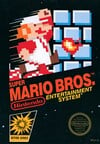 NES |
Super Mario Bros. is the first entry of this series. In the story, Mario and his brother Luigi set out on an adventure across the Mushroom Kingdom to rescue Princess Toadstool and the mushroom retainers from the villainous King Bowser. Super Mario Bros. was the best-selling video game for the NES in 1999[2] and, until being surpassed by Wii Sports in 2009, the best-selling video game of all time. Super Mario Bros. also had a major part in both the takeoff of the NES and the revival of the American video game industry after the video game crash of 1983, and earned Mario a permanent position as Nintendo's mascot. |
| Super Mario Bros.: The Lost Levels | |
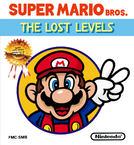 Disk System |
After the success of Super Mario Bros., a sequel was released one year later in Japan for the Family Computer Disk System. It uses a slightly altered version of Super Mario Bros.' engine, with different levels and new features including altered graphics, original obstacles such as the Poison Mushroom and wind, and five bonus worlds.
While the game was titled Super Mario Bros. 2 in Japan, Nintendo of America originally deemed it too challenging and too much like the original to sell well internationally.[3] Instead, another game was released as Super Mario Bros. 2 outside of Japan, and the Japanese Super Mario Bros. 2 became known as Super Mario Bros.: The Lost Levels when included in the Super Mario All-Stars remake years later. The first release of the original game outside Japan was its Virtual Console release in 2007. |
| Super Mario Bros. 2 | |
 NES |
Owing to Nintendo of America's decision to not release the Japanese Super Mario Bros. 2 outside Japan, the company instead altered the game Yume Kōjō: Doki Doki Panic, which was otherwise never released outside Japan, to replace the main characters with Mario, Luigi, Princess Toadstool, and Toad, releasing this version of the game as Super Mario Bros. 2 outside Japan. This game was released in Japan a few years later as Super Mario USA.
Several enemies first featured in this game, such as Shy Guys, Bob-ombs, and Birdo, would go on to become recurring in the franchise. Super Mario Bros. 2 is also the first game in the series to feature four distinct playable characters, as Mario, Luigi, Princess Toadstool, and Toad must save the dream world of Subcon from the villainous Wart. After fighting their way through seven worlds, they eventually save Subcon, and Mario wakes up from his dream. |
| Super Mario Bros. 3 | |
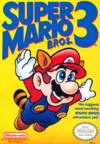 NES |
Super Mario Bros. 3 was the final Super Mario platformer released for the NES. It was the most expansive Super Mario game on the system, featuring 88 levels, four new power-ups (its flagship one being the Super Leaf, granting Mario his flying Raccoon form), and introducing elaborate world maps, becoming a huge critical and commercial success. Many of the new species would become staples of the series, including Boos, Fire Piranha Plants and Dry Bones. The plot follows Mario and Luigi traversing through eight distinctly-themed worlds to rescue Princess Toadstool and defeat Bowser and the debuting Koopalings, who have turned all the kings of the Mushroom World into various animals. |
| Super Mario Land | |
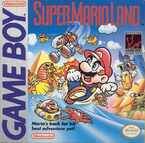 Game Boy |
Super Mario Land is the first portable Super Mario game, and the first one not developed by Nintendo EAD but rather its partner division, Nintendo R&D1. The game features a similar aesthetic and gameplay to Super Mario Bros., adapting it to the limited technology of the Game Boy at the time. This installment has Mario venture through the four kingdoms of Sarasaland to rescue its ruler, Princess Daisy, from the evil alien Tatanga. This game is unique in that it features auto-scrolling shooting sections where Mario rides a submarine or a plane.
Although Super Mario Land and its sequel, Super Mario Land 2: 6 Golden Coins, were originally excluded from the main Super Mario series, they were included alongside the more traditional games in material for the 30th and 35th anniversaries of Super Mario Bros.,[4] and the history page from the Mario Portal and "The official home for Mario" websites.[5][6] |
| Super Mario World | |
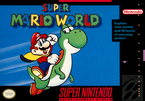 SNES |
Super Mario World, the sixth game in the series, was a launch title for the Super Nintendo Entertainment System, representing the series' leap from 8-bit to 16-bit graphics. Its plot is largely similar to past games, but places the characters on the new setting of Dinosaur Land. Super Mario World is notable for featuring a highly detailed and interconnected world map, and introducing the Cape Feather power-up. Its main contribution to the franchise, however, is the debut of the Yoshi species, who became popular enough to receive their own line of games. |
| Super Mario Land 2: 6 Golden Coins | |
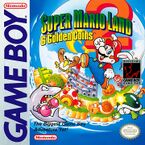 Game Boy |
A sequel to the original Super Mario Land, Super Mario Land 2: 6 Golden Coins features aesthetics and gameplay reminiscent of Super Mario World. Directly following the ending of the predecessor, Mario discovers that Wario has seized his realm of Mario Land and taken control of his castle by scattering his six Golden Coins, which Mario must retrieve to have access to the castle. Aside from introducing Wario to the greater Super Mario universe, the ideas of Super Mario Land 2 have remained largely contained to this game. |
| Super Mario 64 | |
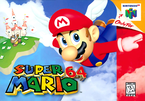 Nintendo 64 |
Super Mario 64 was a launch title for the Nintendo 64, and the eighth Super Mario game. As the first fully three-dimensional title in the series, it is regarded as one of the most important games of all time, and has sold over eleven million copies worldwide as of 2015.[7] This was also the second game to call Princess Peach by her current name (with Yoshi's Safari being the first). In the game, Mario is invited to the Mushroom Castle to have cake with Peach, but soon discovers that Bowser has taken the castle over and stolen its Power Stars. By jumping into paintings and surfaces around the castle, Mario gains access to self-contained courses that he can explore for Power Stars. Super Mario 64 heavily expands Mario's moveset: he is given a punch attack and several stunts that became series staples, such as the Ground Pound and the Wall Jump. |
| Super Mario Sunshine | |
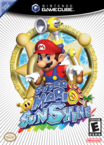 GameCube |
Super Mario Sunshine was the second 3D Super Mario platformer, and the ninth title overall. The game follows Mario and his new companion F.L.U.D.D. in the tropical vacation destination of Isle Delfino, where Peach is threatened by a Mario doppelganger, who has also framed him for polluting the land with goop and bringing darkness upon it. This impostor is later revealed to be Bowser Jr., Bowser's son and a constant presence in the series from this point on. The gameplay revolves around the use of F.L.U.D.D., a versatile water pack, to optimize Mario's movement and interact with enemies and stage elements. Super Mario Sunshine is currently the only Super Mario game to feature full voice acting for cutscenes. |
| New Super Mario Bros. | |
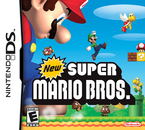 Nintendo DS |
New Super Mario Bros. is the tenth installment in the Super Mario series, and the first since Super Mario World to feature the classic 2D playstyle of the Super Mario Bros. games, substantially building upon it. The title features a solo story mode with Mario or Luigi, a two-player wireless game called Mario vs. Luigi, and a minigame mode for up to four players. It introduced various enemies and obstacles to the franchise alongside new power-ups: the Mega Mushroom, Mini Mushroom, and Blue Shell. New Super Mario Bros. received three sequels, forming their own subset of Super Mario games. |
| Super Mario Galaxy | |
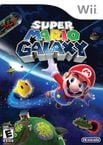 Wii |
Super Mario Galaxy is the eleventh installment in the Super Mario series and its third 3D game. It is themed around space travel, and diverges from past 3D games by being much more linear in level design. In the story, Mario attends the Star Festival at the request of Princess Peach, when the town comes under attack by Bowser's air forces. He abducts Peach's entire castle and warps it to the center of the universe, prompting Mario to save her. Most of the game's levels consist of many small planets and planetoids; Mario's interaction with gravity, a new spin ability and the independently controlled Star Pointer are new and important aspects of the gameplay. New power-ups this time include the Bee, Boo and Spring Mushrooms. Super Mario Galaxy has a hub area in the Comet Observatory, home of the Lumas and Rosalina, who have since gained prominence in the franchise. |
| New Super Mario Bros. Wii | |
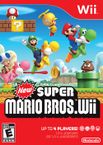 Wii |
Being the indirect follow-up to New Super Mario Bros. for the DS, New Super Mario Bros. Wii adapts that game's format to a home console experience. This installment was the first to allow for four players to simultaneously control their characters, a feature Shigeru Miyamoto had wanted for years. In the story, Bowser and his minions kidnap Peach by using cake as a disguise, so Mario, Luigi, Yellow Toad and Blue Toad set off to rescue her. This game sees the return of the Koopalings in their first 3D models, absent since Mario & Luigi: Superstar Saga, as well as rideable Yoshis, which this time are limited to designated stages. The Penguin Suit and the Propeller Mushroom are new power-ups in this game. |
| Super Mario Galaxy 2 | |
 Wii |
Super Mario Galaxy 2 is the thirteenth installment in the Super Mario series, its fourth 3D game and a direct sequel to Super Mario Galaxy. It borrows most of its gameplay from its predecessor, streamlining it to fit a simpler narrative. Instead of an elaborate hub area, this game utilizes a world map similar to the side-scroller games. Yoshi returns as a rideable item, and now can use power-ups designed for him: the Blimp Fruit, the Dash Pepper and the Bulb Berry. Mario also receives new power-ups in the Cloud Flower and the Rock Mushroom. |
| Super Mario 3D Land | |
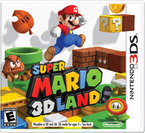 Nintendo 3DS |
Super Mario 3D Land is the fifth 3D game in the series and the fourteenth game overall. Super Mario 3D Land is a hybrid game described as a "3D game that plays like a 2D game," and therefore its levels are much more linear and compact than in the other 3D titles, more along the lines of the side-scrolling games. This title served as a showcase of the stereoscopic 3D feature of the Nintendo 3DS, and as such several bonus areas are specifically designed to be played with that feature on. Another theme is the returning Super Leaf item (which now grants Mario his Tanooki form), and the Boomerang Flower is a new item. |
| New Super Mario Bros. 2 | |
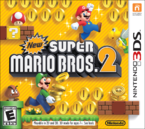 Nintendo 3DS |
New Super Mario Bros. 2 is the third game in the New Super Mario Bros. line and a direct sequel to New Super Mario Bros. The game's main focus is coins, with the primary goal being to collect one million of them. For this purpose, levels feature a high amount of coins and several forms of generating them, including the new power-up, the Gold Flower. New Super Mario Bros. 2 notably borrows most of its graphics, music and assets from New Super Mario Bros. Wii, while also featuring some elements from classic games, such as Raccoon Mario from Super Mario Bros. 3 and Reznor from Super Mario World. A side mode, Coin Rush, included the first instance of downloadable content in a Super Mario game. |
| New Super Mario Bros. U | |
 Wii U |
New Super Mario Bros. U was released as a launch title for the Wii U, the sixteenth Super Mario series game, and the first one to be released in high-definition. In this game, Bowser takes over Peach's castle and launches Mario, Luigi and the Toads across the Mushroom Kingdom, forcing them to make their way back while battling Bowser Jr. and the Koopalings once again. It plays very similarly to New Super Mario Bros. Wii, including its four-player mode—however, a player with a Wii U GamePad can create platforms in what Nintendo refers to as "Boost Mode." A single-player Challenge Mode is also featured. Several elements of this game pay homage to Super Mario World: its continuous world map, Baby Yoshis, and returning enemies such as Sumo Bros and Bony Beetles, among others. The Super Acorn is the new power-up of the game, with which Mario can become Flying Squirrel Mario. |
| Super Mario 3D World | |
 Wii U |
Super Mario 3D World is the home console follow-up to Super Mario 3D Land. The game's main feature is the new Cat form, caused by picking up a Super Bell, alongside four-player simultaneous multiplayer. Other new power-ups include the Double Cherry and the Lucky Bell. It features the entire playable cast of Super Mario Bros. 2 as playable characters, including the same abilities they have in said game, as well as Rosalina as an unlockable playable character. The story follows Mario, Luigi, Princess Peach, and Toad as they attempt to rescue the Sprixie Princesses that Bowser has captured and free the Sprixie Kingdom. |
| Super Mario Maker | |
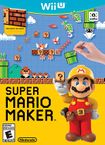 Wii U |
Super Mario Maker features a game creation system that allows players to create their own 2D Super Mario levels. Players can choose between four different styles based on Super Mario Bros., Super Mario Bros. 3, Super Mario World, and New Super Mario Bros. U for their levels, each adapting certain mechanics and power-ups exclusive to the original games. Level creations could be submitted to the internet so players could share their levels worldwide. Super Mario Maker was released on time for the series' 30th anniversary. |
| Super Mario Run | |
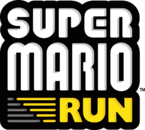 December 15, 2016 iOS |
Super Mario Run is an auto-runner platform game and the first dedicated Super Mario title for mobile devices. It was released first on iOS in December 2016, and it was released for Android in March 2017. The game is free-to-start, with optional in-app content to purchase at a one-time fee. Its gameplay is similar to that of the New Super Mario Bros. subseries but with a different control style. Like Super Mario 3D World, it features the cast of Super Mario Bros. 2 as playable characters, alongside Yoshi, Toadette, and Princess Daisy, who all make their first fully playable appearances in a 2D Super Mario game. |
| Super Mario Odyssey | |
 October 27, 2017 Nintendo Switch |
Super Mario Odyssey released for the Nintendo Switch in late 2017, and is the twenty-first game in the series. As a new entry in the 3D games and a new sandbox-style 3D Super Mario game after Super Mario 64 and Super Mario Sunshine, it focuses on Mario and a new character named Cappy (who takes the form of the Mario Cap) visiting kingdoms far from the Mushroom Kingdom and collecting Power Moons, ultimately in an attempt to prevent Bowser force-marrying Princess Peach and to rescue Cappy's sister Tiara. Cappy has multiple uses, such as being thrown like a boomerang (which can be used to control life forms and inanimate objects) and jumping off him in midair like a platform. In addition, this is the first main Super Mario game to be compatible with amiibo, and it was launched alongside a trio of amiibo based on the game. |
| Super Mario Maker 2 | |
 June 28, 2019 Nintendo Switch |
Super Mario Maker 2 is the sequel to the Wii U title Super Mario Maker. This sequel introduces many new additions and improvements, such as slopes, more level themes, and a Super Mario 3D World style. |
| Super Mario Bros. Wonder | |
 October 20, 2023 Nintendo Switch |
Super Mario Bros. Wonder is the twenty-third Super Mario game, a side-scroller and the successor to the New Super Mario Bros. line. Its plot involves Mario and his allies setting out to save the Flower Kingdom from Bowser. The game plays similarly to the New Super Mario Bros. subseries with its four-player mode. The game's central mechanic is Wonder Effects, temporary world-changing events that are triggered by collecting Wonder Flowers. Another notable debuting feature is a badge system that allows players to customize gameplay with additional abilities. It also introduces three new power-ups: the Elephant Fruit, Bubble Flower, and Drill Mushroom.
This is the first game to feature Kevin Afghani succeeding Charles Martinet in voicing Mario and Luigi. |
Related games
These original games are related to the Super Mario series while not being considered part of it by official Nintendo websites. Several of them feature the adventures of characters other than Mario, sometimes leading into their own series. Notably, Shigeru Miyamoto stated that he considered Super Mario World 2: Yoshi's Island to be part of the core Super Mario franchise in an interview published in 2012.[8]
| Title | |
|---|---|
| Cover, original release and system | Synopsis |
| Mario Bros. | |
 Arcade machine |
Mario Bros. is an arcade game where Mario and Luigi must defeat various enemies while plumbing. The game introduces various mechanics that would later appear in Super Mario games such as coins, Warp Pipes, and POW Blocks. Shellcreepers would serve as inspiration for Koopa Troopas in later games, and Fighter Flies would reappear in Super Mario Land. The game is also recreated in various Super Mario games and other related reissues. Super Mario Bros. 3 has a 2 Player Game mode that is a recreation of it. This version of the game replaces the Shellcreepers with Spinies, presumably to avoid confusion of players jumping on them, similar to Koopas. Super Mario All-Stars's remake of the aforementioned game contains a version of the 2 Player Game that can be played from the start. Another remake of it appears in all the Super Mario Advance games. An edited version of the NES version, Luigi Bros., appears in Super Mario 3D World. A platform inspired by the one that the Mario Bros. used to flip enemies upside down would appear in New Super Mario Bros. and New Super Mario Bros. U. It is also referenced in other Super Mario games. In New Super Mario Bros.'s Mario Vs. Luigi mode, the jingle that plays when one of the brothers spawns out of the pipe is the same one that plays when they respawn in the original game. In New Super Mario Bros. Wii the Coin Battle course, World |
| Super Mario Bros. Special | |
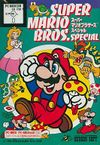 NEC PC-8801, Sharp X1 |
Super Mario Bros. Special is a game made by Hudson Soft and licensed by Nintendo for the NEC PC-8801 and Sharp X1 series of Japanese PCs, and later released in South Korea for the Samsung SPC-1500 in 1987. Super Mario Bros. Special is the second sequel to Super Mario Bros., released a few months after Super Mario Bros.: The Lost Levels in 1986. While superficially very similar to the original Super Mario Bros., the game features original levels but scrolls screen-by-screen rather than smoothly. Jumping and running physics also differ from the original, providing a more challenging experience than Super Mario Bros. Due to the computers' technology being slightly inferior to that of the NES/Famicom, the graphics and audio differ from the original NES game as well, with the X1 utilising more colors and smoother scrolling than the PC-88, and does not include Luigi or a multiplayer mode. |
| Yume Kōjō: Doki Doki Panic | |
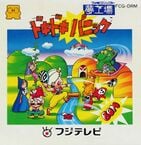 Family Computer Disk System |
Yume Kōjō: Doki Doki Panic started development as a vertically scrolling Super Mario Bros.-style game, eventually gaining horizontal scrolling as well to be more similar. Due to a licensing agreement with Fuji Television, it starred a family of Arabian characters owned by the network. This game would go on to become the western Super Mario Bros. 2, with the Arabian characters replaced with Mario and friends, though other characters (namely enemies and bosses) remaining; many would become recurring to the series. |
| Wario Land: Super Mario Land 3 | |
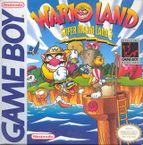 Game Boy |
Wario Land: Super Mario Land 3 is the third and final original Super Mario Land title and the first installment in the Wario Land series, released in 1994, five years after its first predecessor and two years after its second predecessor. Taking place after his defeat in Super Mario Land 2: 6 Golden Coins, Wario decides to go on a quest to earn himself enough money and riches to get himself a castle of his own. During his quest, he finds many treasures as he battles Captain Syrup and her army, the Black Sugar Gang. The gameplay in Wario Land differs slightly from the previous Super Mario Land installments. For example, if the player holds down the B button, then Wario does not run. His speed does increase, however, if Wario is using the Jet Wario power-up, which allows him to temporarily fly through the air at super speed. His other power-ups include Bull Wario, which gives him super strength and the ability to stick to ceilings and conveyor belts, and the Dragon Wario power-up, which allows him to breathe fire. Wario is also able to hold and throw enemies (as well as coins, which are usually required to exit a stage). |
| Super Mario World 2: Yoshi's Island | |
 SNES |
While the title suggests it being a sequel to Super Mario World, Super Mario World 2: Yoshi's Island is in fact the prequel not only to the Super Mario series but the chronological first game of the whole Super Mario franchise. The game starts off on the day the Mario Bros. were born and are to be delivered to their parents by a dedicated stork. Foretelling the threat they will represent to the Koopa clan in the future, Kamek tries to kidnap the babies from the stork but only manages to snatch one baby (Baby Luigi) and imprisons the stork as well. The other baby (Baby Mario) falls on Yoshi's Island where he is picked by the Yoshis that reside in there. The Yoshis come to the decision to aid the baby to rescue his brother and the stork from the Koopa clan led by the young Baby Bowser. |
| 1-Up Hunt! | |
2006 Adobe Flash |
New Super Mario Bros. 1-Up Hunt! was an online advergame developed in Adobe Flash and published by Nintendo to promote New Super Mario Bros., first released in 2006 for the Nintendo DS. It was playable on the Nintendo Arcade section of nintendo.com, which featured many other web advergames published by Nintendo.[9] The game is currently lost, as no archives have been found. |
| New Super Luigi U | |
 Wii U |
New Super Luigi U is an additional content pack for New Super Mario Bros. U that was also released as a stand-alone game to celebrate the Year of Luigi, available at retail until the end of the 2013. It has all-new levels and Luigi supplants Mario as the lead character, with Nabbit becoming the fourth playable character, taking Mario's place. |
| Captain Toad: Treasure Tracker | |
Wii U |
Captain Toad: Treasure Tracker is a puzzle-platform game, a spin-off and prequel of Super Mario 3D World based on Captain Toad's Adventures stages from the latter but featuring extensive depth and variety. The game also features Toadette as a new playable character, but also takes the role of damsel-in-distress. A port was released on July 13, 2018 for the Nintendo Switch and Nintendo 3DS, which replaces the bonus stages based on Super Mario 3D World with stages based on kingdoms from Super Mario Odyssey. |
| Super Mario Bros. 35 | |
 October 1, 2020 Nintendo Switch |
Super Mario Bros. 35 was a side-scrolling, battle royale platform game where 35 players competed against each other until one player remained standing. |
Reissues and compilations
| Title | |
|---|---|
| Cover, original release and system | Synopsis |
| VS. Super Mario Bros. | |
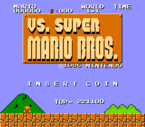 VS. System |
VS. Super Mario Bros. is a two-player arcade game released in North America in 1986. The game is mostly the same as the original Super Mario Bros.; Mario or Luigi went on a quest to save the princess from Bowser and restore order to the Mushroom Kingdom. The game is made harder than Super Mario Bros. in that it had fewer warp zones and more enemies, along with options for the arcade owner to make it more difficult still and thus restrict the time an average player got for their money. The game replaced "duplicate" levels from the original with levels which would later be used in the Japanese Super Mario Bros.: The Lost Levels. |
| Super Mario Bros. (Game & Watch) | |
 Game & Watch |
In 1986, one year after the release of Nintendo's first biggest commercial success, the company released a simplified version of the game on their Game & Watch system. It essentially has the same plot, reduced down to only eight levels; however, after beating every level, they will have to be repeated. Mario will have to go through nine loops, avoiding Lakitus and Bullet Bills, each time with the levels increasing in difficulty. There are also two types of levels: scroll screen levels, in which Mario will have to reach a certain point to advance, and timer screen levels, in which Mario must get through the world in a given amount of time. Additionally, another difference between the original and this remake is that Mario will find Princess Toadstool at the end of every level, without having to fight a boss. |
| All Night Nippon: Super Mario Bros. | |
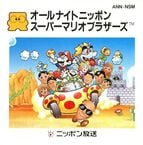 Disk System |
All Night Nippon: Super Mario Bros. is an officially licensed hack of Super Mario Bros.: The Lost Levels. Gameplay is the same, but many characters such as the mushroom retainers are replaced with Japanese celebrities from the radio show All Night Nippon. Other changes are also made for this game, such as World 1 being set during nighttime and Princess Peach's outfit was changed. The game was only released in Japan. |
| Super Mario Bros. (Nelsonic Game Watch) | |
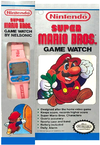 Nelsonic Game Watch |
Super Mario Bros. is a simplified version of the original game released on the Nelsonic Game Watch. The instruction leaflets for these watches contain many spelling errors and inconsistent terminology. Mario has to struggle up a castle to rescue the princess and defeat the Koopa Dragon. |
| Super Mario Bros. 3 (Nelsonic Game Watch) | |
 Nelsonic Game Watch |
[[Super Mario Bros. 3 is a direct sequel to the previous watch and a tie-in product to the North American release of the original game. It is also known as Super Mario 3 and Super Mario III. This installment contains the Super Leaf, which transforms Mario into long tail Mario. |
| Super Mario World (Nelsonic Game Watch) | |
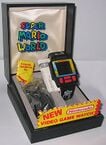 Nelsonic Game Watch |
The Super Mario World game watch is also a tie-in product for the North American release of the original game. This sequel is also known as Super Mario Bros. 4 and Super Mario 4. Mario rides a dinosaur to rescue the princess from Koopa. |
| Super Mario All-Stars | |
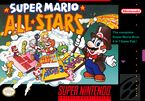 SNES |
Super Mario All-Stars, known as Super Mario Collection in Japan, was released in 1993 also for the Super Nintendo Entertainment System. It is a compilation featuring 16-bit versions of the first four main Super Mario series games: Super Mario Bros., Super Mario Bros. 2, Super Mario Bros. 3 and, in its first release outside of Japan, Super Mario Bros.: The Lost Levels. This game updated the four games' graphics and sound to enhance them, with certain changes to the mechanics. A Wii rerelease, called Super Mario All-Stars Limited Edition, occurred in 2010. |
| Super Mario All-Stars + Super Mario World | |
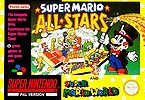 SNES |
Super Mario All-Stars + Super Mario World is an America/Europe-only reissue of Super Mario All-Stars that also includes Super Mario World for the Super Nintendo Entertainment System. |
| BS Super Mario USA | |
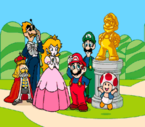 Satellaview |
A follow-up to Super Mario USA (Super Mario Bros. 2), BS Super Mario USA was released as four installments, and each one involved the player heading into each world to collect a gold Mario statue and defeat the bosses until finally reaching and defeating Wart. Each level could be replayed until the clock reached 50 minutes. As the player progressed, St. Giga's Satellite radio would stream an audio drama to tell the story. After the events of Super Mario Bros. 2, the King of Subcon had golden Mario statues put up all around Subcon, to thank him and his friends for their deeds. However, three Birdos, Mouser, Tryclyde, Fryguy and Clawgrip have stolen them, and now Mario must get them back and defeat Wart again. |
| BS Super Mario Collection | |
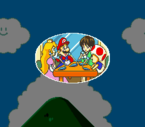 Satellaview |
A remake of Super Mario Collection (Super Mario All-Stars), BS Super Mario Collection is a game for the Super Famicom add-on Satellaview. Like with BS Super Mario USA, as the player progressed through the game, voice acting and music would be streamed to the system using the Satellaview's Soundlink capabilities. |
| Super Mario Bros. Deluxe | |
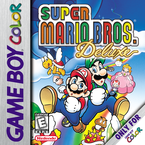 Game Boy Color |
Super Mario Bros. Deluxe is a Game Boy Color remake which includes the first two Super Mario games ever released: Super Mario Bros. and Super Mario Bros.: The Lost Levels (that last under the name of Super Mario Bros. for Super Players). Besides those games, it also featured many other collectibles, including images that could be printed with the Game Boy Printer, Cable Link interface multi-player, records sharing by infrared connection, a calendar, a fortune teller, etc. Unlike other remakes, it was not developed by Nintendo EAD, but rather by Nintendo R&D2. |
| Super Mario Advance | |
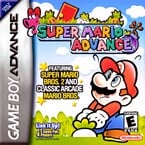 Game Boy Advance |
Super Mario Advance is a remake of Super Mario Bros. 2 made for the handheld game system, the Game Boy Advance, and released in 2001. Like the Super Mario All-Stars remake, Super Mario Advance had updated graphics, alongside various gameplay additions and improvements such as a points scoring system and collectable Ace Coins. Additionally, Mario Bros. is included with the game. It spawned a series of similar remakes, all featuring Mario Bros. as well. |
| Super Mario World: Super Mario Advance 2 | |
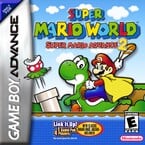 Game Boy Advance |
Super Mario World: Super Mario Advance 2 is a remake of Super Mario World made for the Game Boy Advance. It is the second title in the Super Mario Advance series and was released in 2002. There are various differences between the original Super Mario World and Super Mario Advance 2 such as Luigi's sprite being changed and made taller than Mario to match his normal appearance. The game was a gigantic hit for Nintendo and the Game Boy Advance, selling 3,290,000 copies in North America and 5,460,000 copies worldwide. |
| Yoshi's Island: Super Mario Advance 3 | |
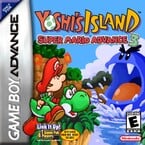 Game Boy Advance |
Yoshi's Island: Super Mario Advance 3 is a remake of Super Mario World 2: Yoshi's Island for the Game Boy Advance. The game features similar visuals to the original game, though due to the lack of the Super FX chip, the game tracks behind some graphical aspects. Super Mario Advance 3 has six new levels and Yoshi's Story voice acting and sound effects. |
| Super Mario Advance 4: Super Mario Bros. 3 | |
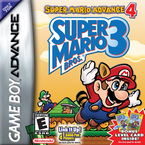 Game Boy Advance |
In 2003, the fourth (and final) Super Mario Advance installment, Super Mario Advance 4: Super Mario Bros. 3, was released for the Game Boy Advance. It boasted similar graphics and sound to the Super Mario All-Stars version of Super Mario Bros. 3, and made use of the e-Reader. A few e-Reader cards came included with new copies of the game, while two sets (referred to as "series") of cards, were released and sold alongside the game. By scanning special cards into the e-Reader, players were able to upload items, videos, and most importantly, new levels into the game. One notable item was the Cape Feather from Super Mario World, which allowed Mario to transform into Caped Mario. There were also two Switch cards that the player could activate (and deactivate) the effects of by scanning them; the Orange Switch and the Blue Green Switch. Scanning these switches triggered small functions in the game. The e-Reader feature is still coded in the European version, but is disabled by default. The Virtual Console and Game Boy Advance - Nintendo Switch Online versions would feature all e-Reader levels and features unlocked by default for all regions. |
| Classic NES Series: Super Mario Bros. | |
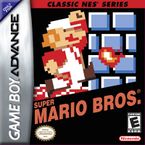 Game Boy Advance |
The original NES version of Super Mario Bros. was released for the Game Boy Advance as part of the Classic NES series of games in commemoration for the 20th anniversary of the release of the original Famicom and NES. It is a direct port, and as a result features no new additions or bugfixes. Consequently, the only significant difference is that the graphics were downscaled to fit the GBA screen resolution. |
| Famicom Mini: Super Mario Bros. 2 | |
 Game Boy Advance |
In Japan, the Classic NES Series were known as Famicom Mini. The original Super Mario Bros. 2 (or Super Mario Bros.: The Lost Levels) was released only in Japan. Much like Super Mario Bros., it didn't feature any new additions, the bugs were left untouched, and the graphics were down-scaled. |
| Super Mario 64 DS | |
 Nintendo DS |
Super Mario 64 DS is a remake of Super Mario 64. It was released in 2004 for the Nintendo DS. It is also the first Mario game released for the Nintendo DS. Though it is a remake, there are many differences between it and the original (four playable characters and 30 new Power Stars are two examples of this). The game begins the same as the old one; Peach invites Mario to the castle for cake. However, instead of just Mario, Wario and Luigi come for cake, while Yoshi sleeps on the roof of the castle. Bowser then takes over the castle, captures Peach, and locks Mario, Luigi, and Wario inside three rooms. Lakitu then wakes Yoshi up, and now he has to save Mario and the others in order to save the princess once again, this time through teamwork. |
| Super Mario All-Stars Limited Edition | |
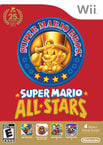 Wii |
Released for the Wii in 2010, Super Mario All-Stars Limited Edition is a port of Super Mario All-Stars that celebrates the 25th anniversary of Mario. |
| New Super Mario Bros. U + New Super Luigi U | |
 Wii U |
A compilation of both New Super Mario Bros. U and New Super Luigi U on the same disc, initially released exclusively with the Mario & Luigi Deluxe Wii U set (known as the Premium Pack in Europe). New Super Mario Bros. U + New Super Luigi U includes notable changes to the originals, including a new title screen and over 200 videos included as bonus content. This compilation was released separately as a Nintendo Selects title in 2016. |
| Super Mario Maker for Nintendo 3DS | |
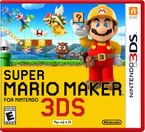 Nintendo 3DS |
A port of Wii U's Super Mario Maker released in 2015, Super Mario Maker for Nintendo 3DS was released on December 2, 2016. Despite being a Nintendo 3DS title, the game does not support stereoscopic 3D, and gameplay is, therefore, strictly available in 2D. Due to hardware limitations for the 3DS, players can no longer share their levels online, and other elements from the Wii U version, like the Mystery Mushrooms and amiibo compatibility, have been removed. The game features Super Mario Challenge, a single player mode with 100 pre-installed courses designed by Nintendo, with medal objectives included for each course. |
| New Super Mario Bros. U Deluxe | |
 January 11, 2019 Nintendo Switch |
New Super Mario Bros. U Deluxe is a combined port of the Wii U games New Super Mario Bros. U and New Super Luigi U, enhanced with exclusive features. Notably, this port is described as part of the main series for the Super Mario Bros. 35th Anniversary and in the Mario history section of Nintendo's website.[6] |
| Super Mario 3D All-Stars | |
 September 18, 2020 Nintendo Switch |
Super Mario 3D All-Stars is a rerelease of Super Mario 64, Super Mario Sunshine, and Super Mario Galaxy with revamped controls, HD resolution, and a music player that released as part of the 35th anniversary of Super Mario Bros. |
| Game & Watch: Super Mario Bros. | |
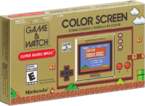 November 13, 2020 |
Unlike the Super Mario Bros. Game & Watch game released in 1987, Game & Watch: Super Mario Bros. is a direct port of Super Mario Bros. and Super Mario Bros.: The Lost Levels fit into a Game & Watch system with full-color screen display. The system also features a Super Mario-themed version of Ball. |
| Super Mario 3D World + Bowser's Fury | |
 February 12, 2021 Nintendo Switch |
Super Mario 3D World + Bowser's Fury is a port of the Wii U game Super Mario 3D World that released for Nintendo Switch in 2021. It contains new features, such as quicker movement speed, higher resolution, and amiibo compatibility. The game also has a new Bowser's Fury mode, in which Mario and Bowser Jr. aim to save Lake Lapcat from Fury Bowser. Like New Super Mario Bros. U Deluxe, the port is described as part of the main series in the Mario history section of Nintendo's website.[6] |
Canceled
| Title | |
|---|---|
| Cover, original release and system | Synopsis |
| Super Mario's Wacky Worlds | |
 Philips CD-i |
Super Mario's Wacky Worlds is a canceled Philips CD-i game developed by NovaLogic. It is thought to follow-up on Super Mario World after a Nintendo sales executive suggested that the CD-i could play simple Nintendo games,[10] which is a result of Philips acquiring the rights to several Nintendo characters for use on their platform. The game was to feature a game world mostly based on real-life Earth locations, with themed old and new enemies in the Super Mario World sprite style. However, despite NovaLogic impressing Nintendo with their work-in-progress, it was canceled due to the commercial failure of the CD-i.[10] |
| VB Mario Land | |
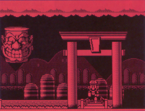 Virtual Boy |
VB Mario Land, also known as Mario Adventure,[11] was a canceled Virtual Boy game which was revealed at the Winter Consumer Electronics Show in early 1995.[12] A Wario-like object can be seen in one of the released screenshots, so it is thought to be an unproduced follow-up to Super Mario Land 2: 6 Golden Coins. The game was to use two-dimensional side-scrolling elements, as well as the use of three-dimensional movement between the background and foreground of the stage. Its three-dimensional Mario Bros.-style mini-game was repurposed as Mario Clash.[13] |
| Super Mario 64 2 | |
 Nintendo 64DD |
Super Mario 64 2, the direct sequel to Super Mario 64, is a canceled Nintendo 64DD game. Luigi[14] and a rideable Yoshi[15] were set to appear, which were ideas unused during the creation of the original game.[16] Shigeru Miyamoto has stated in 1999 that the game's actual development only got as far as a two player demo level featuring Mario and Luigi.[17][better source needed] An unreleased port of Super Mario 64 to the 64DD demoed at Space World 1996, known as Super Mario 64 Disk Version, may be related.[18] |
Major characters
It has been requested that this section be rewritten. Reason: Some flowery writing; supporting characters should be more descriptive
Main protagonists
| Character | |||
|---|---|---|---|
| Image | Brief biography | First appearance | First playable appearance in the Super Mario series |
| Mario | |||
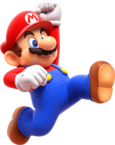 |
Mario is the main protagonist in his titular series of games. Mario is the star of the largest game franchise Nintendo has published. Many characters have fought alongside Mario in his adventures in platformers and RPGs, but many have also fought against him during those times. Mario has gone through many physical changes, from his original 8-bit appearance, to his current 128-bit appearance. Mario commonly rescues Princess Peach, as well as several others, such as Toads, as his adventures continue. Mario has even been accepting enough to team up at times with his greatest foe, Bowser. | ||
| Luigi | |||
 |
Luigi is Mario's taller, younger, twin brother. Luigi first debuted in Mario Bros. for the Game & Watch in 1983, packaging off bottles alongside Mario as a factory worker, before reappearing in the arcade game Mario Bros. and later in Super Mario Bros. for the NES, playable only in the two-player mode of the game. He later appeared in Super Mario Bros. 2, being playable in one-player mode for the first time along with Toad and Peach. Luigi has appeared in many of Mario's games, but there were some from which he was excluded — among which are Super Mario Land and Super Mario 64. | ||
| Princess Peach | |||
 |
Princess Peach — originally "Princess Toadstool" in localization — is the damsel-in-distress of the series. Princess Peach is the ruler of the Mushroom Kingdom, and is protected by many Toads. However, her protection commonly fails and eventually results in her being kidnapped, be it by Bowser, or by another villain. In Super Mario Bros. 2, Super Mario 3D World, Super Mario Run, and Super Mario Bros. Wonder, Peach is one of the playable characters and one of the main protagonists. | ||
| Princess Daisy | |||
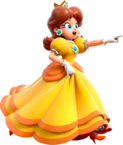 |
Princess Daisy initially served as the damsel-in-distress in her debut game, Super Mario Land. She is the ruler of the country Sarasaland which is inhabited by many various species not found in the Mushroom Kingdom. Although she is the only known ruler, her father was mentioned by her in Mario Party 3. She was kidnapped by the evil alien Tatanga who took her and hypnotized the inhabitants of Sarasaland. After Tatanga's defeat by Mario, Daisy was rescued and the Sarasaland kingdom was restored. Since Daisy's return to the Mario series overall (starting with the Nintendo 64 version of Mario Tennis), she has been a frequent participant in a majority of spin-off installments. 28 years after Super Mario Land, Daisy officially made her reintroduction in the Super Mario series by appearing in Super Mario Run as a playable protagonist. | ||
| Toad | |||
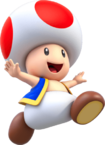 |
Toad originally played the role of Princess Peach's assistant; however, he has been reduced to lesser roles since his debut appearance, with his role in main games having sometimes been replaced by Toadsworth. His first playable appearance was in Super Mario Bros. 2. Though he appears identical to many others in his species, Toad is actually an entirely different character; this causes much confusion as to whether or not certain Toads are the Toad discussed. Similar confusion occurs regarding whether he is the same as the character resembling Blue Toad in Super Mario 3D World. | ||
| Yoshi | |||
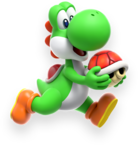 |
Yoshi is Mario's dinosaur-like companion and one of his most trusty allies during his adventures. In many games Yoshi is present, he is always disposed to give Mario a ride on his back; while riding him and under Mario's command, Yoshi can use his long chameleon-like tongue to swallow a diverse variety of objects, including enemies. Yoshi also supports additional abilities Mario is unable to do on his own like Yoshi's signature Flutter Kick. Super Mario 64 DS features Yoshi as a standalone playable character. In fact, the game opens with Yoshi as the sole playable character that needs to rescue Mario and co. Though he lacks power, he compensates this with his ability to swallow enemies and turn them into an egg, which in turn serves as a homing projectile to take out several enemies at once. In Super Mario Run and Super Mario Bros. Wonder, Yoshi is a standalone playable character, along with his colored species. | Super Mario 64 DS (as a fully playable character) | |
| Wario | |||
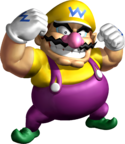 |
Wario is Mario's yellow-clad, greedy childhood friend and rival. Though he has antagonized Mario since his debut in Super Mario Land 2: 6 Golden Coins, Wario proved to be a valuable ally during the events of Super Mario 64 DS, where he, alongside Luigi, originally came to "crash the party" of Mario and Peach. Wario is the strongest character in the game, being able to destroy some obstacles the other character would have no choice but avoid them. | ||
| Rosalina | |||
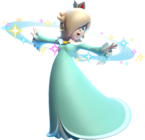 |
Rosalina makes her first overall Super Mario franchise appearance by playing a supporting role in Super Mario Galaxy. In that game (and its sequel), she is the adoptive mother of the Lumas. Her main duty is to watch the Lumas and help keep the galaxies safe. Throughout the Super Mario Galaxy installment, Rosalina gives helpful and important advice/tips to Mario on his journey to save the galaxies in crisis and rescue Peach from Bowser's capture.
Rosalina makes her first playable appearance for the Super Mario series overall in Super Mario 3D World, making her the second female protagonist, following Princess Peach. |
||
| Captain Toad | |||
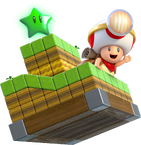 |
Captain Toad is a red Toad dressed with an oversized backpack and a headlamp, he is the leader of the Toad Brigade, a group of Toads that provides help to Mario in Super Mario Galaxy and Super Mario Galaxy 2. He subsequently appears in Super Mario 3D World as a playable character in special levels called Captain Toad's Adventures; additionally, this resulted in him getting the starring role in the game's prequel (Captain Toad: Treasure Tracker), along with Toadette. | ||
| Toadette | |||
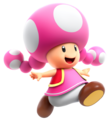 |
Toadette was originally introduced as a playable racing partner for Toad in Mario Kart: Double Dash!! She has since appeared in other games as a playable character and has played supporting roles in several titles. Her first prominent role in the series was in the Super Mario 3D World prequel Captain Toad: Treasure Tracker, where she played a main character the game's storyline. Toadette officially debuted in the Super Mario mainstream series by appearing in Super Mario Run as a referee and later becoming playable in the game. Toadette makes a return to the Super Mario series by playing a role in Super Mario Odyssey as an archivist for the Toad Brigade. Her most recent appearance for the mainstream Super Mario series is New Super Mario Bros. U Deluxe; during gameplay, she gains a unique Princess Peach-like form known as Peachette (after obtaining a Super Crown power up). She also makes an appearance in Super Mario Maker 2, where she is featured as one of the four playable characters alongside Mario, Luigi, and Toad. She is featured as a supporting character in the game's Story Mode, where she is called "Chief" and is in charge of rebuilding Princess Peach's castle after it is erased by Undodog. | ||
| Yellow Toad and Blue Toad | |||
 |
Yellow Toad and Blue Toad appear in New Super Mario Bros. Wii as main protagonists along with Mario and Luigi. They reprise the same role in New Super Mario Bros. U and Super Mario Bros. Wonder. In New Super Mario Bros. U Deluxe, they share a character slot under the name "Toad". | ||
| Nabbit | |||
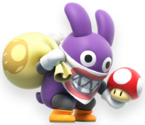 |
Nabbit debuted in New Super Mario Bros. U, where he steals items from Toad Houses. He appears as one of the four main playable characters in New Super Luigi U replacing Mario from the original game; unlike the other characters, he is invincible to enemies and cannot use power-ups (except for Super Stars), which instead become 1-Up Mushrooms at the end of the level. In New Super Mario Bros. U Deluxe, he can be played in the New Super Mario Bros. U levels for the first time (though he is not playable in Challenge Mode). | ||
Supporting characters
| Character | ||
|---|---|---|
| Image | Brief biography | First appearance |
| Kings | ||
| The kings are the rulers of seven kingdoms in Super Mario Bros. 3, were each was turned into a different creature by the Koopalings. | ||
| Lakitu Bros. | ||
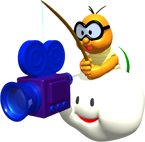 |
The Lakitu Bros. are a pair of cameraman Lakitus that monitor Mario's progress throughout Super Mario 64. One of them acts as the camera throughout the game and is thus never directly seen aside from areas in mirrors, and the other appears in the opening and gives information at the start of certain courses. | |
| Hoot | ||
 |
Hoot is a friendly owl from Whomp's Fortress in the game Super Mario 64. If Mario wakes him up, he will allow Mario to grab his feet to get a lift. In the remake, he also appears in all missions of Cool, Cool Mountain, and later missions of Snowman's Land, Tiny-Huge Island, and Tall, Tall Mountain. | |
| Dorrie | ||
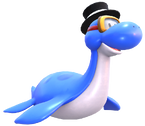 |
Dorrie is a large blue plesiosaur-like creature found in Hazy Maze Cave in Super Mario 64. He later appears in World 4 of New Super Mario Bros. In both games, ground pounding of his back will cause him to lower his head for Mario to climb upon; in the latter, he also briefly gains speed. | |
| Toadsworth | ||
 |
Toadsworth is an elderly Toad and Princess Peach's longtime steward where he comes along with Mario and Princess Peach to Isle Delfino. | |
| FLUDD | ||
 |
FLUDD, short for Flash Liquidizer Ultra Dousing Device, is Mario's partner in Super Mario Sunshine, and was invented by Professor E. Gadd. It is a sapient water-shooting apparatus that comes equipped with a hovering mechanism; this can be swapped out for turbo and rocket nozzles. FLUDD is used primarily to clean up the graffiti left around Isle Delfino by Shadow Mario. | |
| Baby Luma | ||
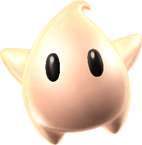 |
Baby Luma is Mario's main companion during the events of Super Mario Galaxy and its sequel Super Mario Galaxy 2. It differentiates from its brethren due to its unique beige coloration. | |
| Ray | ||
 |
Ray is a friendly Manta Ray in Super Mario Galaxy that Penguins ride for sport. Mario can also ride him at two points. | |
| Lubba | ||
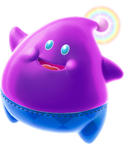 |
Lubba is a pudgy purple Luma and the head honcho of the Lumas in Super Mario Galaxy 2. | |
| Co-Star Luma | ||
 |
The Co-Star Luma is an orange Luma that can be controlled by a second player in Super Mario Galaxy 2 when in Co-Star Mode. However, its movement is normally limited to following Mario, although it is capable of immobilizing enemies and picking up items from afar. | |
| Fluzzard | ||
 |
Fluzzard is a large bird from Super Mario Galaxy 2 that is also quite shy. Mario can ride from his talons, similar to Hoot, but he only ever seems to glide. | |
| Cosmic Spirit | ||
 |
The Cosmic Spirit is an entity resembling both Rosalina and Cosmic Mario, although it is unknown if she has any connection to either of them. She can assist Mario by taking control of his body; however, any stars received will be bronze. She only appears in Super Mario Galaxy 2. | |
| The Chimp | ||
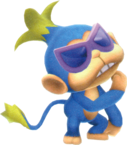 |
The Chimp is a rather competitive monkey from Super Mario Galaxy 2, who appears in many levels having set up challenges for Mario to beat. If Mario succeeds, he awards him a star. | |
| Sprixie Princesses | ||
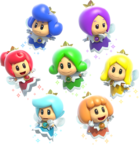 |
Sprixie Princesses are a group of seven characters from Super Mario 3D World. They act as the rulers of the Sprixie Kingdom and the Sprixies, a race of fairies who play a major role in the story. | |
| Plessie | ||
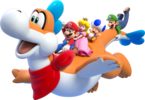 |
Plessie is a rideable dinosaur resembling both Yoshis and Dorrie. He helps the heroes by swimming rapidly through rivers with them on his back. | |
| Cappy | ||
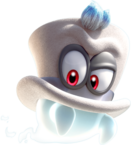 |
Cappy is Mario's main ally throughout the events of Super Mario Odyssey, and assists him in various ways. | |
| Pauline | ||
 |
Pauline was originally introduced as the original damsel-in-distress Mario had to rescue from Donkey Kong's clutches. Presented as Mario's girlfriend, this has long being retconned in her modern appearances that describe her simply as a close friend to Mario instead. Despite being the first female character introduced to the Super Mario franchise, it took her 36 years to finally appear in a mainstream Super Mario game in Super Mario Odyssey where she is presented as the mayor of New Donk City. | |
| Jaxi | ||
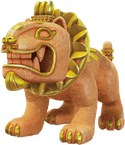 |
Jaxi is a living statue resembling both a lion and a jaguar that Mario can ride in Super Mario Odyssey. It destroys any breakable objects it touches, and defeats small enemies in the same way. | |
| Glydon | ||
 |
Glydon is a friendly globetrotting lizard found in Super Mario Odyssey who aspires to glide to and from all the highest places. If Mario captures him, he can use him to glide. | |
| Prince Florian | ||
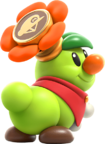 |
Prince Florian is the prince of the Flower Kingdom in Super Mario Bros. Wonder. He journeys with the heroes as a guide in their adventure to stop Bowser, and wears badges that bestow additional abilities upon them. | |
Main antagonists
| Character | ||
|---|---|---|
| Image | Brief Biography | First Appearance |
| Bowser | ||
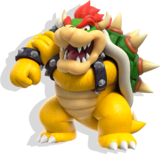 |
Bowser is the main antagonist throughout the Super Mario series, first appearing in Super Mario Bros. He is the King of all Koopas, and is found to be the final boss in almost all platformers. Commanding the Koopa Troop, Bowser sets to conquer the Mushroom Kingdom by kidnapping its rightful ruler, Princess Peach and holding her captive on his heavily guarded castle. He deploys a countless amount of minions to stop anyone that oppose him. Mario and Luigi have to traverse his castle in order to reach the final confrontation against Bowser. | |
| Wart | ||
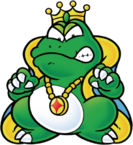 |
Wart is the main antagonist and final boss of Super Mario Bros. 2. He is leader of the 8 bits, an evil organization that set to conquer the land of dreams known as Subcon; to do so, Wart uses a device called the Dream Machine to create countless amounts of monsters. Wart has one weakness though, he is highly allergic to vegetables. Mario and co. use this to their advantage when they finally confront Wart. With vegetables provided oddly by the Dream Machine, Mario and co. are able to defeat Wart and free the Subcons that were imprisoned by him, bringing peace to Subcon. | |
| Tatanga | ||
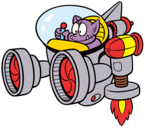 |
Tatanga is the main antagonist and final boss in Super Mario Land. Tatanga invaded the kingdom of Sarasaland with the intention of conquering it, he brainwashed its inhabitants to do his bidding and captured Princess Daisy to marry her. Using the Sky Pop, Mario eventually takes down Tatanga on the skies of the Chai Kingdom and finally rescues Princess Daisy. Tatanga comes back in Super Mario Land 2: 6 Golden Coins to serve as the boss of the Space Zone, where he has been entrusted by Wario with one of the 6 Golden Coins, so Mario has to battle him once more to retrieve it. | |
| Wario | ||
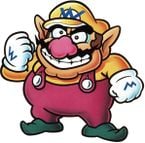 |
Wario made his debut on Super Mario Land 2: 6 Golden Coins as the main antagonist and final boss. It is explained by Mario that Wario has always been jealous of his popularity since they were kids and has tried to steal his castle several times. Wario was able to succeed when Mario was away to free Sarasaland from Tatanga's invasion. To prevent Mario from entering the castle, Wario scattered the 6 Golden Coins all over Mario Land and now are guarded by his underlings. Mario eventually recovers all the Golden Coins, enters his castle and confronts Wario in the throne room. Wario engages Mario in battle using several power-ups but despite his best efforts, he is ultimately defeated and flees. Wario would set to appear in other titles in the series, including many Super Mario spin-offs and even star his own series. | |
| Bowser Jr. | ||
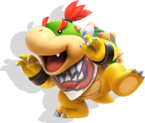 |
Bowser Jr. is Bowser's son and first appears as the main antagonist in Super Mario Sunshine where he took the persona of Shadow Mario. He has then appeared throughout the Super Mario series as one of the main bosses. He kidnapped Princess Peach who he thought she was his mother. He is the heir to the Koopa throne. | |
| Dry Bowser | ||
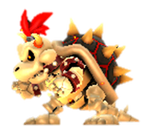 |
Dry Bowser is the undead and skeletal version of Bowser. He made his debut in New Super Mario Bros., where he came about as the result of Mario defeating Bowser by dropping him into lava at the end of New Super Mario Bros.'s first castle. However, both in New Super Mario Bros. 2 and Super Mario 3D Land, Dry Bowser appears even though Bowser isn't turned into a skeleton when he falls into the lava at the end of the final boss battles.[19][20] | |
Supporting antagonists
| Character | ||
|---|---|---|
| Image | Brief Biography | First Appearance |
| Fake Bowser | ||
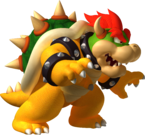 |
Fake Bowsers are members of the Koopa Troop that have been turned into copies of Bowser by his black magic. They are fought at the end of each castle, barring the final, in Super Mario Bros. and Super Mario Bros.: The Lost Levels. In Super Mario 3D Land, derivatives known as Tail Bowsers have spiky striped tails due to contact with a Super Leaf. However, they are less common in this game. | |
| Bowser's Brother | ||
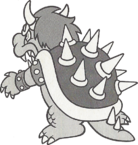 |
Bowser's Brother is the apparent twin of Bowser. He is distinct from fake Bowsers, as he does not transform upon defeat. He is also noted for his dark turquoise color, which was removed from the 16-bit version. There is a fake iteration of him as well in the 8-bit version. While certain materials interpret him as Bowser's actual sibling, various sources offer conflicting explanations. | |
| Birdos | ||
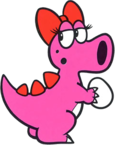 |
Birdo, along with other members of her species, work for Wart in Super Mario Bros. 2. They have funnel-shaped snouts from which they shoot projectiles. The pink ones shoot eggs, green and gray shoot fireballs, and red ones can shoot both. They can be defeated by throwing eggs back at them, or with Mushroom Blocks. They appear at the end of most levels. | |
| Mouser | ||
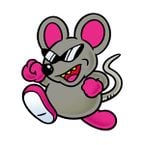 |
Mouser is a bomb-tossing rat with sunglasses from Super Mario Bros. 2. He can be beaten by throwing them back at him. A version with pink ears, gloves, and shoes appears in World 1 and a version with green details appears in World 3. A white one with red details appears in World 5 in Yume Kōjō: Doki Doki Panic, but it was deemed too difficult when it was being translated and was replaced with Clawgrip. Both Mousers appear identical in Super Mario All-Stars and Super Mario Advance. | |
| Triclyde | ||
 |
Triclyde is a large, 3-headed snake from Super Mario Bros. 2. Two of the heads spit fireballs; the only way to defeat him is with Mushroom Blocks. He appears in Worlds 2 and 6 in most versions of the game, but only in World 2 in Super Mario Advance. | |
| Boom Boom | ||
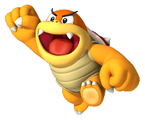 |
Boom Boom is one of Bowser's henchmen, and a frequently-fought mid-boss. He first debuted in Super Mario Bros. 3, where he battles Mario or Luigi in fortresses. Boom Boom then later made his return appearance in Super Mario 3D Land as one of the game's main antagonists who often appears in airships, along with his partner Pom Pom; he and his identically named species have returned in many games since. | |
| Koopalings | ||
 |
The Koopalings are introduced as Bowser’s children in Super Mario Bros. 3 and then considered Bowser's minions from New Super Mario Bros. Wii onwards. They are bosses in various games. Their names are Larry Koopa, Morton Koopa Jr., Wendy O. Koopa, Iggy Koopa, Roy Koopa, Lemmy Koopa and Ludwig von Koopa. | |
| Reznor | ||
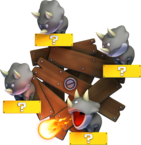 |
Reznor are fire-breathing Triceratops that made their debut in Super Mario World. According to the game's instruction manual, they were cursed by Bowser. They are mid-bosses that Mario and Luigi fight in fortresses found on Dinosaur Land. They are now found in the Mushroom Kingdom since their appearance in New Super Mario Bros. 2. Similar to how the Koopalings are named after various musicians, Reznor are named after Trent Reznor of the industrial rock band Nine Inch Nails. | |
| Kamek | ||
 |
Kamek is a powerful Magikoopa and apparent advisor to Bowser (or at least high-ranking member in the Koopa Troop), and the archenemy of Yoshi. He is the main antagonist in the Yoshi franchise while being one of the main bosses in the Super Mario series. | |
| Big Bob-omb | ||
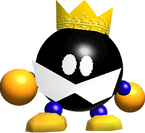 |
King Bob-omb, formerly Big Bob-omb, is a large Bob-omb with a crown, mustache, and no key. He first appeared in Super Mario 64, where he is the first boss. He is fought twice in the remake, and has appeared semi-frequently in spinoffs. | |
| Whomp King | ||
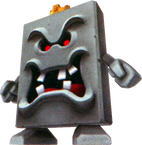 |
The Whomp King is a large crowned Whomp who debuted in Super Mario 64, where he is the boss of Whomp's Fortress. He reprises his role in the remake and returns in Super Mario Galaxy 2 as the boss of Throwback Galaxy. | |
| Petey Piranha | ||
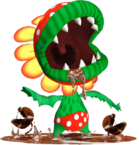 |
Petey Piranha is mutant Piranha Plant from Super Mario Sunshine. He appeared twice in that game, once in New Super Mario Bros., and appears semi-regularly in spinoffs. He can fly and spit muddy goop, among other things. His head is similar to that of Dino Piranha, Fiery Dino Piranha, and Peewee Piranha from later games. | |
| King Boo | ||
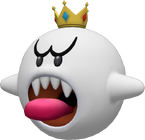 |
King Boo is a large, crowned Boo who debuted in Luigi's Mansion as the main antagonist and Luigi's arch-nemesis. Since then, he would make frequent appearances in spinoffs and eventually make his Super Mario series debut in Super Mario 64 DS (under the name Big Boo), where he appears as the boss Mario must defeat in order to free Luigi. He would not make his second mainstream appearance until Super Mario Bros. Wonder, where he appears during certain Wonder Effects. | |
| Cosmic Mario and Cosmic Clones | ||
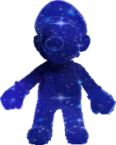 |
Cosmic Mario is a dark blue entity shaped like Mario from Super Mario Galaxy. He looks similar to Shadow Mario, but Mario must race him for the star. He is capable of many of Mario's moves. If the player is using Luigi, Cosmic Luigi will appear instead, and use more shortcuts. In Super Mario Galaxy 2 and Super Mario 3D Land, similar creatures called Cosmic Clones appear. However, they follow Mario or Luigi's exact movements, which can be troublesome if one needs to hold still for a moment or cross a previously-walked path. | |
| Pom Pom | ||
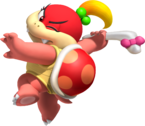 |
Pom Pom is a partner to Boom Boom who often appears on airships and trains where she must be battled. She uses throwing-based projectile weapons to attack, and can slam down while spinning in her shell. She can also teleport and copy herself with ninja hand signs. | |
| Broodals | ||
 |
The Broodals are a group of rabbit wedding planners in Super Mario Odyssey, whose group name seems to be a portmanteau of "brood," "bridal," and possibly "brutal." Bowser hires them to arrange the wedding between him and Peach, and to stop Mario when he tries to stop the wedding from happening. Their boss is Madame Broode, an obese red-clad rabbit with a pet Chain Chomp, while their leader is Topper, the squat Broodal in green attire. The other Broodals are Spewart (in blue), Rango (in yellow), and Hariet (in purple). | |
Friendly species
| Species | ||
|---|---|---|
| Image | Brief biography | First appearance |
| Toads | ||
 |
Toads are the major residents of the Mushroom Kingdom and many other parts of the Mushroom World; most are loyal subjects of Princess Peach. Unlike the Toads that serve as playable characters, these non-playable Toads usually bring assistance to Mario and co. in their adventures like hosting the Toad Houses mini-games to earn power-ups or extra lives. In their original appearance in Super Mario Bros., many Toads were transformed into inanimate objects like bricks by Bowser's black magic, while seven important Toads were held kept captive at the end of castle levels. Some Toads seen in Super Mario Bros. 3 seem to serve the kings of each world. In Super Mario 64, Toads were imprisoned within Peach's Castle's walls and paintings, providing some hints to Mario when finally found. A group of six Toads accompanied Mario and Princess Peach on their vacation on Isle Delfino in Super Mario Sunshine. The Toad Brigade was introduced in Super Mario Galaxy, where each member was given a distinctive personality. In Super Mario Run, winning rallies awards the player with numerous Toads to habitate the player's kingdom. | |
| Subcons | ||
 |
Subcons are peaceful fairy-like folk in Super Mario Bros. 2. They reside in and protect the dream world, Subcon. | |
| Yoshis | ||
 |
Yoshis are a species of friendly dinosaur-like creatures native to Yoshi's Island. Originally, only three colored Yoshis were introduced in Super Mario World: Green, Red, Blue, and Yellow. Except for the green one, each colored Yoshi has an unique ability when they swallow a Koopa shell. While it seems Yoshis may be invaluable on their own unless commanded by Mario, they have proved otherwise in many games of the series like in Super Mario World 2: Yoshi's Island, where a group of them agreed on taking Baby Mario on a journey to rescue his captured brother. Regular Yoshis reprise their ridable role in games like New Super Mario Bros. Wii and its sequel, New Super Mario Bros. U. | |
| Piantas | ||
 |
Piantas are a species of palm-like humanoids originally residents of Isle Delfino. | |
| Nokis | ||
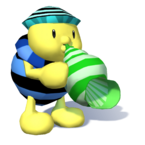 |
Nokis are a race of mollusk-like beings who originate from Isle Delfino as well. | |
| Lumas | ||
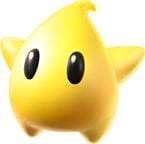 |
Lumas are star-like creatures that first appear in Super Mario Galaxy. | |
| Sprixies | ||
 |
Sprixies are fairy-like creatures appearing in Super Mario 3D World. They are the inhabitants of the Sprixie Kingdom, ruled by the seven Sprixie Princesses. | |
| Poplins | ||
 |
Poplins are inhabitants of the Flower Kingdom in Super Mario Bros. Wonder. Several of them gift Wonder Seeds to the heroes, while others operate shops. | |
| Talking Flowers | ||
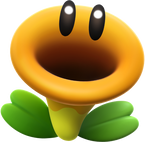 |
Talking Flowers are inhabitants of the Flower Kingdom in Super Mario Bros. Wonder. They are small flowers that talk to the player when approached. The messages they say are small reactions to what is currently ongoing in the level, which may serve as hints. | |
Common and recurring enemies and obstacles
| Species | |||
|---|---|---|---|
| Image | Brief biography | First appearance | Relatives in the series |
| Goomba | |||
 |
Goombas are shiitake-like creatures that were once members of the Mushroom Kingdom, but turned traitor and defected to Bowser's legions when he attacked. They are the most basic and common enemies in the Super Mario games, serving as very easily defeated standard enemies (they can be defeated with a single jump). They appear in the vast majority of games; however, Super Mario Bros. 2, Super Mario Land, Super Mario World, and Super Mario Sunshine do not feature Goombas, with their role being given to the Goombo in Super Mario Land and the Strollin' Stu in Super Mario Sunshine. Super Mario World features the related Galoomba, but they are tougher. |
| |
| Koopa Troopa | |||
 |
Koopa Troopas belong to the turtle-like Koopa race that Bowser himself leads. Their key gameplay characteristic is that they retreat into their shells when jumped upon, or in some cases, get knocked out of them. They are the among the most basic and common enemies (only Goombas are more ubiquitous) in the franchise, being particularly numerous in the 2D sidescroller games. They were originally depicted as quadrupedal, but starting with Super Mario World, they begin to walk on two legs, with some exceptions, like in Super Mario Galaxy. Typically, green ones will walk off ledges they come to, while red ones turn away from them. While sometimes simply known as "Koopas," not all Koopas are Koopa Troopas. | ||
| Koopa Paratroopa | |||
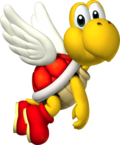 |
Koopa Paratroopas are Koopa Troopas with wings. With some exceptions, the green ones either hop along or move left and right, while the red ones fly up and down. The rare yellow ones in Super Mario World instead chase Mario on foot, and will jump over obstacles. Jumping on them causes them to lose their wings. | ||
| Piranha Plant | |||
 |
Piranha Plants are carnivorous plants that often live in pipes, although they are also found planted in the ground, especially in the 3D games. Normally, they cannot be jumped upon, but this is not the case in the 3D games after Super Mario 64. |
| |
| Cheep Cheep | |||
 |
Cheep Cheeps are fish that are typically depicted with wing-like fins and mohawks, although there has been some variation. While they normally swim or jump, their exact behavior may vary drastically by game or even within the same game. | ||
| Blooper | |||
 |
Bloopers, formerly Bloobers, are white squid-like creatures that usually follow Mario through the water with dangerous speed and accuracy. The ones of Isle Delfino instead travel on land near water, and spit ink, and die if they fall in the water. | ||
| Lakitu | |||
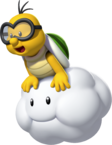 |
Lakitus are cloud-riding Koopas that drop Spiny Eggs, which become Spinies upon hitting the ground. In some games, the cloud can be ridden in after they are defeated. | ||
| Spiny Egg | |||
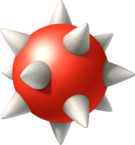 |
Spiny Eggs are dropped by Lakitus and become Spinies when they hit the ground. There is also a green type that doesn't hatch and a kind that turns into Piranha Plants. | ||
| Spiny | |||
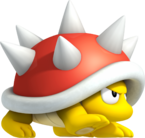 |
Spinies are small, spiked Koopas that cannot be jumped upon. They are dropped by Lakitus as eggs, though some can be found in other places, such as upside down in caves. | ||
| Buzzy Beetle | |||
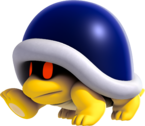 |
Buzzy Beetles are small yet tough Koopas that are immune to fire, and tend to live in caves. They sometimes crawl on ceilings, in which case they will drop when Mario and Luigi come nearby. | ||
| Hammer Bro | |||
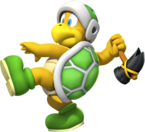 |
Hammer Bros. are Koopas that are commonly found in pairs, and tend to jump while throwing an endless supply of Hammers. | ||
| Bullet Bill | |||
 |
Bullet Bills are ammunition that usually travel in a straight line. In some of the 3D games, they will follow Mario, a behavior that is similar to the Bull's-Eye Bills in the 2D games. | ||
| Bill Blaster | |||
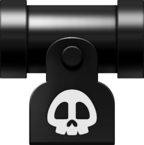 |
Bill Blasters are two-sided cannons that shoot Bullet Bills. They are usually emblazoned with a skull. In Super Mario 64 and Super Mario 64 DS, they are gray cubes with a scrap metal-like texture and only one cannon. Super Mario 64 is notable for having only one of these enemies in the entire game; it is located at the beginning of the staircase to the top of Whomp's Fortress. Super Mario 64 DS, however, adds another in a new area behind Whomp's Fortress, as well as some in Dire, Dire Docks. | ||
| Lava Bubble | |||
 |
Lava Bubbles, formerly Podoboos, are balls of fire that leap out of Lava. Starting in Super Mario World, their design sometimes includes eyes. | ||
| Fire Bar | |||
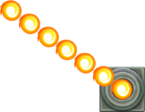 |
Fire Bars are rows of fireballs rotating around blocks. Their length varies greatly, and are commonly found in castle levels. | ||
| Wind | |||
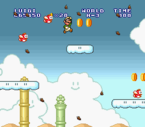 |
Wind pushes Mario around, potentially into a pit. However, it can also push him out of a pit, or across a gap. It appears in many levels of Super Mario 64, and it makes a notable appearance in World 2-4 of New Super Mario Bros. Wii. | ||
| Shy Guy | |||
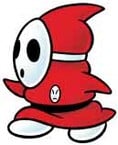 |
Shy Guys are Wart's main troops in Super Mario Bros. 2. They are notable for their amount of derivatives, but have for the most part been relegated to spinoffs, particularly the Yoshi franchise. In Super Mario Bros. 2, the red ones walk off of ledges and the pink ones turn around. The pink ones are blue in the remakes. | ||
| Bob-omb | |||
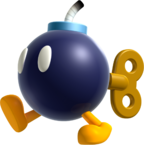 |
Bob-ombs are walking bombs. In some games, they actively chase Mario before exploding; in others, they won't ignite until Mario attacks them. Japanese material typically refers to the Super Mario Bros. 2 ones under a different name, "Bob." | ||
| Pokey | |||
 |
Pokeys are tall segmented cacti. While it has been inconsistent as to whether or not it's safe to jump upon them, the head is usually the weak point. | ||
| Spike Trap | |||
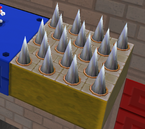 |
Spike Traps are areas of sharp, pointy spikes that can power down the Mario Bros. and can take away health and lives. Spike Traps are either stationary, retractable, attached to a moving object, or any combination of these positions. Yoshi, however, is normally immune to their harmful effects. | ||
| Paragoomba | |||
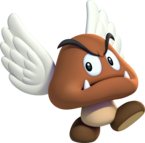 |
Paragoombas are winged Goombas. Some of them jump, some fly back and forth, and others drop parasitic Mini Goombas. Jumping on them causes them to become Goombas. | ||
| Dry Bones | |||
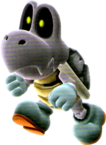 |
Dry Bones are skeletal Koopa Troopas that often appear in castles. When jumped upon, they will temporarily fall apart, putting themselves back together after a few moments. | ||
| Cannon | |||
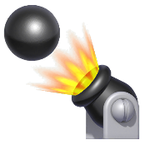 |
Cannons are commonly found on airships and shoot cannonballs. | ||
| Boo | |||
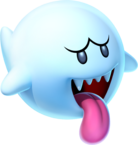 |
Boos, formerly known as "Boo" Diddlys and Boo Buddies, are shy, spherical ghosts that attack only when Mario's back is turned from them due to their shy personalities. | ||
| Thwomp | |||
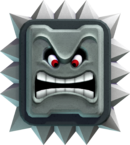 |
Thwomps are floating stone faces that crash down either when Mario gets close, or in a set pattern. | ||
| Chain Chomp | |||
 |
Chain Chomps, sometimes just called "Chomps," are large iron balls that act similar to guard dogs, with chains holding them back. Sometimes they lack chains, commonly rolling around like boulders instead. | ||
| Burner | |||
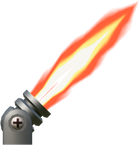 |
Burners, also known as Rocket Engines, are fire-shooting cannons commonly found on airships. | ||
| Rocky Wrench | |||
 |
Rocky Wrenches are depicted either as mole-like Koopas or a possible relative of Monty Mole. Regardless, they hide under manhole cover-like lids and throw wrenches. | ||
| Spike | |||
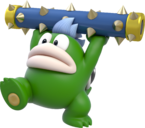 |
Spikes are Koopas that throw an endless supply of spiked balls from their mouths, or spiked rollers in Super Mario 3D World. | ||
| Spike Ball | |||
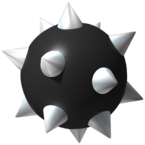 |
Spike Balls are huge metal spheres covered in spikes, and were initially depicted as being thrown by Spikes. Since then, they have appeared independently. | ||
| Falling spike | |||
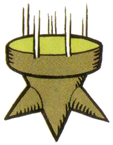 |
Falling spikes are spikes on the ceiling, sometimes stalactites, that fall down. | ||
| Galoomba | |||
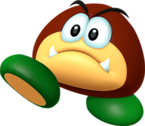 |
Galoombas, formerly "Goombas," are a relative of Goombas that aren't squished by jumping, instead stunning them. In Super Mario 3D World, they can be crushed with a Ground Pound, but not picked up and carried, like in Super Mario World. | ||
| Monty Mole | |||
 |
Monty Moles are creatures that pop out of the ground to either give chase or throw rocks at the player and then quickly hide back underground. | ||
| Chargin' Chuck | |||
 |
Chargin' Chucks are American football-playing Koopas that take multiple hits to defeat. In Super Mario World, they also had a very wide variety of attacks. | (N/A) | |
| Swoop | |||
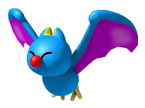 |
Swoops, also known as Swoopers, are bats that often hang from the ceilings of caves, when they see Mario, they swoop down upon him. | ||
| Spinner | |||
 |
Spinners, also known as Ball 'n' Chains, are spiked balls on the ends of chains that swing around in a circle, similar to Roto-Discs. | ||
| Urchin | |||
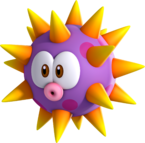 |
Urchins are spiny blue or purple echinoderms that move around by either rolling or floating. | ||
| Magikoopa | |||
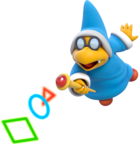 |
Magikoopas are Koopa wizards that can summon other enemies or fireballs with their magic. A notable member is Kamek. | ||
| Fuzzy | |||
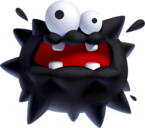 |
Fuzzies are black spiny creatures that usually follow rails in the air. They are not to be confused with the psychedelia-causing creature of the same name. | ||
| Wiggler | |||
 |
Wigglers are cheerful yet easily-irritable caterpillars with flowers on their heads. | ||
| Skewer | |||
 |
Skewers, also known as Spike Pillars, are large spiked beams that shoot out to attack. | ||
| Grinder | |||
 |
Grinders are large saw blades that follow tracks, although even larger versions exist as well. In Super Mario Galaxy 2, they instead cut up Puzzle Plank Galaxy, and in Super Mario Maker, placing them off of a track causes them to simply spin in one place. | ||
| Boulder | |||
 |
Boulders make their first appearance being dug up by Diggin' Chuck. They later appear in various other games, and Mario can even become one with the Rock Mushroom. | ||
| Mechakoopa | |||
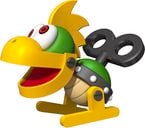 |
Mechakoopas are wind-up toys resembling Bowser. Jumping on them usually causes them to go into a dormant state, where they can be picked up and thrown. | ||
| Maw-Ray | |||
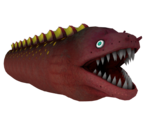 |
Maw-Rays (formerly known as Unagi) are large moray eels that often hide away in caves. Eely-Mouth of Super Mario Sunshine is comparable. | ||
| Amp | |||
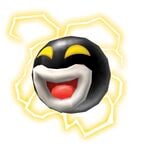 |
Amps are electric spheres that are often found circling things. | ||
| Scuttlebug | |||
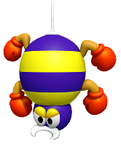 |
Scuttlebugs are spiders that often jump or hang by webs. | ||
| Bully | |||
 |
Bullies are spherical enemies that attack by pushing Mario around. Mario must do the same to beat them. | ||
| Skeeter | |||
 |
Skeeters are water-strider creatures. Their appearance and aggressiveness, along with the effect of jumping on them, has varied. | ||
| Tox Box | |||
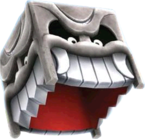 |
Tox Boxes are cube enemies with one hollow side Mario can stand under without getting crushed. The ones in Super Mario 64 and the ones in Super Mario Galaxy have vastly different appearances, as well as slightly different Japanese names. | ||
| Cataquack | |||
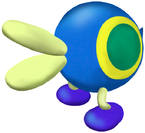 |
Cataquacks are blue creatures resembling both ducks and Wiggler segments, and are native to Gelato Beach. When they see Mario, they will chase him and fling him up in the air, but are unlikely to damage him. In Super Mario Galaxy, they are outright unable to damage Mario, but Mario is unable to defeat them. Also in Super Mario Galaxy, they respawn if they fall in water. Super Mario Sunshine also has an aggressive red type that will damage Mario far easier. | ||
| Volcanic debris | |||
 |
Volcanic debris refers to rocks that fall from the shy after being launched from volcanoes. It is highly destructive, being able to break through any kind of block, and well as set off Kab-ombs. | ||
| Octoomba | |||
 |
Octoombas, formerly known as Electrogoombas, are alien octopuses that attack by headbutting or shooting projectiles. It and its relatives also make up an "Octo-Army" led by King Kaliente and Prince Pikante. | ||
| Pulse Beam | |||
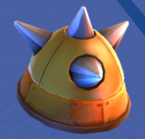 |
Pulse Beams are round laser-using robots, which come in numerous varieties. | ||
| Magmaargh | |||
 |
Magmaarghs are a variant of the Blargg enemy from Super Mario World, and far more common. They either lunge up from underneath lava in an attempt to eat the player, or slowly make their way through the platform they are standing on from the side. | ||
| Biddybud | |||
 |
Biddybuds are variously-colored ladybug-like creatures found marching around in groups, and can be defeated instantly with any attack. | ||
| Stingby | |||
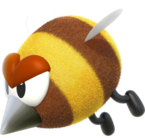 |
Stingbies are bees that chase the player around, attempting to hit them with the stinger on the front. | ||
| Coin Coffer | |||
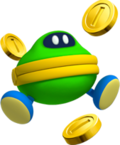 |
Coin Coffers are walking purses that give out coins when attacked. | ||
| Peepa | |||
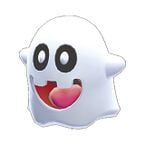 |
Peepas are Boo relatives which move along a predetermined, typically circular path. Unlike Boos, Peepas do not react if the player looks directly at them. | (N/A) | |
Gallery
See also
Names in other languages
| Language | Name | Meaning | Notes |
|---|---|---|---|
| Japanese | スーパーマリオ[?] Sūpā Mario |
Super Mario | |
| Chinese (simplified) | 超级马力欧[?] Chāojí Mǎlì'ōu |
Super Mario | |
| Chinese (traditional) | 超級瑪利歐[?] Chāojí Mǎlì'ōu |
Super Mario | |
| Korean | 슈퍼 마리오[?] Syupeo Mario |
Super Mario |
References
- ^ "The Super Mario Bros. Wonder Game
"This entry in the Super Mario Bros. series of side-scrolling action games debuts just about 11 years after the last side-scrolling entry." – December 20, 2023. "Wonder Flowers are Appearing!" Screenshot. Super Mario Run in-game notification. - ^ Best-selling Video Games. Guinness World Records. (Archived March 17, 2006, 00:55:03 UTC via Wayback Machine.)
- ^ Thomas, Lucas M. (October 3, 2007). Super Mario Bros.: The Lost Levels Review. IGN. Retrieved May 6, 2024. (Archived January 25, 2009, 01:07:51 UTC via Wayback Machine.)
- ^ Official Japanese artwork for the 30th Anniversary of Super Mario Bros. illustrating the games part of the Super Mario series.
- ^ ソフトコレクション | マリオポータル | Nintendo. Mario Portal (Japanese). (Archived February 9, 2019, 09:23:40 UTC via Wayback Machine.)
- ^ a b c The official home for Mario - Super Mario games. Nintendo.com (American English).
- ^ O'Malley, James (September 11, 2015). 30 Best-selling Super Mario Games of All Time on the Plumber's 30th Birthday. Gizmodo. Retrieved August 2, 2022. (Archived September 14, 2015, 17:26:24 UTC via Wayback Machine.)
- ^ "Interview with Shigeru Miyamoto" - Game Informer issue 234. Retrieved September 5, 2016.
- ^ Nintendo Arcade. nintendo.com. Archived September 11, 2007 via Wayback Machine. Retrieved December 23, 2017.
- ^ a b Warner, Silas. Statement by Silas Warner - Programmer on Super Mario's Wacky Worlds. The Black Moon Project. Retrieved May 6, 2024.
- ^ July-August 2000. Big N magazine. Page 19.
- ^ March 1995. Nintendo Power Volume 70. Nintendo of America (American English). Page 29.
- ^ January 2010. Official Nintendo Magazine (UK) Issue #51. Page 62.
- ^ Super Mario 64 II video game. IGN (American English). (Archived August 3, 2002, 15:26:35 UTC via Wayback Machine.)
- ^ Owsen, Dan (January 1998). Nintendo Power volume 104, "Insider Collector's Edition". Nintendo of America (American English). Page 16.
- ^ Super Mario 64 – 1996 Developer Interviews originally featured in the official strategy guides. shmuplations.com. Retrieved September 10, 2018.
- ^ Servo5678 (July 3, 2002). Super Mario 64 2. Everything2 (English).
- ^ Kim, Byungsuk (June 24, 2014). Super Mario 64DD Version Discovered in Japan. Gaming After Hours.
- ^ GameXplain (August 17, 2012). New Super Mario Bros 2: Ending & Credits (Spoilers!). YouTube. Retrieved April 22, 2016.
- ^ ❤Sunny❤ (February 17, 2016). Super Mario 3D Land - Final Boss Battle & Ending. YouTube. Retrieved April 22, 2016.






